Kuldīga’s grand narrative of the Duchy of Courland and Semigallia (summary)
Kuldīga (Goldingen) was first documented in 1242. However, the history of the town most relevant to this nomination commences in the late 16th century with the establishment of the Duchy of Courland and Semigallia. The historic centre of Kuldīga is a compelling reminder of the Duchy’s era of growth and trade in the late 16th, 17th and 18th centuries, when the town was known by the name Goldingen. The Duchy of Courland and Semigallia was an autonomous vassal state under the Polish-Lithuanian Commonwealth, which stretched from the Baltic Sea Coast in a triangular shape around 500km eastwards to the Daugava River, initially bordering the Grand Duchy of Lithuania, Polish Livonia, the Kingdom of Sweden and later the Russian Empire. The dukes of Courland and Semigallia governed this significant part of the Baltics between 1561 and 1795 and left their legacy in the wider geopolitical region.
Kuldīga was the primary residence and administrative centre of Courland’s first ruler Gotthart Kettler after the establishment of the Duchy in 1561. During the co-regency of Gotthart Kettler’s heirs, Kuldīga continued to be the ducal residence and administrative centre of Duke Wilhelm Kettler, who had been given power over Courland in 1596 and ruled until 1616. Kuldīga maintained an important role in the administration of the Duchy during its entire existence and continued to grow as a result. In a 1613 census, Kuldīga was documented to have 175 buildings of tax-payers; 149 buildings were indicated on the oldest existing town map, which was created in 1797. The decrease of buildings can be attributed to a series of fires and floods, which were common occurrences at the time, as well as deterioration following the many vacancies based on the decrease of population numbers after the Great Plague.
The proposed Outstanding Universal Value of Kuldīga is derived from its ability to represent the Duchy of Courland and Semigallia which, despite its small size and problematic position among the larger European powers Poland-Lithuania, Sweden and Russia, developed into a maritime power in the 17th century under the rule of Duke Jacob and established an international trade network that spanned from Europe to the African west coast and the Americas. The Duchy of Courland and Semigallia and with it Kuldīga flourished when it increasingly engaged in international trade and communication. For the purposes of trade activities, the small political entity constructed a fleet of its own with the expertise and technologies of international specialists who came to Courland and often settled in the region, bringing with them the building traditions of their home countries. The duchy had trading contracts and diplomatic relations with the dominant European powers, such as France, England and Russia. At this time, various merchants of the Duchy of Courland and Semigallia personally travelled to destinations such as Germany, the Netherlands, France and Spain by ship to trade a diverse range of local goods (Scheffler 1940, 28). In addition to merchants from Kuldīga travelling within the Baltics and beyond, foreign merchants also came to Kuldīga, including from Russia during the Great Nordic War at the beginning of the 18th century (Scheffler 1940, 32). Travelling merchants were common visitors to the Duchy of Courland and Semigallia, and they even had their personal seating area in St. Catherine’s Church in Kuldīga (Scheffler 1940, 28).
While many of the international visitors left again after completing their business, others stayed and settled in the Duchy of Courland and Semigallia. In Kuldīga alone, people from a minimum of nine different countries are documented to have settled in the town during the ducal era (see Scheffler 1940). While Germans, especially from northern regions of Germany, always made up a big share of citizens in Kuldīga, the variety of cultural backgrounds broadened along with the growing international relations encouraged by the dukes. In the 17th century, new citizens were registered from Austria, Denmark, France, the Netherlands, Scotland, Sweden and Switzerland. In the 18th century, single cases of settlers were additionally registered from Italy as well as Bohemia (Scheffler 1940, 53). In addition to migration from the European continent as well as the Baltic neighbours, an increase also has to be noted for internal migration, with growing numbers of Couronians settling in Kuldīga (ibid). Migration patterns, especially during the 17th and 18th centuries, illustrate two major developments of the Duchy of Courland and Semigallia. Firstly, continuing German immigration along with additional immigration from other European states testifies to the growing importance of the Duchy of Courland and Semigallia, which was considered a place worthy of settling in. Secondly, the increasing internal migration from the territory of the Duchy bears witness to the growing importance of Kuldīga as an urban centre of the Duchy of Courland and Semigallia despite it not being a sea port.
The growing importance of the Duchy of Courland and Semigallia, as well as of the town of Kuldīga, as trading hubs of the 17th and 18th centuries is further highlighted by the records of the occupations of newly arriving citizens. Records in this regard are available for the complete duration of the ducal era. It is striking that whereas only one merchant was registered to have settled in Kuldīga between 1569 and 1599, which is less than 1% of all new residents, this situation changed dramatically over the following centuries. In accordance with the general increase of trading activities of the Duchy of Courland and Semigallia, from 1600 until 1649, 10% of all newly registered citizens in Kuldīga were merchants. In the second half of the 17th century, almost 30% of new citizens were merchants, which represents a high-point of trade-related migration and reinforces that the period under Duke Jacob (1642-1682) was in fact the most prosperous economically. In the following century, the numbers were lower than in the high times at the end of the 17th century, but merchants continued to make up around one fifth of all new citizens, representing the largest occupational group and showing the lasting impact the growing trade has had on the organization of society (Scheffler 1940, 26).
In Kuldīga, local and foreign craftsmen jointly developed a new architectural language in the town, which was inspired by international encounters as well as the availability of new materials based on trade relations set up under ducal rule. The historical urban fabric in Kuldīga includes structures of traditional local log architecture as well as largely outside-inspired techniques and styles of brick masonry and timber-framed houses that illustrate the rich exchange of local craftspeople with travelling craftsmen from other Hanse towns and centres around the Baltic Sea as well as Russia.
During the period of the Duchy of Courland and Semigallia, Kuldīga was essential for the development of crafts in this region and soon established itself as the centre of Courland craftsmanship . The statutes of the guilds established in Kuldīga were also binding for those craftsmen living and working in other towns of the Duchy. As illustrated by the Kuldīga District Museum through a series of movable objects in 2017, the ancient traditions of craft guilds continued to exist until the 1930s (ibid).
The legacy of the Duchy of Courland and Semigallia is further expressed through the variety of intangible heritage expressions that originate from the Duchy of Courland and Semigallia. Broad influences can be found in the culinary heritage of the region as well as in legends, songs and poetry. One of the most prominent legends says that it was during Duke Jacob's reign that potatoes were introduced in Courland. As the duke spent a lot of time in different courts of European rulers, he got acquainted with the plant that is essential for the Latvian cuisine today. It is known that Duke Jacob first ordered the expensive plant for his court from Hamburg, and potatoes later grew in the duke’s gardens. This popular tale of the Latvian people is also celebrated through an art installation organized by the foundation of Imants Ziedonis "Viegli" in cooperation with Kuldīga Municipality on the right bank of the River Venta within the nominated property, where cultural potatoes grow while listening to a special radio station - Potato Field Radio.
Storytelling and the passing down of legends are a significant element of Latvian culture, as the country was among the last countries on the European continent to document legends, stories and songs in writing. Since 2004, Kuldīga has held a storytelling festival where locals and guests enjoy the richness of the oral heritage of the town, including stories from the era of the Duchy of Courland and Semigallia. This represents a general strong interest in folk culture amongst the Latvian people. In 2008, the “Baltic Song and Dance Celebrations” were recognised on UNESCO’s Representative List of the Intangible Cultural Heritage of Humanity. While these celebrations honour the heritage of folk songs and dances, they are closely intertwined with another aspect of Latvian culture, the traditional costumes that are worn at concerts and performances. Every town and village has its own variation of the costume that is part of local identity. The costume worn in Kuldīga includes a particular element that evolved during the Duchy of Courland and Semigallia and which represents the increasing wealth of the small state. In addition to the traditionally woven fabric, women wear large jewellery that represents their status. While this jewellery is not unique to Kuldīga, the town is the only place where the jewellery is made from silver instead of bronze, as this was a special craft skill of Kuldīga craftsmen. This costume, and the knowledge surrounding its origin and fabrication, is a significant element of popular celebrations today, including not only the aforementioned song and dance celebrations, but also more private occasions such as midsummer night or weddings.
Visbeidzot jāpiebilst, ka dažas vispopulārākās Kuldīgas leģendas ir tieši saistītas ar nominētās mantojuma vietas materiālo mantojumu. Viena no visslavenākajām leģendām ir radusi taustāmu izpausmi ēkā Baznīcas ielā 17. Tiek uzskatīts, ka 1702. gadā pie pilsētas birģermeistara viesojās un viņa mājā nakšņoja Zviedrijas karalis Kārlis XII (Dirveiks et al. 2013, 304). Šīs leģendas vēstījumu vēl uzsver šajā ēkā patrepē iebūvēta lāde, kas, kā apgalvots, esot piederējusi Zviedrijas karalim (Dirveiks et al. 2013, 306). Pētnieki noraida šīs leģendas patiesumu, taču šis nostāsts ir populārs vietējo iedzīvotāju vidū un ilustrē to, kā hercogistes ziedu laiki, kad šeit ciemojās augstu stāvoši ārzemju viesi, tiek reproducēti vietējās leģendās un nostāstos. Cita ēka, kura joprojām šodien ir pazīstama ar savu hercogistes laika funkciju, ir unikālā daļēji no koka būvētā ēka Baznīcas ielā 10, kas līdz pat šai dienai bieži tiek saukta par “Hercoga aptieku” (Dirveiks et al. 2013, 304).
In conclusion, Kuldīga comprehensively illustrates the complete narrative of the expansion of urban spaces in the context of 16th to 18th century growth and offers tangible evidence of the unique integration of all aspects of urban and societal development within an impressively compact, largely uninterrupted area. It provides vivid testimony of the duchy’s interaction with relevant contemporary political powers and tangibly manifests the traditions of the Duchy of Courland and Semigallia. Kuldīga functions as a key carrier of the legacy of the Duchy of Courland and Semigallia, as it successfully preserved a meaningful stage of societal development that articulates in the architectural language of the town as well as in the craft skills performed until today. As a consequence of the many wars that were fought on Latvian territory since the 18th century – during its existence, the Duchy of Courland suffered 81 years of war with neighbouring powers and 110 years of famine (Jākobsone 2013, 32) –, no other place can compare to the volume of attributes of Outstanding Universal Value found in this property.
Detailed chronological accounts of Kuldīga’s history
History preceding the period relevant for the Outstanding Universal Value
The earliest known settlement which can be linked to modern Kuldīga was located about three kilometres downstream from the Old Town, at a place called Veckuldīga (“Old Kuldīga”) Castle Mound and dates to as early as the second half of the late Iron Age (9th –12th centuries) (Asaris, Lūsēns. 2013, 139). During this time, the region south and west of the Daugava River was inhabited by several tribes that centuries later became the foundation of the Latvian nation: the Curonians, the Semigallians, and the Selonians (Berkis 1969, 2).
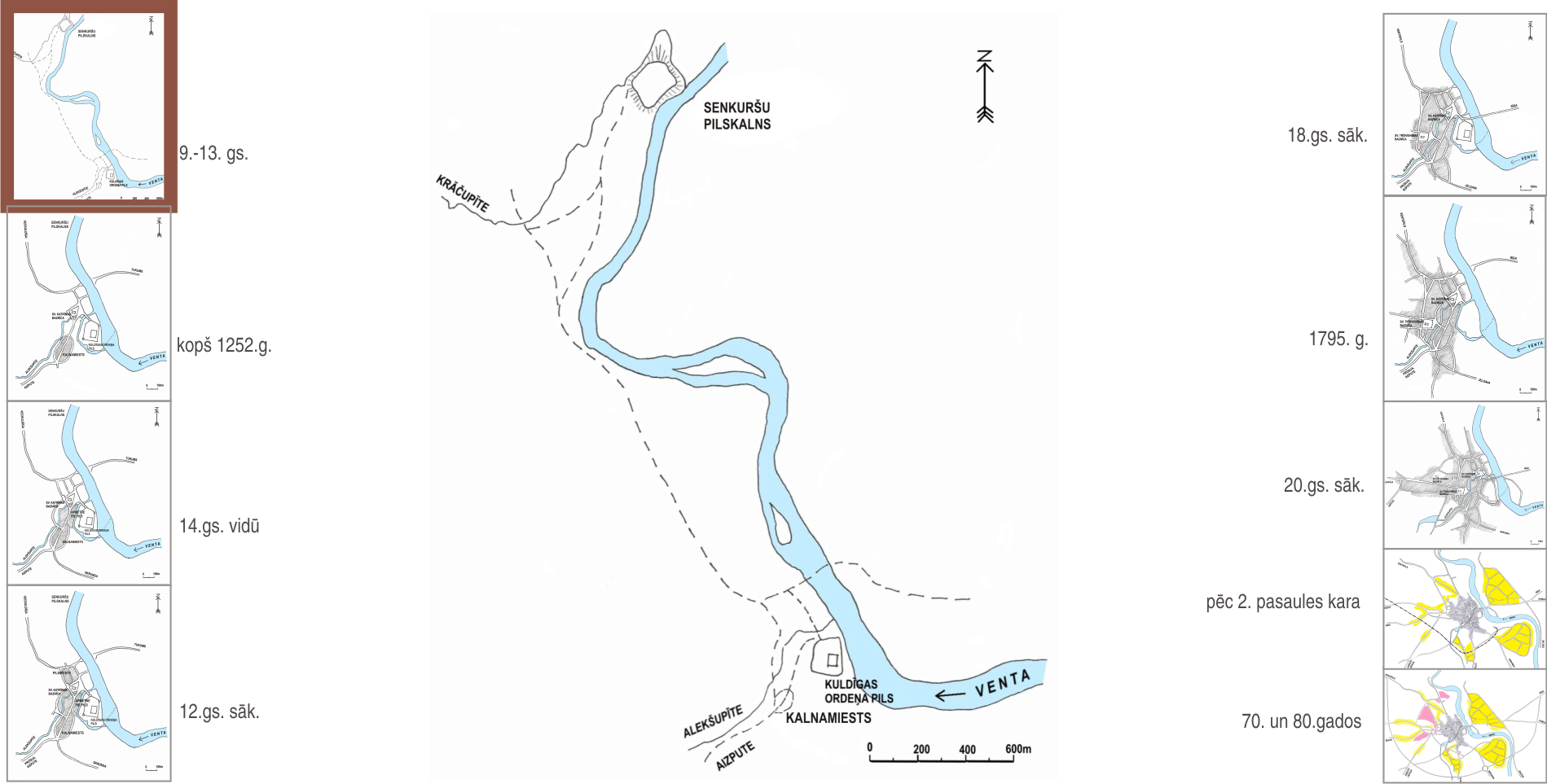
Localisation of the castle mound of ancient curonians in relation to the localisation of the Kuldīga castle. Schematic representation by Jana Jākobsone, Aldis Orniņš, 2012.
Schematic representation by Jana Jākobsone, Aldis Orniņš, 2012. In accordance with the general European situation, this period of history of the Baltics was dominated by the eastward expansion of the Christian faith. After initial peaceful attempts of Christianisation since the 1180s had proven unsuccessful, the Catholic Church decided to pursue its aim by military means (Sarnowsky 2012, 32-33). In 1202, Pope Innocent III confirmed the legitimacy of the Order Frates Milicie Christi de Livonia, better known as the Order of the Sword Brothers, which had the task to support the bishop of Livonia in the conquest of the Baltic region. In 1237, after a major defeat in battle the year before, the order was incorporated into the Teutonic Order by decree of Pope Gregor IX (Sarnowsky 2012, 33). Until 1290, the Teutonic Order – in the form of its Livonian branch – managed to conquer the territory occupied today by the modern state of Latvia. However, the Order did not own all of this territory, but divided it with the Livonian bishoprics, the bishopric of Courland and the archbishopric of Riga. This division of Courland and Semigallia shaped the development of many settlements and towns, and also had a lasting impact on the Duchy of Courland and Semigallia.
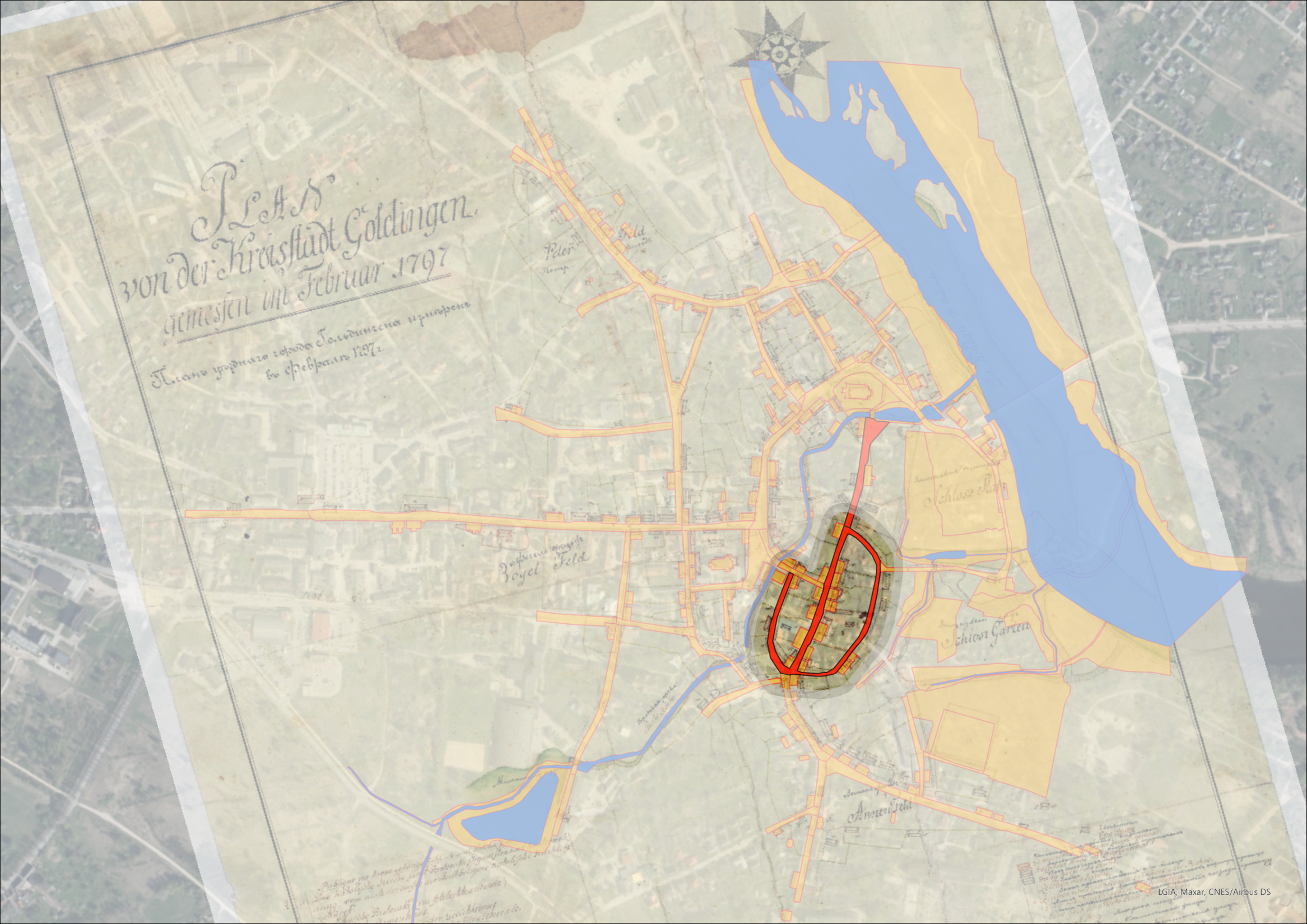
Territory of Kalnamiests (Mountain Hamlet) – the earliest settled area. Schematic representation by Inta Jansone according to the research “Kuldīga. Pilsētbūvniecība un arhitektūra”, 2020.
Archaeological excavations took place in Kuldīga for two decades, studying the different cultural layers of the time of the Livonian Order as well as the period of the Duchy, facilitating an understanding of the urban development of the town. Radiocarbon dating in the early 2000s showed that the area known as Kalnamiests (Mountain Hamlet) was populated since the early 13th century, which makes it one of the earliest settled areas of modern Kuldīga (Asaris and Lūsēns 2013, 150). The same research further identified pavement surfaces from the 17th century in this area, proving that the medieval hamlet was later integrated in the early settlement of the Duchy of Courland and Semigallia (ibid). Kalnamiests lies at the centre of modern Kuldīga. It consists of the three ielas Kalna Iela, Rumbas Iela and Jelgavas Iela and has an iconic shape that distinguishes it from the rest of the town. Still today, these roads give the impression of the small settlement Kuldīga comprised of at the time. The ielas have a particular oval shape that cannot be found elsewhere in the town. The entire territory of Kalnamiests lies on the eastern bank of Alekšupīte river, about 200 metres inland from Ventas Rumba waterfall.
In the course of its mission, in the following 200 years, the Teutonic Order built many castles to fortify strategically important locations and routes, for example, the trade route from Riga to Königsberg (today: Kaliningrad). These castles oftentimes formed the nucleus of settlements, many of which became towns during the Duchy of Courland and Semigallia, including the town of Kuldīga.
The beginnings of Kuldīga, which was called Goldingen at the time, date back to 1242, when the Papal Legate Wilhelm of Modena gave the Livonian Branch of the Teutonic Order permission to build a castle in order to protect Christianity, similar to other locations in the region (Asaris et al. 2013, 17). The location of the castle was chosen due to its strategic position between Livonia and Prussia, which gave the Teutonic Order the necessary control over the opposing political actors of the time (ibid, 11). Its territory comprises the left bank of the Venta River, north-east of Kalnamiests. The castle itself was separated from the settlement by a moat and its territory was further limited by the Alekšupīte in the north and the Venta in the east. For much of the time under the rule of the Livonian Order, Kuldīga retained the urban layout and volume of a medieval settlement. The castle as the official beginning of the town existed next to the settlement.
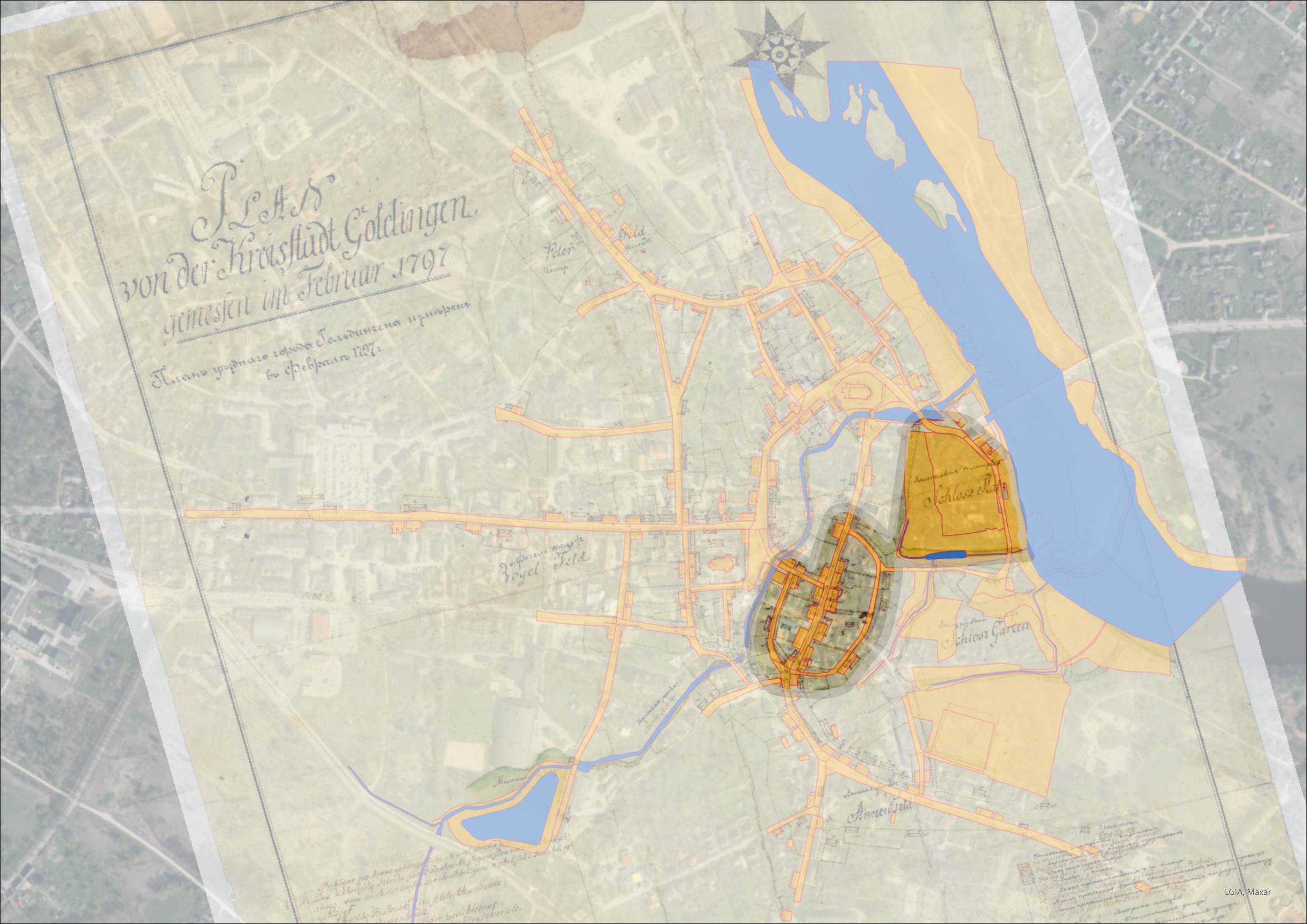
Territories of the Kalnamiests (1) and castle (2) – the autonomous settled areas. Schematic representation by Inta Jansone according to the research “Kuldīga. Pilsētbūvniecība un arhitektūra”, 2020.
The first mention of Courland on a world map dates to the time of the Teutonic Order. The Monialium Ebstorfensium Mappamundi, a historic world map created by the monk Gervase of Ebstorf in the 13th century, is considered to be the oldest account of the territory of modern Latvia and mentions Riga, Courland and Semigallia (Zālīte, 2020).
Already in the 14th century, the then hamlet of Kuldīga joined the activities of the Hanseatic League and started to engage in international trade. In 1378, ten years after joining the Hanseatic League, Kuldīga first obtained city rights (Jākobsone 2013, 32).
During this time, a series of urban expansions succeeded in different stages, when the area north of the castle territory was developed. In the course of this development, the first elements essential for the functionality of an organized town, such as a market square and a church, evolved (Scheffler 1940, 5). This was the first time that Kuldīga expanded outside of the area surrounded by the two rivers. Alekšupīte no longer constituted the northern limitation of the settlement. Instead, the river was now flowing right through the centre of the town and the first bridges were built. Across from the Alekšupīte, on the opposite bank of the entrance to the castle, the first town square was created in front of St. Catherine’s Lutheran Church, which was built as the first church of Kuldīga. In this context, Baznīcas Iela was constructed, which connected from the town square past the church south to Kalnamiests, and hence integrated both areas into one administrative system. In the north, five more ielas were added in the area called Pilsmiests (Castle Hamlet). Today, four of these ielas exist, namely Policijas Street, Ventspils Street, Kalku Street and Upes Street.
The foundation of the Duchy of Courland and Semigallia under Gotthard Kettler
In the history of Europe, the 16th century was a time of great shocks, which also had a direct impact on the territory of present-day Latvia. In the 1520s, the ideas of the Reformation started to spread in Livonia, quickly gaining adherents not only among town dwellers, but also the clergy. At the same time, the struggle for dominance in Livonia between the two main Livonian lords – the Livonian Master of the Teutonic Order and the Archbishop of Riga - intensified. The neighbouring countries – which at this time were undergoing processes of the opposite nature to Livonia, i.e. the centralisation of power and striving towards hegemony in the region – hurried to exploit Livonia’s internal instability. A decisive impetus for changes in the region was the Livonian War (1558–1582), which started with the invasion by the Russian Tsar Ivan IV (the Terrible) into the Bishopric of Dorpat. Since Livonia was unable to offer serious resistance to the troops of the Russian Tsar, its residents sought aid from the closest neighbours, and as a result, in early June 1561, the northern part of Estonia, including Reval (today: Tallinn), accepted the supremacy of King Eric XIV of Sweden. The rest of Livonia came under the lordship of King Sigismund II Augustus of Poland-Lithuania, however, different Livonian territories had different degrees of subjugation to him. In the course of diplomatic negotiations, the Master of the Livonian branch of the Teutonic Order, Gotthard Kettler, managed to acquire the former Order’s lands to the south of the Daugava River – in Courland and Semigallia – transforming him into a worldly prince with the title of a duke. The foundation of the new vassal state – the Duchy of Courland and Semigallia (Ducatus Curlandiae et Semigalliae), shortened as the Duchy of Courland – was based on the so-called Subordination Treaty (Pacta Subiectionis), which was concluded in Vilnius on 28th November 1561.
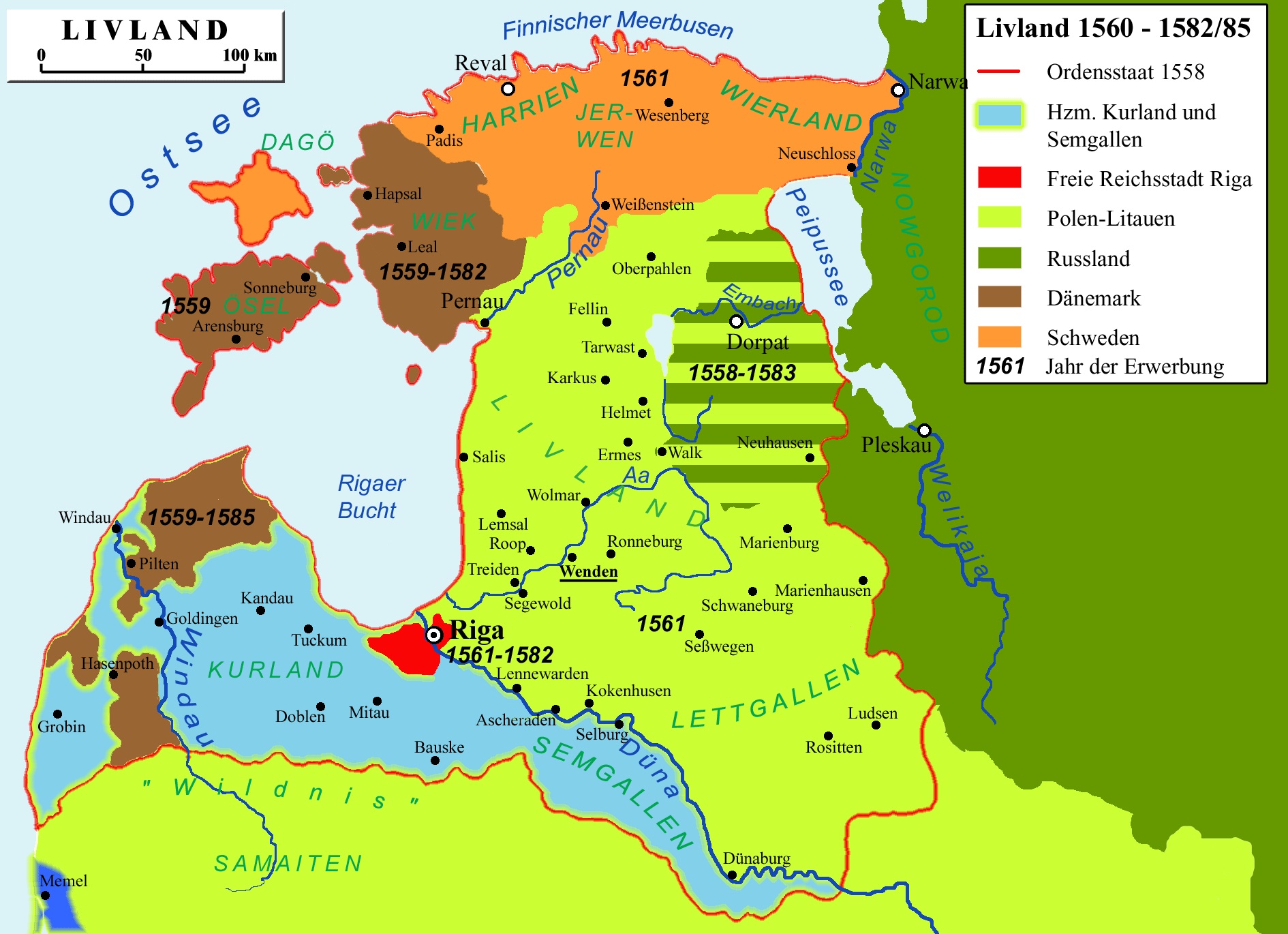
Territorial division of Livonia in the 16th century. Provided by Mārīte Jakovļeva, 2020.
The Duchy of Courland merits attention by the fact alone that it was the only formation, which under the new conditions, represented local statehood in the territory of former Livonia. In compliance with the Subordination Treaty, Sigismund II Augustus granted the former Order’s properties in Courland and Semigallia as a hereditary fief to Gotthard Kettler. By this treaty, the King guaranteed his new vassal state religious freedom with respect to the Augsburg Confession, confirmed that only the indigenous Germans had the right to occupy administrative positions (the Indigenat) and pledged the preservation of all the existing landlords’ rights and privileges. The duke’s official title was: By the Grace of God the Duke of Courland and Semigallia in Livonia (Von Gottes Gnaden in Liefland zu Curland und Semgallen Herzog). In terms of his rank and regalia, the Duke of Courland stood in the same category as the Duke of Prussia who had become a vassal of Poland-Lithuania in 1525, following the secularisation of the Teutonic Order in Prussia. The Duke of Courland owed to his suzerain the same amount of vassal’s service, i.e. military duties, as the Duke of Prussia. Following the medieval traditions, both the Duke of Prussia and the Duke of Courland had to get their suzerainty reconfirmed by receiving diplomas of ducal investiture at the Royal Court each time a ruler of the duchy or Poland-Lithuania changed. Pacta Subiectionis also stipulated that the inheritance of the Duchy of Courland was allowed only through a direct male line, for which reason in 1566, Gotthard married the Duke Albrecht VII of Mecklenburg’s (1486–1547) daughter Anna (1533–1602), thus laying foundation for the Kettler dynasty. The securing of succession was vitally important for the continued existence of the Duchy as in 1589 the Sejm passed a resolution according to which, upon the end of the Kettler male line, the Duchy could be abolished and its territory annexed to the Grand Duchy of Lithuania. In this regard, the Duchy of Courland differed from that of Prussia, the inheritance right of which was extended also to the collateral lines of the House of Hohenzollern that resulted in the merging of the Duchy of Prussia with the Margraviate of Brandenburg in the early 17th century.
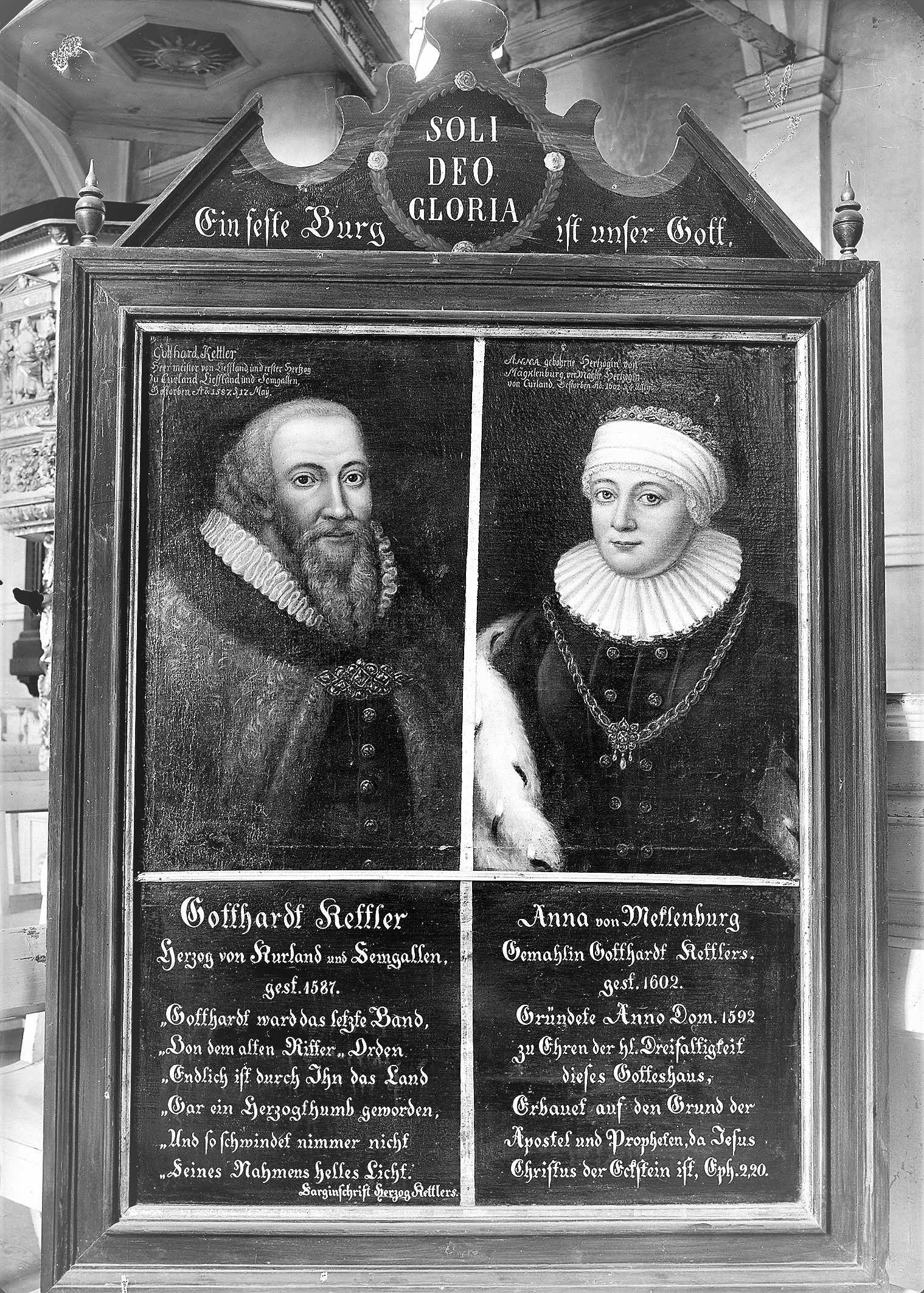
The first duke of Courland and Semigallia Gotthard Kettler (1517-1587) and his wife Anna, Princess of Mecklenburg (1533–1602). Epitaph at Jelgava Trinity Church. The epitaph was lost during the World War II. Provided by Mārīte Jakovļeva, 2020.
After the official secularization of the Livonian branch of the Teutonic Order on 5th March 1562, Gotthard Kettler started to develop his power and administrative system. While on the local level the administrative system was largely inherited from the Middle Ages, the highest administrative apparatus had to be built on a completely different foundation since it was no longer a clerical but a secular state. In contrast to the Middle Ages, when the state served religion, the Early Modern Period came with a new approach: religion became one of the political tools of the state, the ruler’s authority was based on “the Grace of God” and he was the Head of the Church. By the Subordination Treaty, the King of Poland had recognised the Lutheran faith as the official religion of the Duchy of Courland and under Gotthard’s supervision the organisation of the evangelical Lutheran Church took place. The Church helped to consolidate the duke’s authority and became a uniting link between the landlords and the duke. Furthermore, under the conditions of the Livonian War, Gotthard tried to keep in his possession the territories granted to him and to ensure the integrity of the duchy. These efforts could succeed only if the duke managed to make the nobility his allies.
The former Order’s vassals formed the leading estate in the duchy – the landlords. The privilege issued by the King of Poland on 28th November 1561 (Privilegium Sigismundi Augusti), as well as the privilege signed by Duke Gotthard on 25th June 1570 (Privilegium Gotthardinum) confirmed full landlords’ jurisdiction over their peasants. Landlords were exempt from taxes, however, they owed the duke military service (the so-called cavalry service – Rossdienst). These privileges in practice turned the fiefs, which had been granted during the Order’s time, into private properties. Thus, approximately two thirds of the duchy’s land came into private hands, while the remaining one third remained at the duke’s direct disposal and formed state property, the income of which was used to sustain the ducal court and civil service.
The most important political, economic and legal matters were reviewed in the diets of the duke and landlords, called landtags, to which, in contrast to the Livonian times, the representatives of the clergy and towns were no longer invited. In the landtag, the towns were represented by the duke and his councillors, to whom the town dwellers submitted their complaints and views on the relevant issues before the respective landtag session. The decisions made at the landtag carried the force of law. Already during the time of Duke Gotthard, foundations were laid for the administrative apparatus of the duchy that centred around the ducal court. In the court, there were concentrated the main officials and institutions related to the state power and administration: the duke’s councillors, chancellery and the highest economic governance body, the treasury, called Rent-Cammer or fürstliche Cammer. At the local level, ducal authority was represented by captains, called Hauptmann, who governed the castle districts that had been formed during the Livonian period, as well as stewards of ducal manors. Towns received from the duke privileges and order or police regulations (Polizey-Ordnung), which were based on the old Lübeck-Visby-Rīga laws.
At this point, Kuldīga consisted of various districts with different functions, such as the castle territory, the medieval Kalnamiests area and the new district developing around St. Catherine’s Lutheran Church, which was the focal point of public functions within the town. The existing districts were combined under a joint legal and economic system.
One of the oldest documents regulating the construction of buildings in Kuldīga dates back to 1577, just 16 years after the establishment of the Duchy of Courland and Semigallia. A conserved Police Order illustrates that already in the 16th century official building regulations were read out to the public in Kuldīga once every year (Melluma 2015, 134). With regard to the development of restoration policies, two sections of this document are particularly interesting. Section 13 stated that it was illegal to build “in the market-place, next to and between ielas without permission of the town council” (Melluma 2015, 135). Those who acted in contradiction of this law had to pay a penalty or the illegally built houses were to be demolished. Section 14 furthermore added the aspect of deterioration and building alterations. In order to prevent a problematic state of conservation of the overall town, the town council was granted permission to inspect private buildings and plots whenever considered necessary (Melluma 2015, 135 f.).
Two of the oldest buildings of the town, Saint Catherine’s Lutheran Church as well as Holy Trinity Roman Catholic Church, were renovated multiple times during the period of the Duchy of Courland and Semigallia. As they are the major religious buildings of the town, they are important elements of the life of a small town and hence were made a priority of conservation early on.
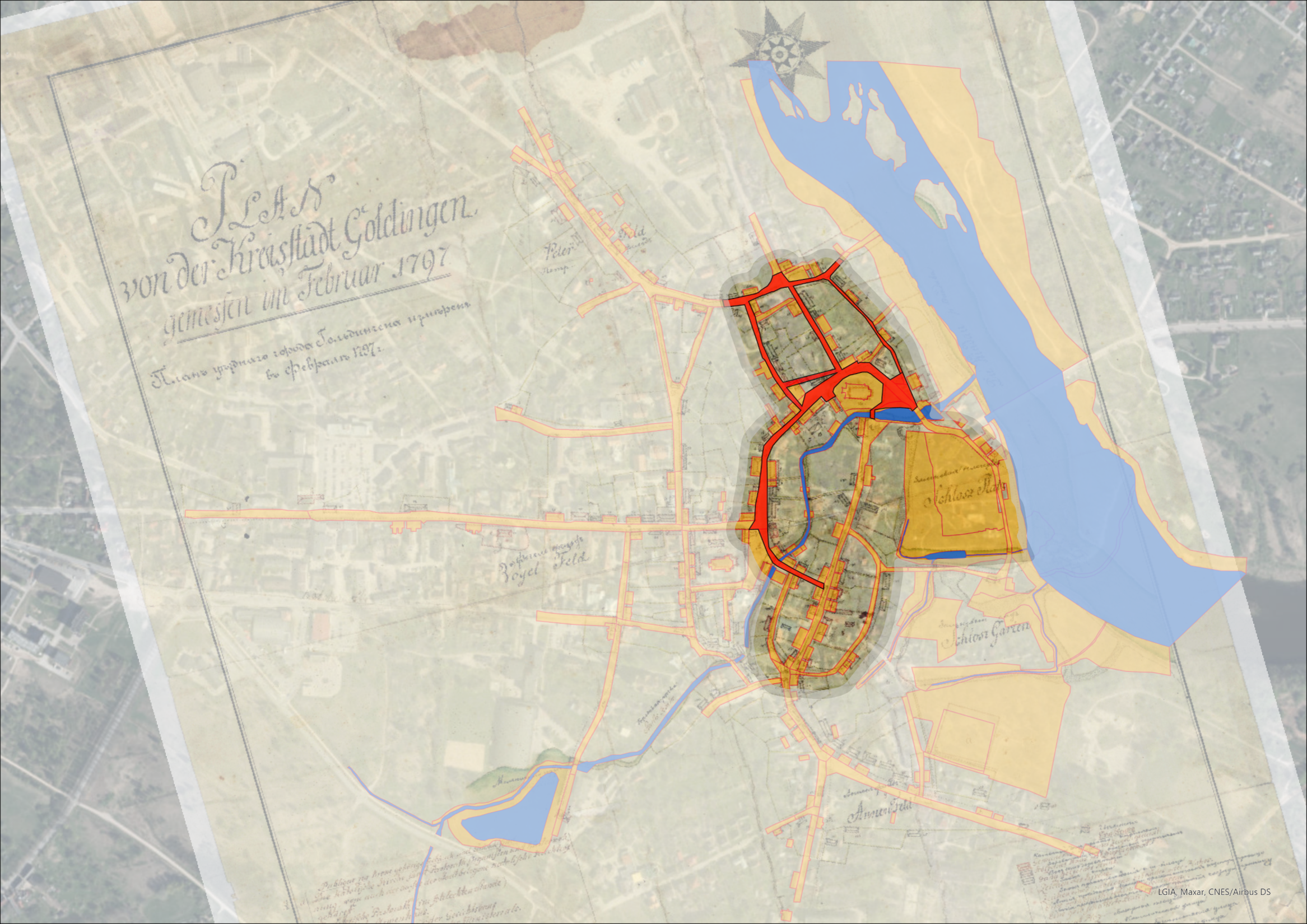
Territories of the Kalnamiests (1), castle (2), settlement at the castle and Pilsmiests (Castle Hamlet)(3) – autonomous parts of the town before administrative merger. Schematic representation by Inta Jansone according to the research “Kuldīga. Pilsētbūvniecība un arhitektūra”, 2020.
The shared rule of Friedrich and Wilhelm Kettler
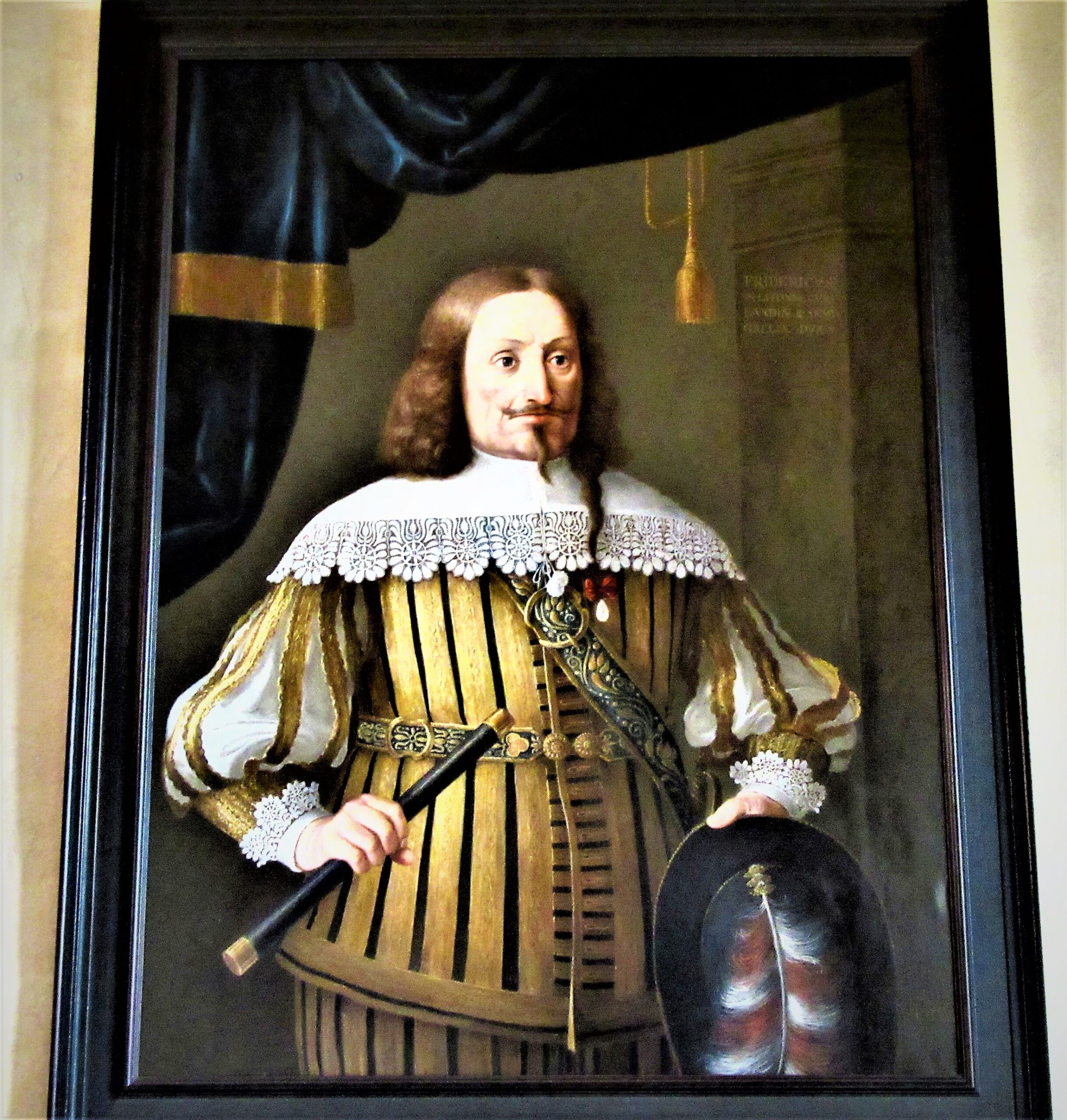
Duke Friedrich. A portrait painted by Imants Lancmanis according to samples of the 18th century, at Bauska Castle Museum. Provided by Mārīte Jakovļeva, 2020 Nodrošinājusi Mārīte Jakovļeva, 2020.
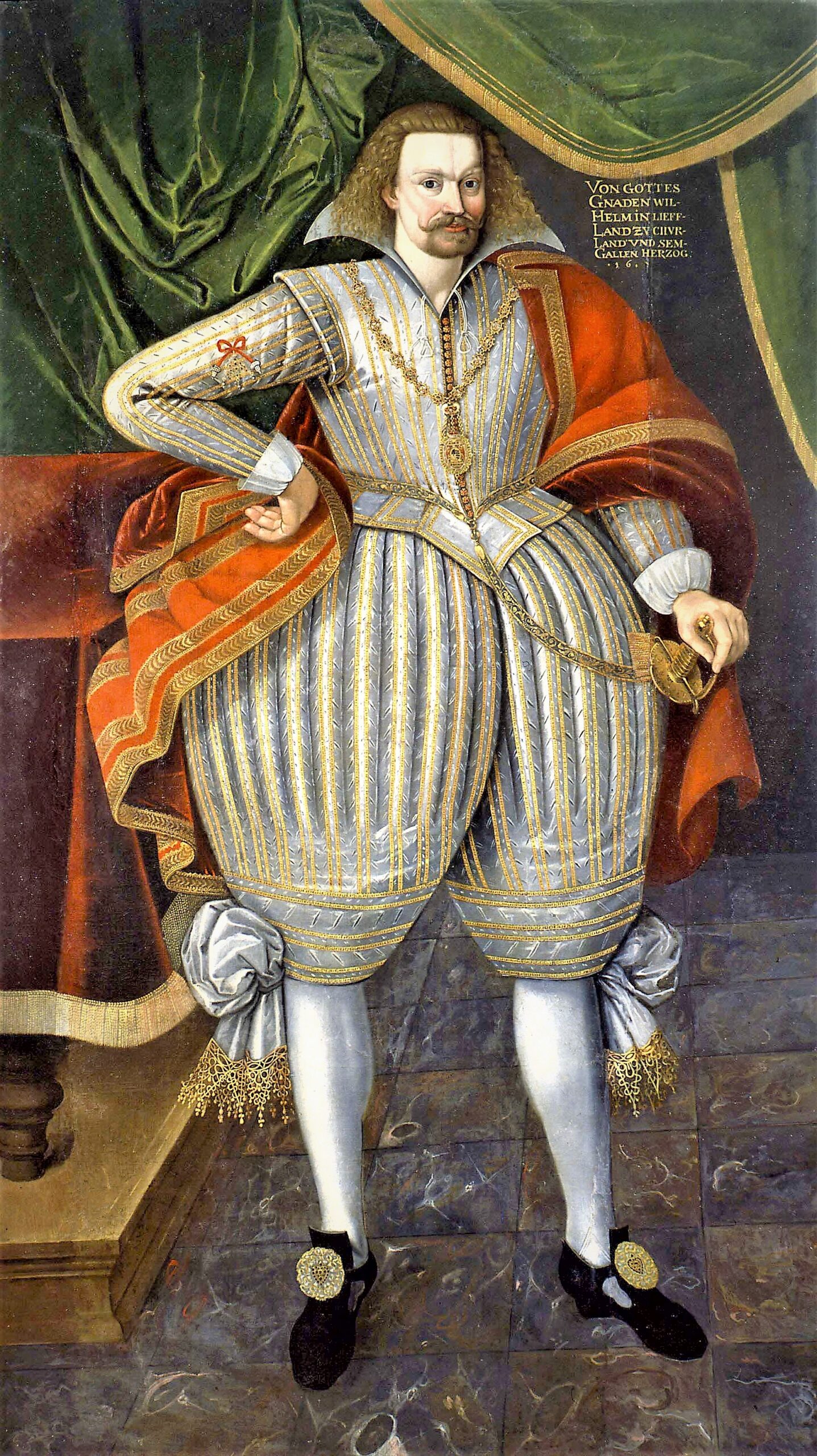
Duke Wilhelm. A painting at Rundāle Palace Museum, 17th century. Provided by Mārīte Jakovļeva, 2020. Mārīte Jakovļeva, 2020.
Being aware of the existing external threats and the unstable internal situation, Duke Gotthard wanted to ensure the continued existence of the new state after his death. Therefore, in his will he left the duchy to his two sons. To his eldest son Friedrich (1569–1642) he bequeathed Semigallia with Jelgava in the centre, which was also the residence of the Dowager Duchess Anna, while his youngest son Wilhelm (1574–1640) received Courland with Kuldīga in the centre. However, the most important provision of the will was the prohibition to divide the duchy into two separate parts, the receipt of the fief, i.e. ducal investiture in the Polish-Lithuanian court had to cover the whole of the duchy’s territory at once. In April 1589 in Warsaw, the King of Poland-Lithuania Sigismund III (1566–1632) confirmed the joint rule of the two brothers over the duchy. Friedrich received the investiture diploma personally, while the minor Wilhelm was represented by his councillors. At the same time, the Polish-Lithuanian Sejm adopted the law that, in case the Kettler dynasty came to an end, allowed Courland-Semigallia to be divided into voivodeships and annexed to the Grand Duchy of Lithuania rather than be granted to a new duke as a fief. This provision of Gotthard’s will turned out to be far-sighted, as his eldest son Friedrich died childless and thus the direct line of Kettler rulers in the Duchy of Courland would have ended already in the second generation.
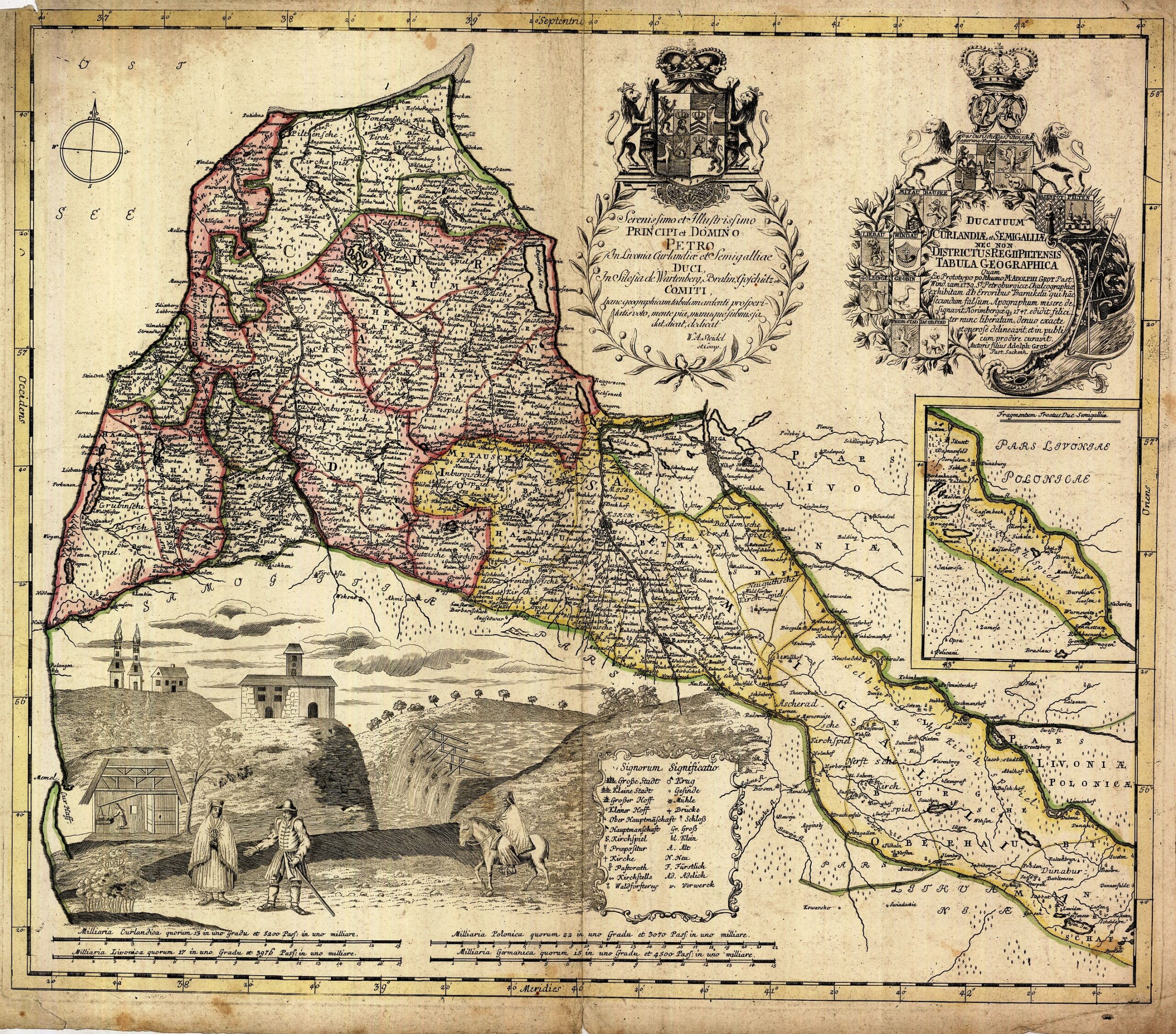
Map of the Duchy of Courland and Semigallia (1770): Courland coloured red, Semigallia – yellow. Map from the Latvian State History Archive, fund ID 6828, description ID 2, case ID 208.
At the time of Duke Gotthard’s death, his youngest son Wilhelm was almost 13 years old. He was sent to Rostock to study until he came of age, which in the will was set at 20 years of age, and there he spent four years. During this time, Wilhelm also maintained close contacts with his mother’s relatives and met many representatives of the ruling houses of Europe. During his brother’s absence, the reins of the duchy were in the hands of Friedrich who was helped by a range of councillors and the dowager duchess. Friedrich received his education locally in Courland, but he also made several prolonged trips to Europe. After Wilhelm’s return from abroad, on 23rd May 1595, the two brothers signed a special agreement on the distribution of power, according to which each of them were to have a separate ducal court, economic administration and lower jurisdiction, however the landtags had to be held jointly, thus asserting the duchy’s territorial integrity. Wilhelm settled in Kuldīga, where he established his ducal court. However, Wilhelm’s attempts to free himself from the landlords’ influence in administrative matters and to introduce an absolutist government were met with fierce resistance and as a result open conflict broke out.
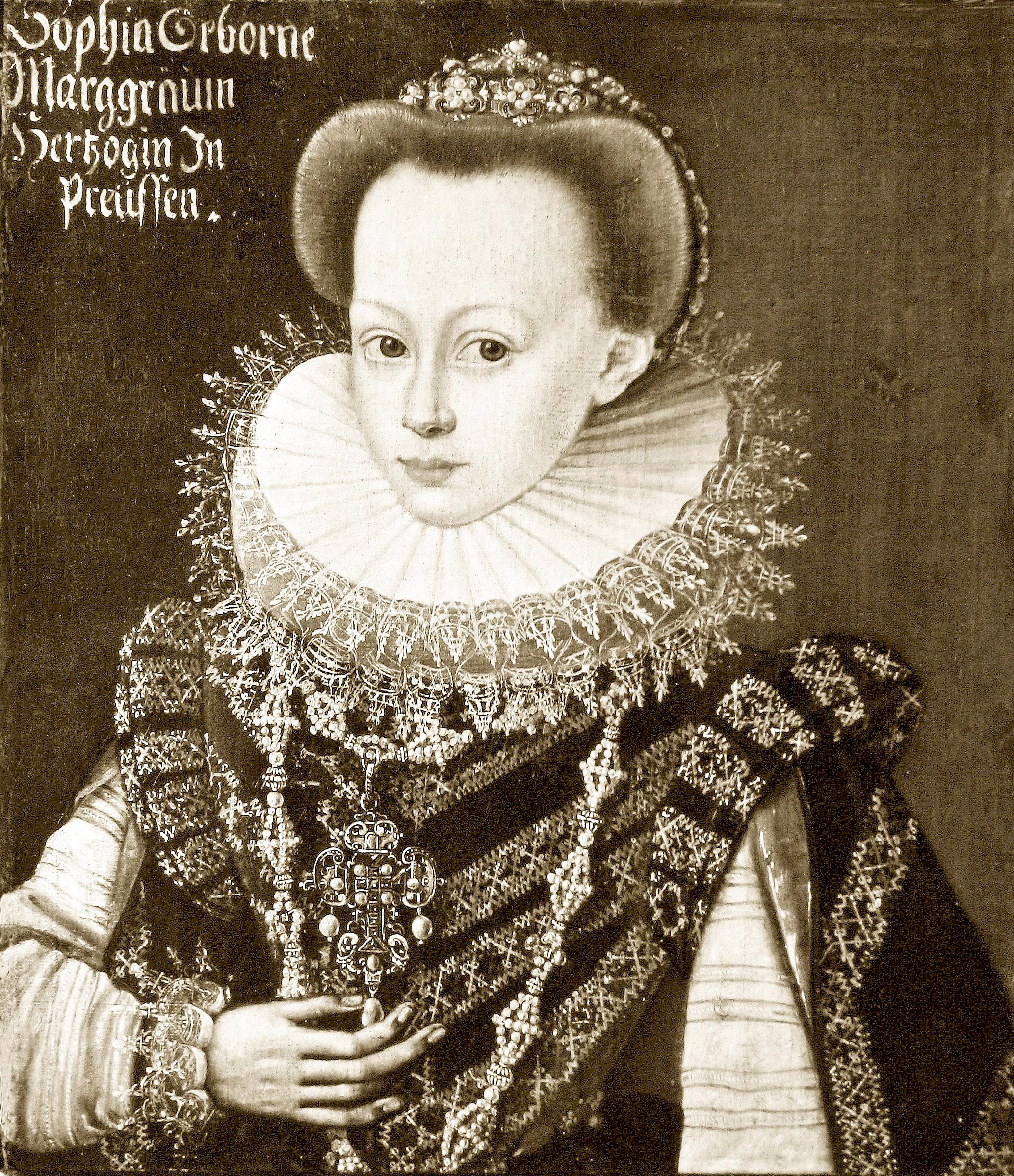
Sofia, Princess of Prussia, wife of Duke Wilhelm. Painting by Daniel Rose at the Rundāle Palace (around 1606). Provided by Mārīte Jakovļeva, 2020.
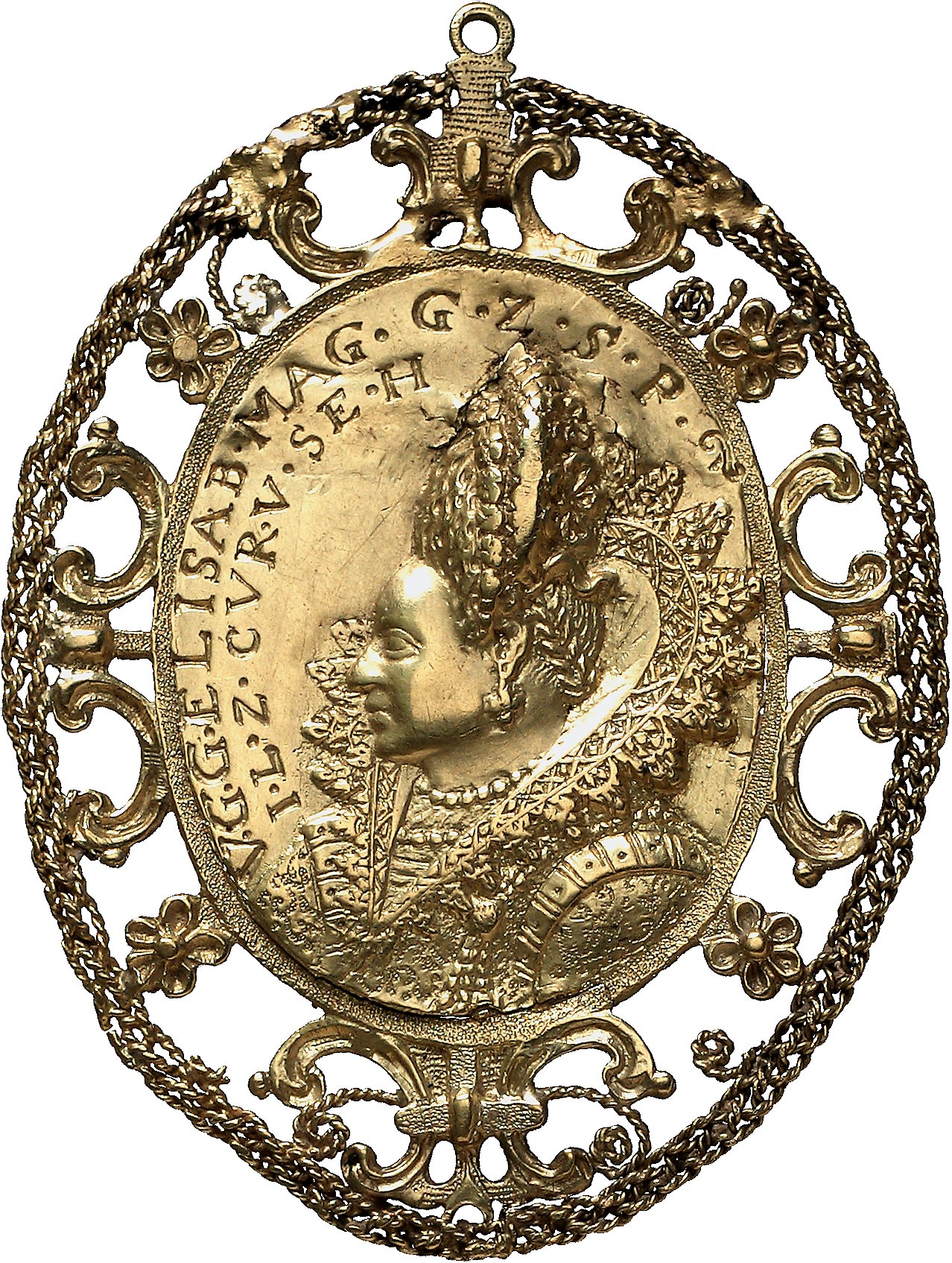
Duchess Elisabeth Magdalene, wife of Duke Friedrich. Golden medallion (1600) in Bode-Museum in Berlin. Provided by Mārīte Jakovļeva, 2020
The two dukes continued to make regular trips abroad, acquainting various courts with the new dynasty and broadening their own horizons. In Wolgast, in 1600, Duke Friedrich married the daughter of Duke Ernst Ludwig of Pomerania-Wolgast (1545–1592), Elisabeth Magdalene (1580–1649). Duke Wilhelm in turn married the daughter of Duke Albrecht Friedrich of Prussia (1533–1618), Sofia (1582–1610). Meanwhile, the peaceful life in the duchy was disrupted by the outbreak of the Polish-Swedish War (1600–1629). In the first phase of the war, the two dukes personally fulfilled their vassals’ duties and the arrival of the unit commanded by Friedrich on the battlefield at Kircholm in September 1605 contributed to the victory of the Lithuanian army over numerically much stronger Swedish troops. Duke Wilhelm also joined the troops several times. Yet, it was only the engagement of Poland-Lithuania and Sweden in the developments in Russia (Smuta) and the Danish attack on Sweden in 1611 that saved the duchy from complete devastation. At the same time, the situation in the duchy continued to heat up. The prudent Friedrich tried to reconcile the conflicting parties, but his efforts failed. The turning point in the history of the duchy was the death of the leaders of the landlords’ opposition during their arrest in 1615. The landlords believed that Wilhelm had explicitly given an order to kill them and that Friedrich had been informed, thus they submitted a complaint against the two dukes to the King of Poland Sigismund III. The king deposed the two dukes. As a result, Wilhelm lost his ducal rights and had to go into exile in Pomerania, while Friedrich with great effort managed to justify himself and preserve the entirety of the Duchy of Courland and Semigallia under his authority. However, the landlords had gained the upper hand as attested by the constitution of the duchy, called the Formula of Government (Formula Regiminis), which was proclaimed on 18th March 1617. The Formula of Government dictated the political system, limiting the ducal authority in favour of the landlords, and remained in force until the liquidation of the duchy in 1795.Formula Regiminis). ”Valdības formula“ noteica valsts iekārtu, ierobežojot hercoga varu par labu muižniecībai, un palika spēkā līdz pat hercogistes likvidācijai 1795. gadā.
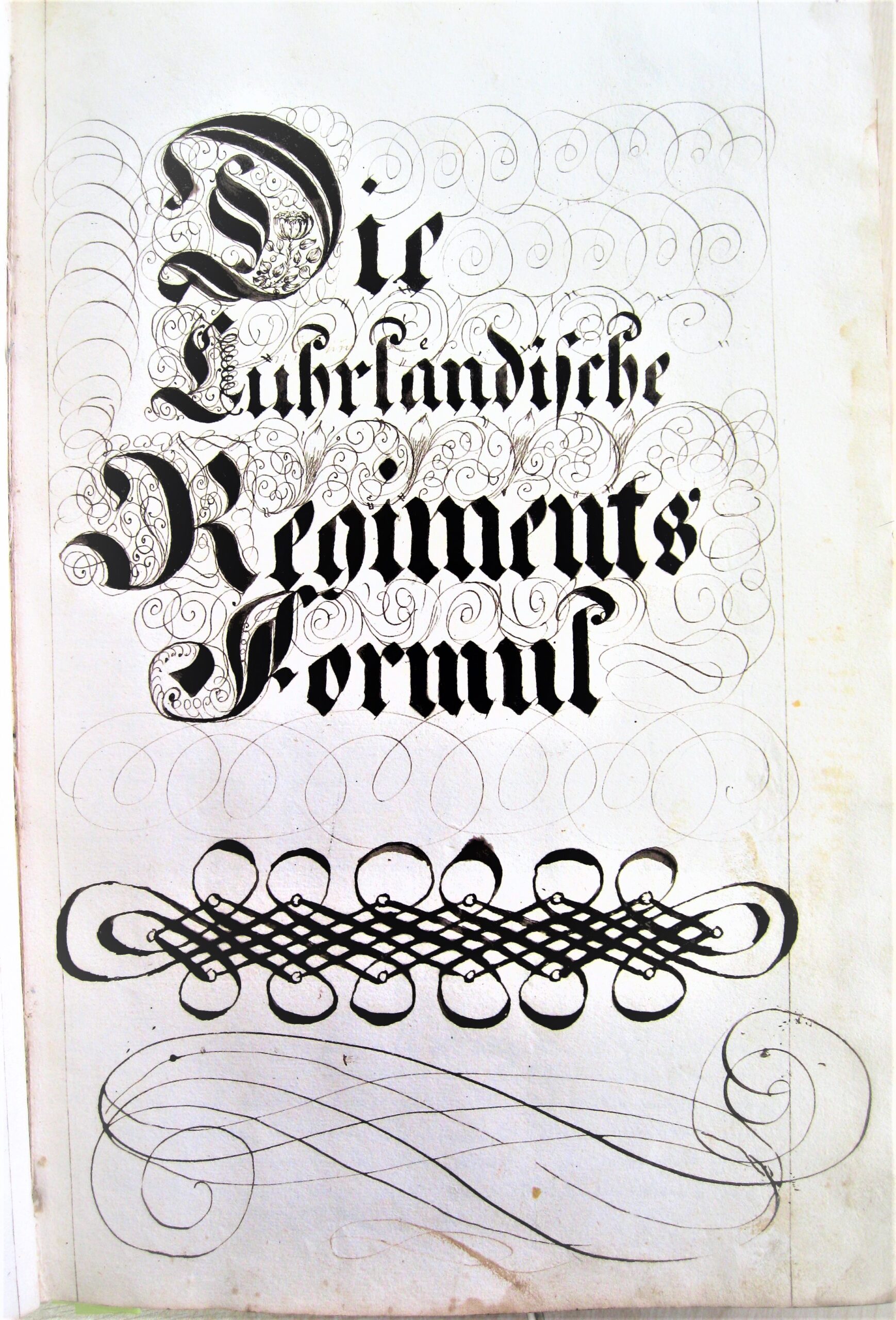
Cover of “the Formula of Government” (Formula Regiminis). Duplicate of the 18th century. Latvian State History Archive, fund ID 5759, description ID 2, case ID 155.
The Formula of Government abolished the institution of ducal councillors and henceforth the government of the duchy consisted of four senior councillors (Oberräte): Landhofmeister, chancellor, Oberburggraf and land marshal. They could be appointed only from among the representatives of the local families listed in a special nobility register, called Adelsmatrikel. The duke was not allowed to make any important political decision without the approval of the Oberräte, especially if the matter concerned the landlords’ rights and privileges. In case of the duke’s absence, minority, illness or death, the board of the senior councillors were to assume the governance of the duchy. Administratively, the duchy was divided into Kuldīga, Tukums, Jelgava and Sēlpils supreme captain’s districts (Oberhauptmannschaften) and these – into the so-called political parishes (politische Kirchspiele). Apart from that, there were also eight captain’s districts (Hauptmannschaften) in the duchy. The captains’ and supreme captains’ positions also were reserved for the representatives of the noble families listed in the Adelsmatrikel, that called themselves ‘the true nobles’ (vera Nobiles) or the knights (Ritterschaft). Duke Wilhelm’s supporters naturally were not admitted into this corporation. Furthermore, ‘the Formula of Government’ stipulated that the landtags of the duchy had to convene at least once in two years. While previously any landlord could take part in the diet, now the participation was reserved only to representatives from among the privileged nobility and each political parish had one vote. The decisions made at the previous landtag sessions lost the force of law. The constitution also demanded the introduction of the Gregorian calendar, i.e. the ‘new style’ in the duchy, starting from 1st January 1618. The adoption of ‘the Formula of Government’ meant the approval of an aristocratic system of government in the duchy, in practice mirroring the processes that took place also in Poland-Lithuania, i.e. the weakening of the king’s central authority and the growth of the magnates’ influence. Regrettably, the Duke of Courland lacked strong backing and opportunities, such as were enjoyed, for example, by the Duchy of Prussia which was eventually annexed to the lands of the Elector of Brandenburg and became the base for the Hohenzollern kingdom. The Duke of Courland likewise did not dare to seek support from among the masses of the local population, which mostly consisted of the Latvians, the bulk of whom were attached to the land as serfs, only relatively few enjoying their personal freedom. The Latvians constituted the economic foundation of the duchy, working in agriculture, fishing, crafts, retail trade, etc., yet they had no political rights.
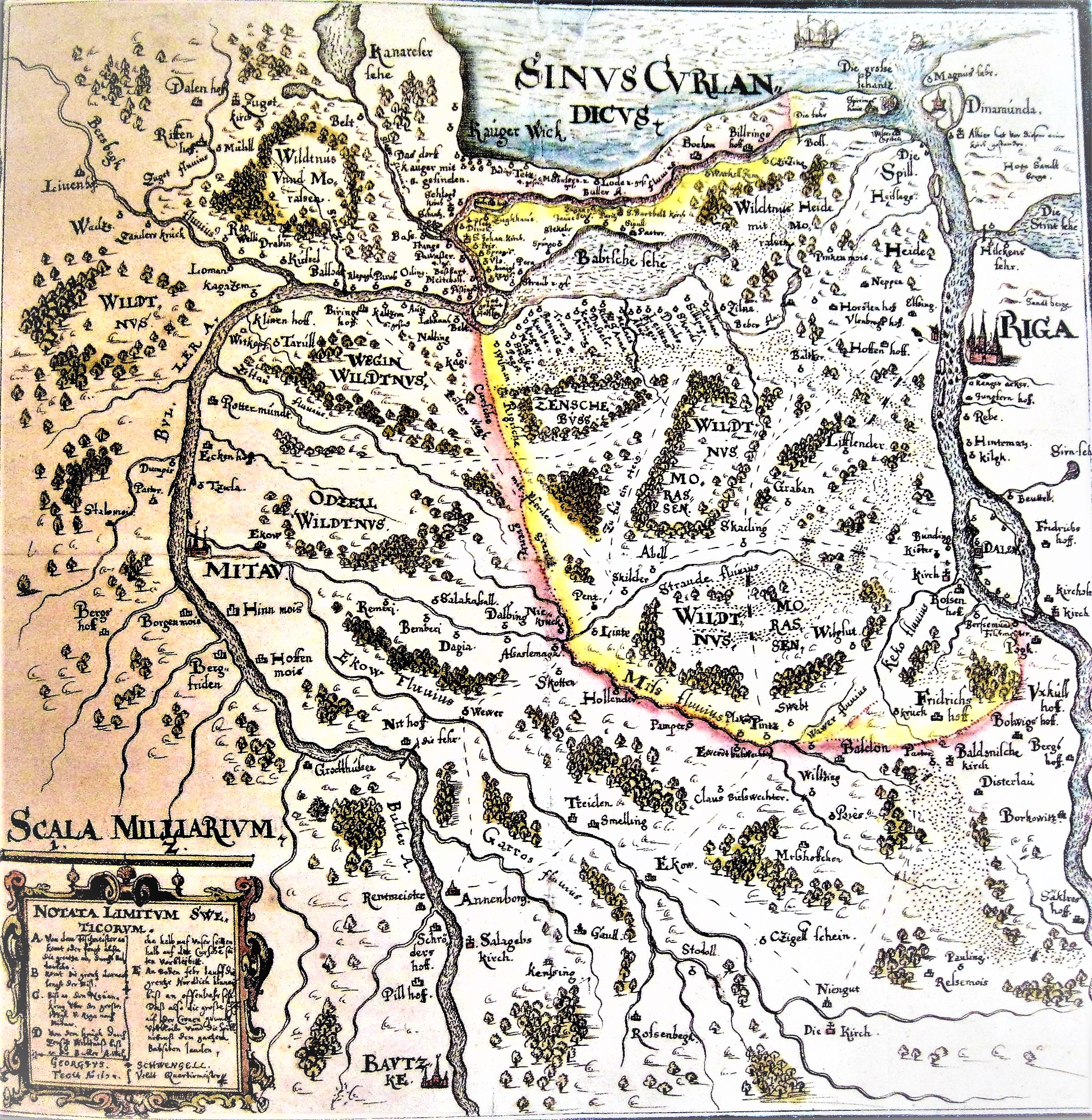
Border of the Duchy of Courland and Semigallia and Sweden at Rīga. Map drawn by Georg Schwengeln (1634). Provided by Mārīte Jakovļeva, 2020.
The settlement of the internal conflict did not mean that all threats to the continued existence of the duchy as such were averted. In 1621, warfare resumed in the Baltic. In September, the Swedes took Riga and in October entered the Duchy of Courland and occupied Jelgava Palace. Polish troops arrived in the duchy at the same time. Almost a year later, Duke Friedrich regained his palace, but in the summer and autumn of 1625, the Swedes again occupied part of the duchy. The prolonged war forced Duke Friedrich to seek non-military solutions for the protection of the duchy by trying to secure for it the status of a neutral state. Negotiations for the recognition of the duchy’s neutrality lasted for several years and the two warring parties periodically made promises to abstain from warfare in the territory of the duchy, but these promises were seldom kept. The Courlanders also made efforts to reconcile Poland-Lithuania and Sweden. It was largely thanks to the diplomatic efforts of Courland that at Christmas of 1628 a truce was signed, which in September 1629 was extended by six years and in 1635 by another 26 years. As a result of the war, the duchy acquired a new neighbour – Sweden. In the summer of 1630, the Swedes forced Duke Friedrich to sign a special border treaty, by which the former kept several territories in the lower reaches of the Daugava River which previously had belonged to the duchy.
The reign of Duke Jacob
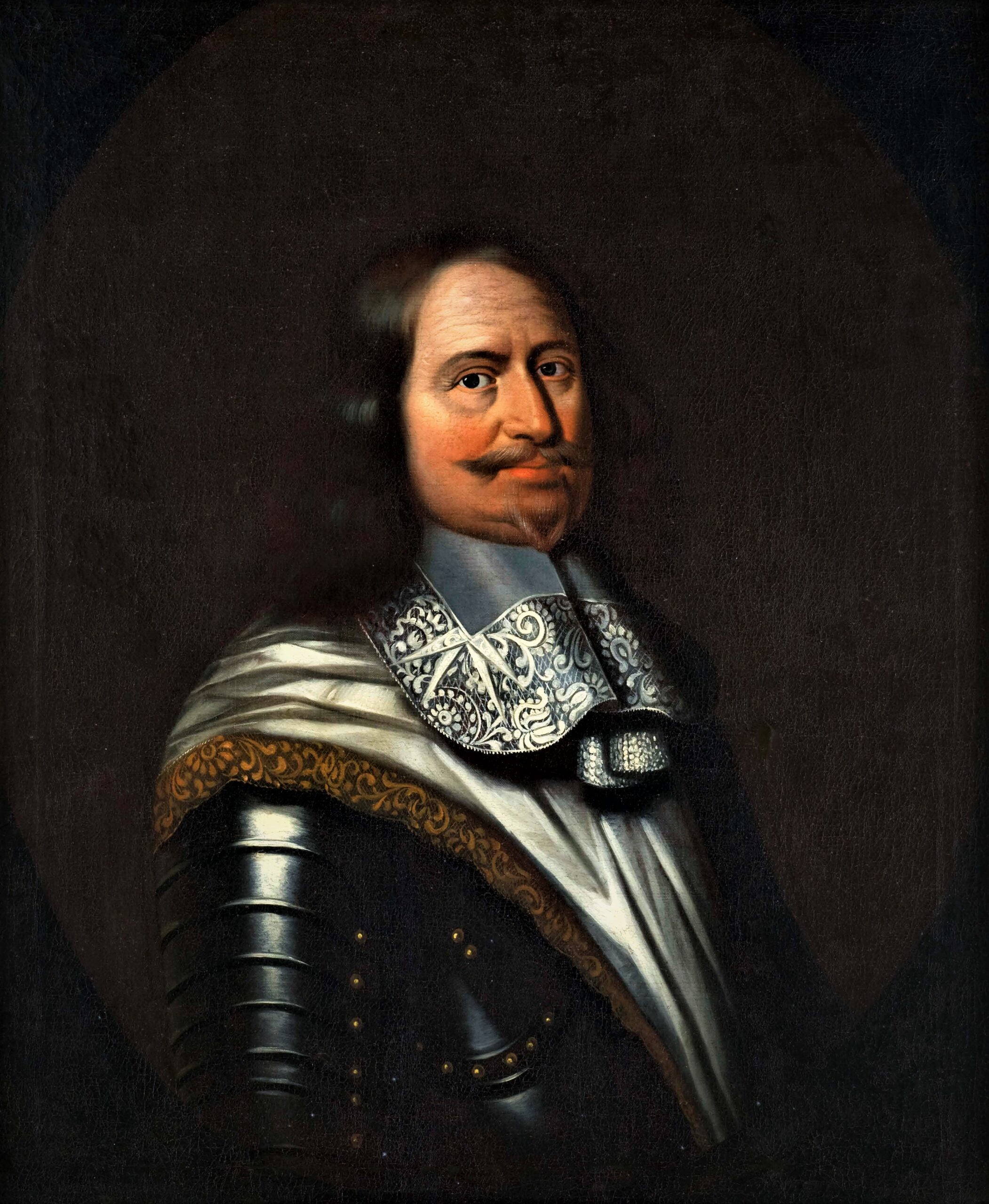
Duke Jacob. Painting at the Gripsholm Castle in Sweden (1670-ies). Provided by Mārīte Jakovļeva, 2020.
Another problem which threatened the existence of the Duchy of Courland was the succession to the throne. There were no children in the marriage between Duke Friedrich and Elisabeth Magdalena, and after his father was deposed Duke Wilhelm’s only son Jacob (1610–1681) had lost any right to the throne. Thus, for the Kettlers to be able to continue ruling in the Duchy of Courland, Wilhelm’s restitution or at least the recognition of Prince Jacob’s succession rights on the part of Poland-Lithuania had to be achieved. In this matter, Friedrich received support from the majority of the duchy’s landlords who were satisfied with their position and did not wish Courland to be incorporated into the Polish-Lithuanian Commonwealth after Friedrich’s death or annexed to Sweden, where royal authority was strong. The efforts to win the succession rights for Jacob, who had been named in honour of King James Stuart of England and Scotland (1566–1625), went on for more than 20 years. Only in 1632, after the death of King Sigismund III of Poland, thanks to family contacts and support from Brandenburg-Prussia, Pomerania, Mecklenburg, Saxony, England and even France, as well as the influential Radzivill clan from Poland-Lithuania, the Polish-Lithuanian Sejm declared the restitution of Wilhelm and Jacob’s rights. The new King of Poland Władysław IV (1595–1648), who ascended to the throne in November 1632, accepted it, but only on condition that Wilhelm would never return to Courland.
Since the mother of Wilhelm’s son Jacob, princess Sofia died soon after giving birth to him, at the age of two he was sent by his father to live with his relatives in Germany. Jacob spent his childhood at the Königsberg and Berlin courts and studied for several semesters at Leipzig University. In 1624, Duke Friedrich summoned Jacob to Courland to prepare him for eventually becoming a duke and in 1638 appointed him co-ruler. Before that, Jacob had spent two years on a gentleman’s tour. During this time, he visited his father, who lived in Pomerania until his death, stayed in Holland and France for longer periods as well as travelled to several other European countries. In the 1630s, Duke Friedrich handed Wilhelm’s former dominions over to Jacob, including Kuldīga, which, in spite of all the developments and political changes, still maintained the status of the capital of a part of the Duchy of Courland.
After Friedrich’s death in 1642, Jacob took over as ruler of the Duchy of Courland and Semigallia. Ascending to the throne on 29th November 1642, he had to conclude a special reconciliation agreement with the landlords, clarifying a few issues pertaining to the organisation of government. Among other things, it was stipulated the henceforth Jelgava would be the only capital of the duchy. Although Kuldīga lost its capital status, the duke still liked to stay there. On the demand of Poland-Lithuania, Jacob had to build Catholic churches in Kuldīga and Jelgava.
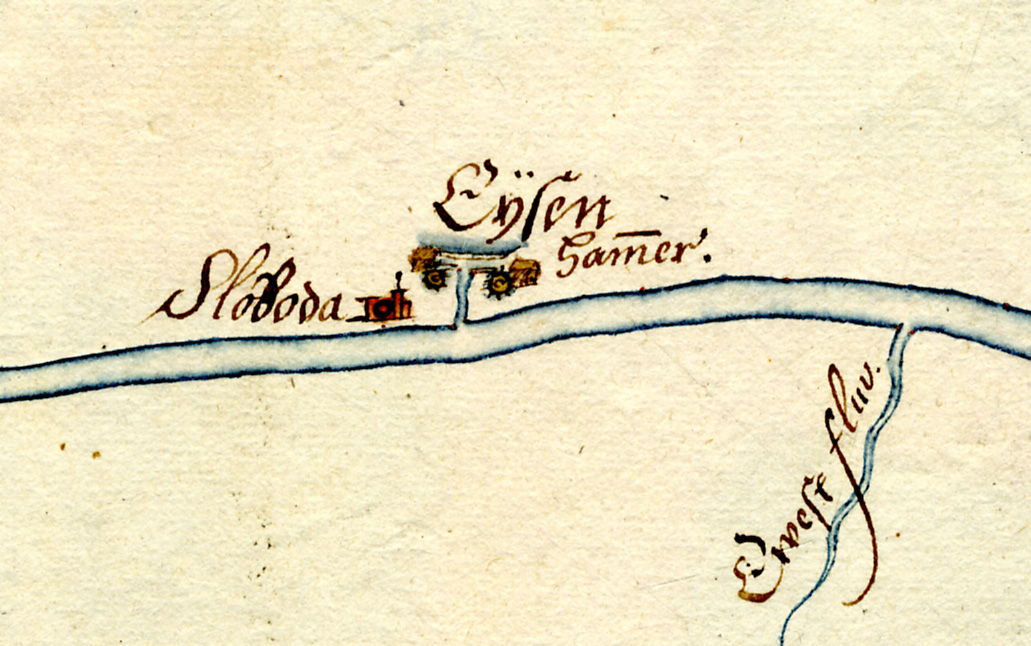
Birži iron manucacture (Grossbuschhofsches Eisenwerk) near nowadays Jēkabpils. Clipping from a 1668 map. Latvian State History Archive, fund ID 673, description ID 1, case ID 979.
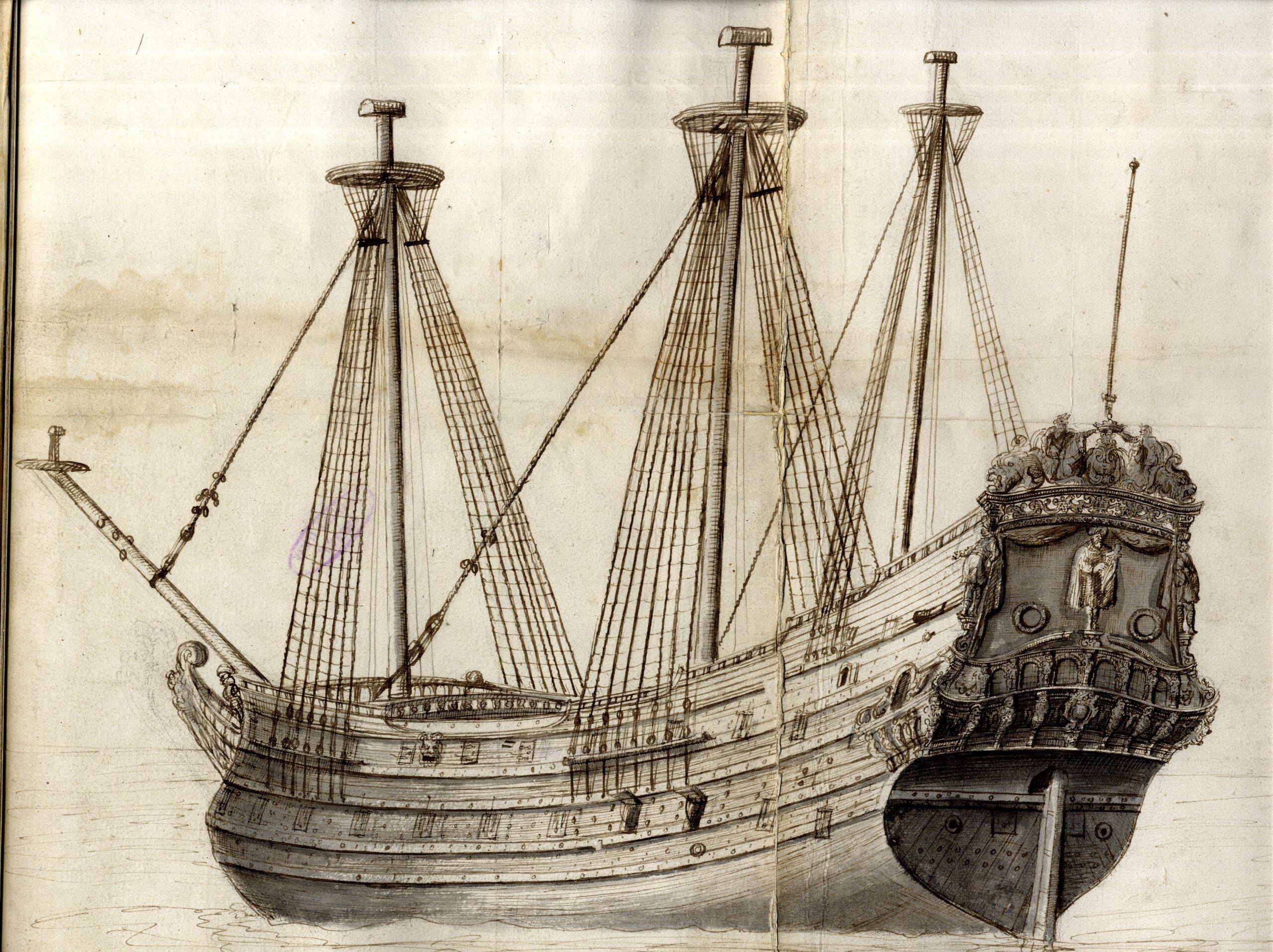
Model according to which frigates were built at Ventspils Shipyard (painting of the first half of the 17th century). Latvian State History Archive, fund ID 554, description ID 1, case ID 850
As he started his rule, Jacob did not wish to engage openly in conflict with the landlords and tried to consolidate the ducal authority by economic means. He increased the export of the products of the ducal manors to Western Europe and tried to channel through Courland a large part of the transit trade that flowed from the east (from Russia and frontier regions of Poland-Lithuania) which until then had been the prerogative of Swedish-governed Riga. At that time the most important routes for trade with Europe were the maritime ones, thus Jacob built a fleet of his own – the biggest fleet among the Baltic countries –, by establishing a shipyard in Ventspils. Following the spirit of the age and the traditions created by his predecessors, he tried to improve manorial efficiency and founded manufactures for various branches of production, including iron manufactures for processing the local bog ore. Jacob recruited experts throughout Europe, thus the duchy saw an influx of representatives of different nations who brought with them new technologies and know-how. Duke Jacob’s efforts in establishing manufactures was a unique phenomenon in the agriculture-oriented region, making him famous far beyond the borders of his state. For example, Jacob advised Russian Tsar Alexei Mikhailovich (1629–1676) on ship-building, metal and glass smelting and trade opportunities in the West Indies. At the same time, the Duchy of Courland became the point of intersection in the transfer of technologies, from where specialists recruited in the west often travelled further eastwards to the lands of Poland-Lithuania and, as already mentioned, Russia. Significantly, in the iron factories built by Tsar Peter I (1672–1725) in the Urals in 1702, the first cast-iron cannons were made in 1702 by master Eric De Pree whom the Tsar had recruited in Courland and whose ancestors had arrived in the duchy in the mid-17th century.
International trade and colonisation
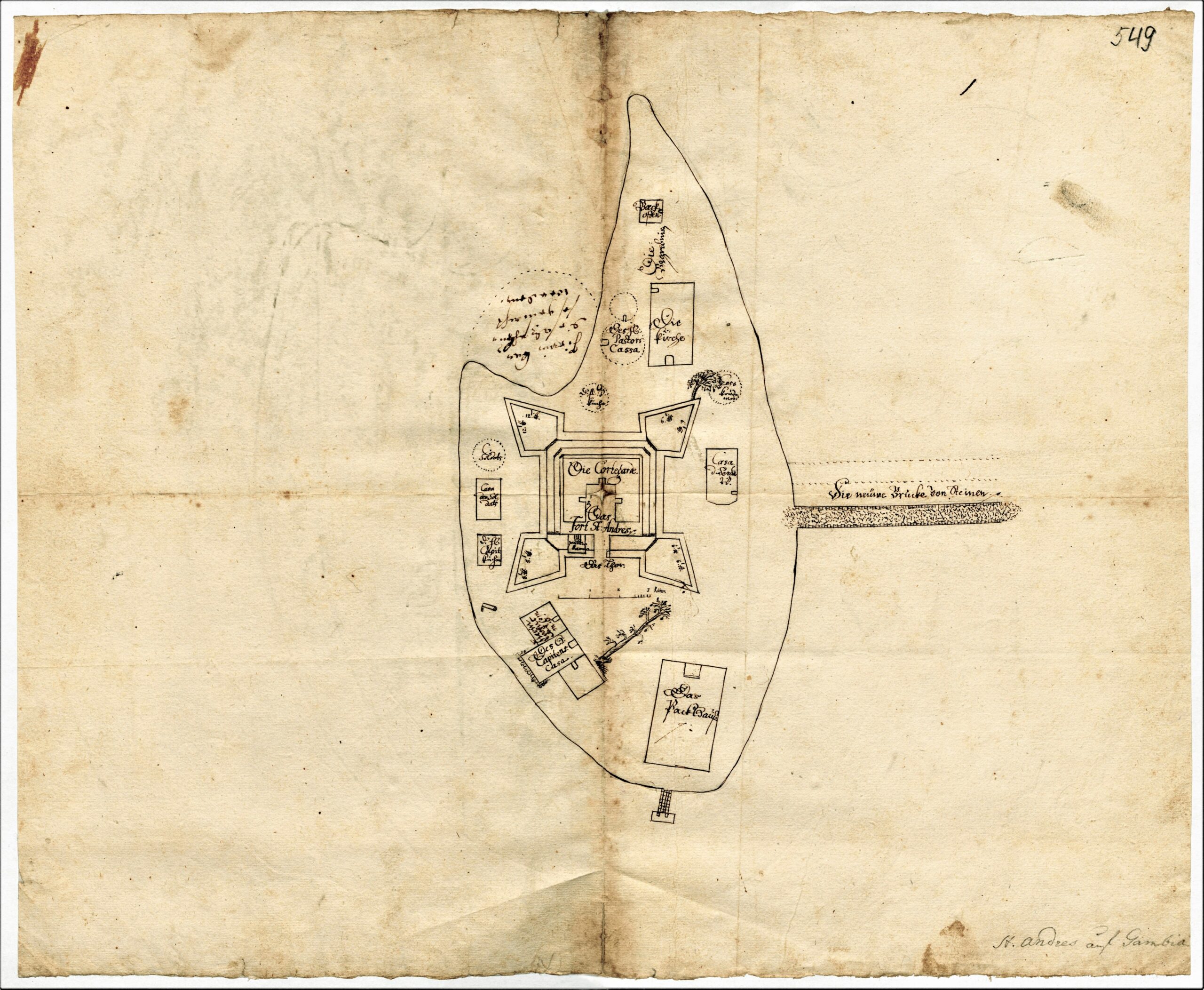
Settlement of Courlanders at St. Andrew’s Island in Gambia (1651). Latvian State History Archive, fund ID 7363, description ID 3, case ID 111.
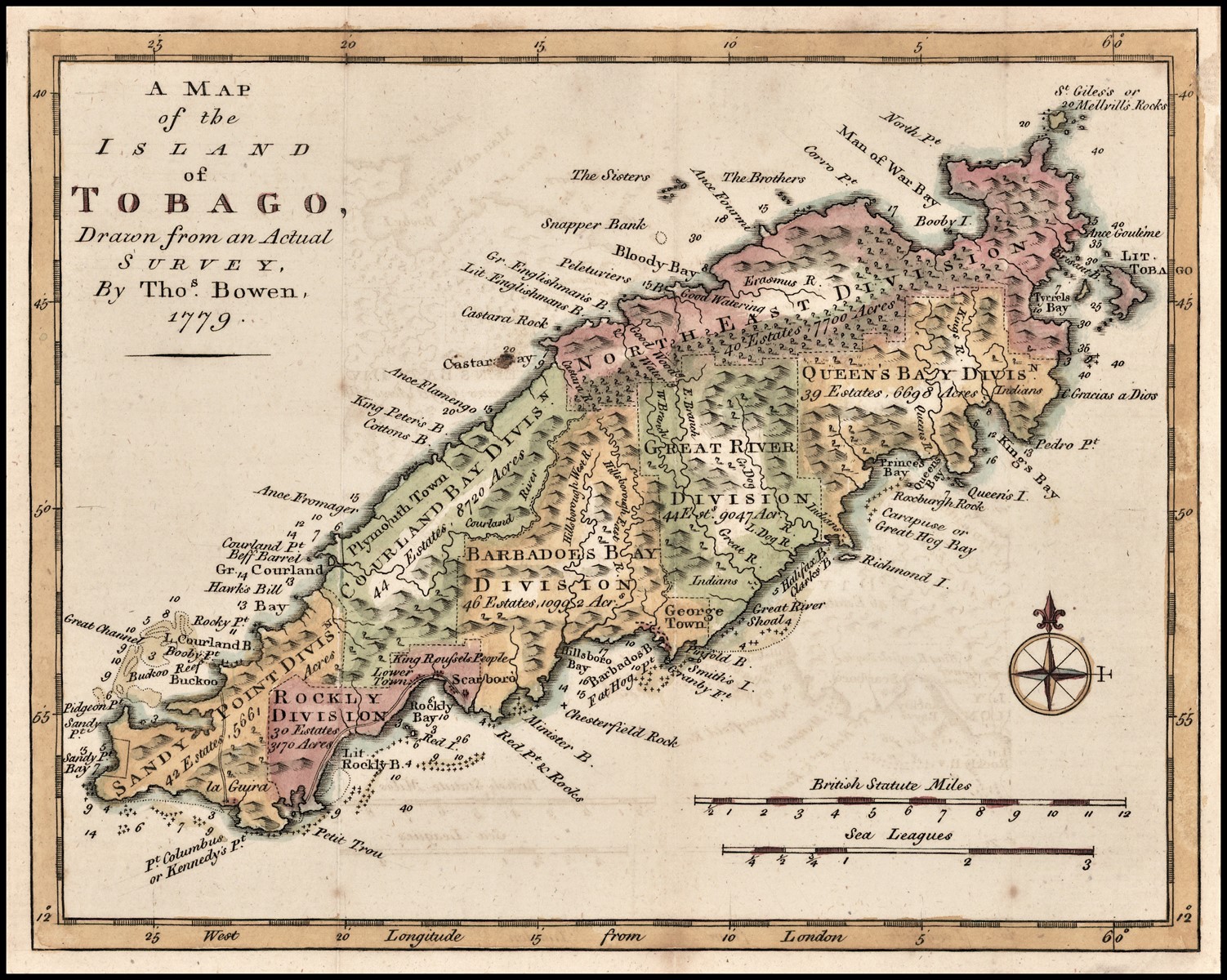
Map of Tobago (1779). Provided by Mārīte Jakovļeva, 2020.
An essential part of a mercantile economy, the most up to date socio-economic doctrine of the day which the duke followed, was the acquisition of colonies in distant continents. Thanks to Jacob’s activities, the name of the small duchy was heard not only all over Europe, but became known also in the coastal territories of Africa and America. In the mid-17th century, Jacob acquired several strong points in the estuary of the Gambia River in Africa (1651) and Tobago in the Caribbean (1654). Although due to another Polish-Swedish War (1655–1660), which also hit the Duchy of Courland hard, Jacob failed to consolidate his authority in his colonies for a protracted period, the Courlanders’ presence can still be felt in Tobago today. Place names seen on the map of Tobago – Fort James, Fort Bennett, Great Courland Bay and Courland River – are direct evidence of the Duke of Courland’s activities. Duke Jacob also dreamed of reaching India and discovering new lands further to the east in Terra Australis. In the 1650s, Jacob, who was a Lutheran but tolerant in religious matters, invited Pope Innocent X (1574–1655) to take part in the implementation of these plans, pledging to hand over ecclesiastic supremacy in the new lands to the Catholic Church. However, the negotiations were cut short by the pope’s death and his successor did not show any interest in the project.
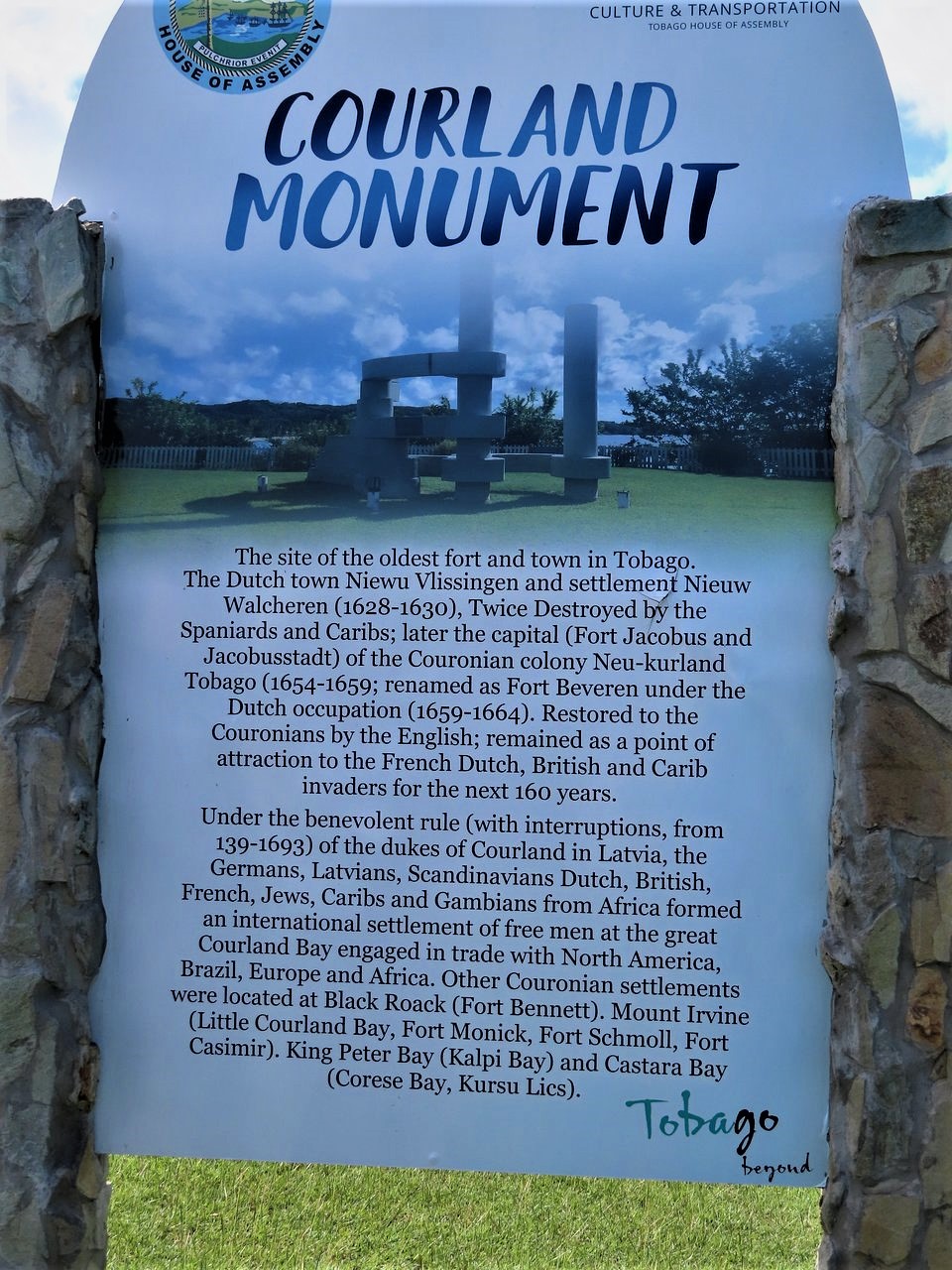
Map of Tobago (New Courland) drawn by Courlanders (1654). Latvian State History Archive, fund ID 7363, description ID 3, case ID 111.
Duke Jacob’s foreign policy was closely associated with his economic and colonial plans. This is shown by his trade and shipping contracts with France and England, mining privileges he acquired in Norway as well as diplomatic relations established between the Duchy of Courland and Russia. After Jacob’s marriage to Luise Charlotte (1617–1676), sister of the Elector of Brandenburg Friedrich Wilhelm (known as ‘the Grand Elector’ 1620–1688), in 1645, the Ducal House of Courland became further integrated into the Hohenzollern dynastic network, which was later attested by the marriage of Jacob and Luise Charlotte’s children to the princes and princesses of Hessen-Kassel, Hessen-Homburg and Brandenburg. It should also be mentioned that Prince Friedrich of Hessen-Kassel (1676–1751), who in 1720 became the King of Sweden, was Duke Jacob’s grandson. In turn, the Elector of Brandenburg took a lively interest in Duke Jacob’s activities, especially in the field of overseas trade, and followed his brother-in-law’s lead in his own colonial policies.
In the 17th century, the increasing economic development of the Duchy of Courland and Semigallia led to further urban expansion of the town of Kuldīga and numerous urban elements developed which significantly contribute to the image of the town today. As the previous town square in the Church district had become too small for the growing population, an additional town square was built at the location of today’s Town Hall square, together with the construction of a Town Hall beginning from 1626. Over the next decades, today’s Town Hall Square started to develop in the centre of Kuldīga, with shops opening around it (Jākobsone 2013, 36). The old town centre with the square next to St. Catherine’s Church soon lost its meaning as, in the course of rapid economic growth, the Town Hall square developed into the new centre of Kuldīga where all major roads passed by (Scheffler 1940, 11).
As the religious diversity expanded during this period, a second church district was built west of the Town Hall square for the religious needs of Catholic citizens. The north-western part of the town developed in close connection with the development of the Jewish community. In addition to economic growth, the urban layout of the 17th century hence also reflected the societal changes in Kuldīga, mainly an increase of inhabitants and a wider variety of religious and cultural backgrounds of the people who lived in the town.
At the same time, roads were given increasing importance due to the stronger focus on economic activities. The material excavated beneath the ielas in the course of archaeological research showed that in the 13th and 14th centuries ielas were either covered by waste or paved with logs (Asaris and Lūsēns 2013, 158). With the increase of economic activities introduced by the dukes of Courland, paving of roads became more important. The nobility ensured constant maintenance of the streets so that the postal service, which was an important element of the growing economy responsible for the transportation and delivery of goods, could operate quickly; even quicker than the postal services of the surrounding states (Biedriņš and Jākobsone 2013, 209). By this time, approximately 90% of the iela network of the nominated property had been developed. Remains of the earliest paving’s made of pebbles, pieces of brick or brushwood in the early 17th century were excavated in Liepājas Iela, Baznīcas Iela, Dzirnavu Iela, Rumbas Iela, Kaļķu Iela, Kalna Iela and Policijas Iela (Asaris and Lūsēns 2013, 158).

The expansion of Kuldīga’s urban layout in the 17th century. Schematic representation by Inta Jansone according to the research “Kuldīga. Pilsētbūvniecība un arhitektūra”, 2020.

Cannons of the 17th – 18th century near Kuldīga District Museum at 5 Pils Street. Photo by Kārlis Komarovskis, 2020.
A period of crisis
Duke Jacob’s activities reached their apex in the first half of the 1650s. Regretfully, the successful development of the duchy was cut short by yet another round of military conflicts in the region. Pursuing the policy set by his uncle Duke Friedrich, Jacob strictly preserved the neutrality of the Duchy of Courland which, in view of the growing ambitions of the neighbouring countries, was not an easy task. Under the Polish-Swedish truce signed in Stuhmsdorf in 1635, the Duke of Courland along with the Elector of Brandenburg were appointed ‘peace procurators’ who had to ensure that the 26-year truce became ‘a perpetual peace’. Since Duke Jacob was well aware that without a lasting peace between Poland-Lithuania and Sweden all his efforts would be in vain, in the first two decades of his rule, reconciliation between Poland-Lithuania and Sweden was one of his most important diplomatic goals. Over several years, Duke Jacob organised negotiations between the two parties, involving as mediators also Brandenburg-Prussia, France, Estates-General of France and Venice. Regretfully, the peace congress that convened in Lübeck in 1651 and, with intervals, lasted for two years, ended without result. Soon warfare started within close proximity of the borders of the Duchy of Courland. First, in 1654, war broke out between Poland-Lithuania and Russia; then, in 1655, Sweden engaged in military activities against Poland-Lithuania and a year later also against Russia. Duke Jacob tried to achieve reconciliation between Sweden and Poland-Lithuania as late as 1655, when the Chancellor of Courland Melchior von Foelckersa (also Voelckersamb) tried to persuade the King of Sweden to meet the envoys of the King of Poland for negotiations, first lobbying in Stockholm and then following the former to Danzig (mod. Gdansk). The Chancellor was also assigned with the task of achieving the recognition of Courland’s neutrality by Sweden. It was reported that King Carl X Gustav (1622–1660) said the following about Jacob: “The Duke of Courland is too powerful to be a duke, but not powerful enough to be a king.” The Swedes pledged not to harm the duchy on condition that they were guaranteed provisions during the march of their army and kept this promise until the autumn of 1658. In turn, in the first years of the war, Jacob managed to obtain written confirmation of the duchy’s neutrality from the Tsar of Russia and King of Poland as it was advantageous for them to use the territory of the duchy as a diplomatic channel, through which envoys of different countries travelled in different directions. Not infrequently, the court of the Duke of Courland served as a venue for the envoys to exchange topical information unofficially.
However, respect for Jacob was not an obstacle for the Swedes to invade the duchy in October 1658, capture the duke and his family and holding them captive for more than a year and a half, first in Riga and then in Ivangorod fortress at the Narva River. Although a range of rulers, for example the Electors of Brandenburg-Prussia, Saxony, Mainz and Cologne, Dukes of Braunschweig-Lüneburg and Braunschweig-Kallenberg, Landgrave of Hessen and even the Holy Roman Emperor, called for the duke’s release, the King of Sweden ignored all pleas. The defence capacities of the Duchy of Courland itself were weak as, fearing the growth of the ducal power, the landlords had been against the reform of the military system, which remained based on the vassals’ service. Thus, the Swedes quickly captured the duchy’s territory but were soon countered by the Courlanders’ units, the troops of Poland-Lithuania and the Elector of Brandenburg. The flames of war wreaked huge damage, the majority of the ducal enterprises were devastated and his palaces were plundered.
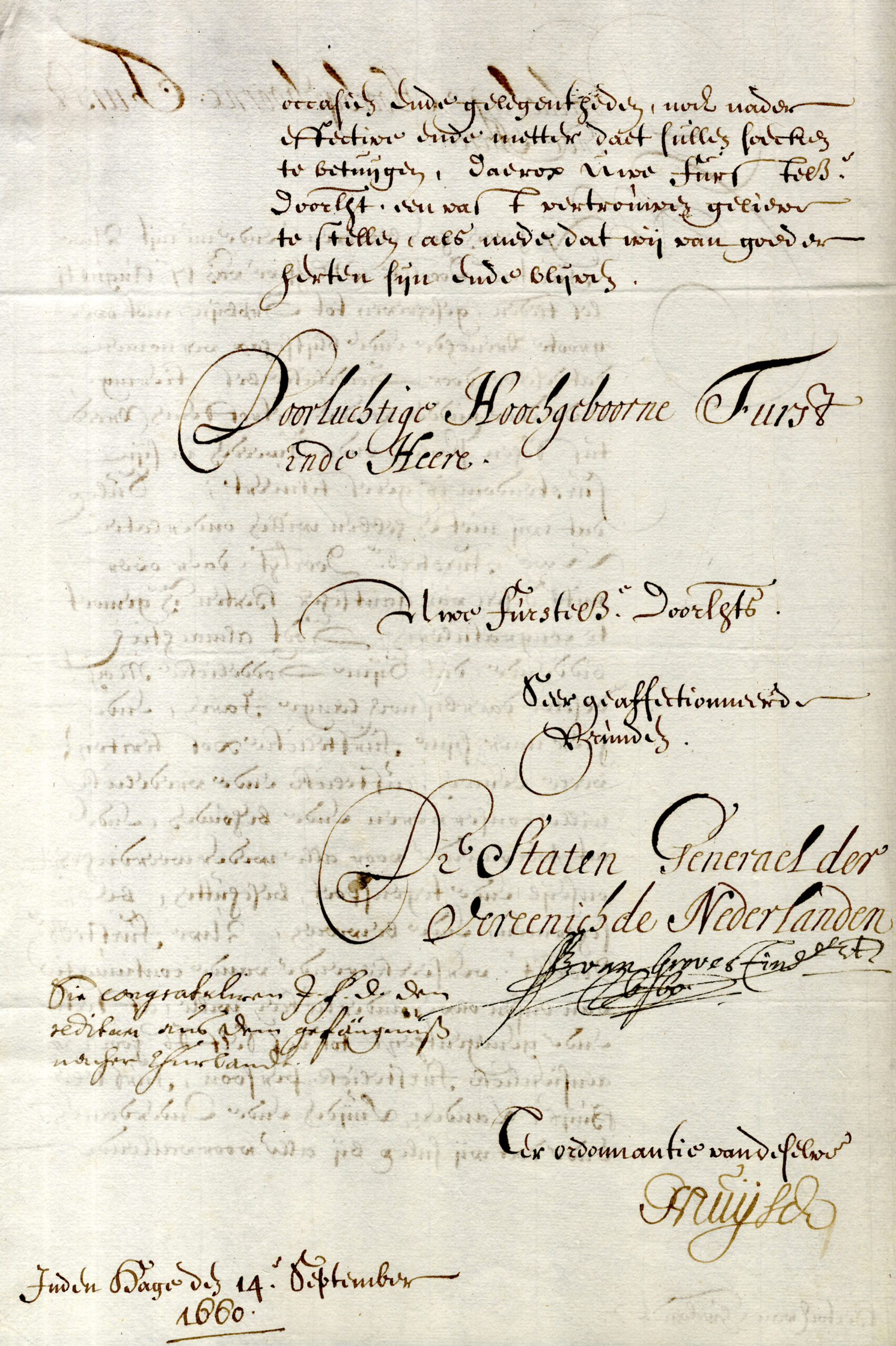
Greetings of the State General of the Netherlands to Duke Jacob with his return from captivity. In Hague, September 14, 1660. Last page. Latvian State History Archive, fund ID 5759, description ID 2, case ID 1324, page 2.
None of the warring parties managed to get a clear upper hand in the war. During the peace talks that took place in the winter and spring of 1660, the Swedes demanded Courland, and among the Polish-Lithuanian party there also were voices that wished to see the duchy incorporated into Lithuania. It was only thanks to the support of France and Brandenburg-Prussia that the Courlandish delegation managed to achieve the restitution of Duke Jacob. After the signing of the Oliva peace treaty between Poland-Lithuania and Sweden, Jacob was allowed to leave Ivangorod and return to Courland, where he was ceremoniously welcomed in July 1660. Immediately after his release from captivity the duke started to rebuild the devastated economy. This required great effort and spending; nevertheless, it proved impossible to reach the pre-war level. Both captivity and advanced years took their toll on Jacob; furthermore, the prices of agricultural products were in decline in Europe from the 1660s, and hence, trade no longer brought the revenue it used to. The duke also exerted great effort to regain his colonies, which had been lost during the war. In 1664, Jacob received from the King of England formal confirmation of his right to Tobago, in return handing over his colonies in Gambia to the English. Yet, in reality, Tobago was in Dutch hands and it was only in 1679 that the Courlanders managed to restore their colony on the island. However, nothing could stop Jacob’s ambitious plans. Until the end of his life he cherished a dream about Trinidad, which he wanted to receive as compensation for his ships and goods captured by Spanish buccaneers, and he tried to regain his right to the Gambian properties from the English. Moreover, in 1677, when rumours about a new campaign by the Russian Tsar against the Swedes were in the air, Jacob proposed Sweden to buy Livonia and Riga from it and pledged to settle its issues with Russia by diplomatic means.
Duke Jacob stands out amongst other 17th century rulers not only for his ambitious plans and religious tolerance, which was very untypical in the Age of Absolutism, but also by his preference for peaceful means in resolving political issues. However, Jacob’s enterprises often did not match the actual capacities of his state and his excessive reliance on the promises of diplomatic and trade partners not infrequently led to great material losses. Duke Jacob may be truly admired for his daring, tenacity and activity, yet, when leaving this world on 31st December 1681, he placed his eldest son and heir to the throne, Friedrich Casimir (1650–1698), in a rather complicated internal political and economic situation.
The rule of Friedrich Casimir Kettler
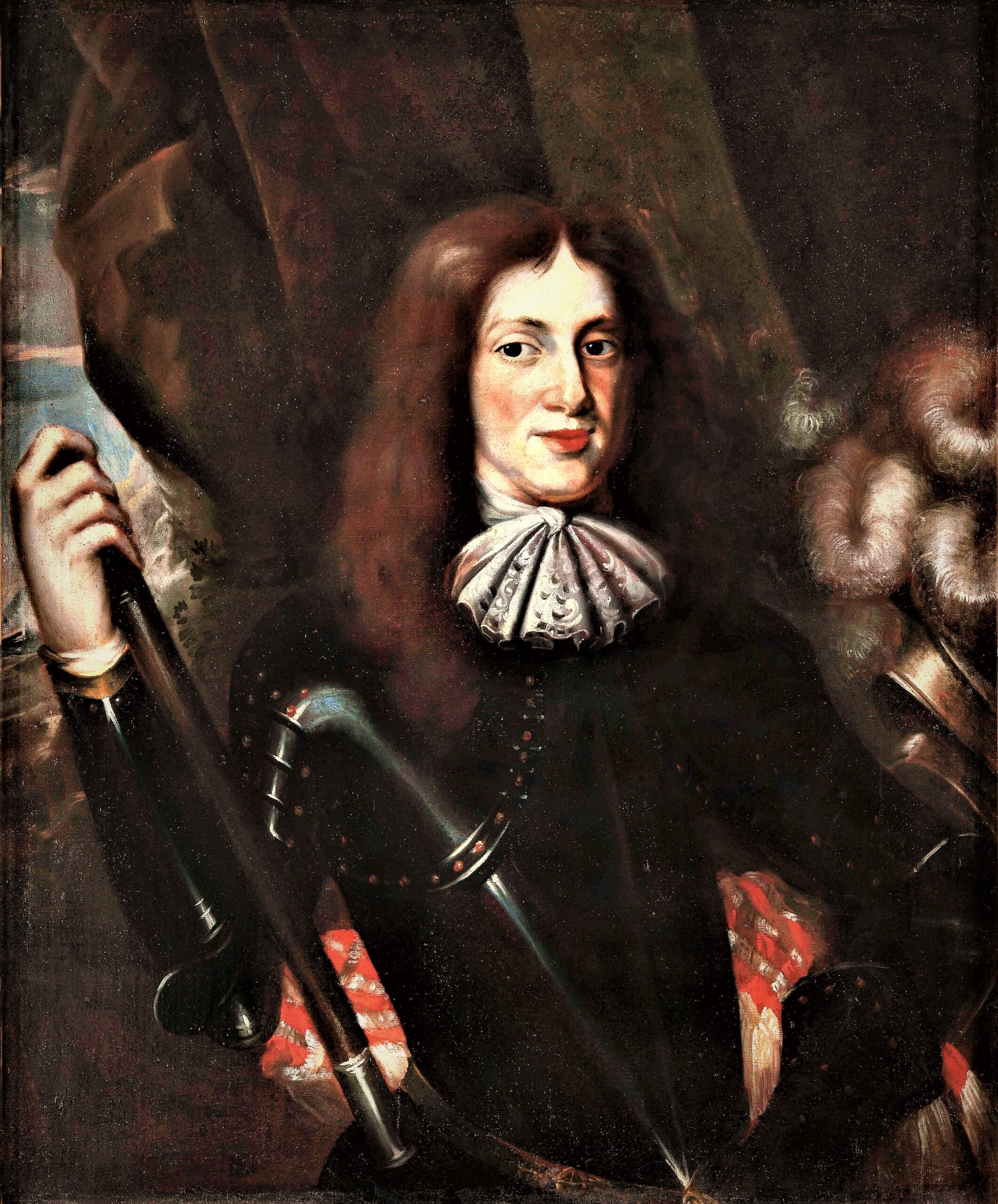
Duke Ferdinand. Painting at the Gripsholm Castle in Sweden. Provided by Mārīte Jakovļeva, 2020.
Friedrich Casimir, together with the rest of the ducal family, had undergone captivity at the hands of the Swedes. Since the dangers of war had not subsided even after the signing of Oliva peace treaty as the Polish-Russian war went on (until 1667), for security reasons, Duke Jacob sent his heir to stay with the Elector of Brandenburg after their return to Courland. The Prince spent almost ten years in Berlin and Cleve, where he was under the care of the governor of Cleves Johann Maurice of Nassau (1604–1679). Apparently under the influence of Johann Maurice, who in 1671 had been appointed commander-in-chief of the Dutch States Army, Friedrich Casimir did not stay in Courland after his ‘gentleman’s tour’ but joined the Dutch Army together with several regiments that he himself had recruited. He took part in the French-Dutch War (1672–1674) and in The Hague on 5th October 1675, he married Johann Maurice’s niece Sophie Amelie (1650–1688). The following summer, the young couple moved to Courland, where Duke Jacob engaged his heir in the governance of the state. However, after his father’s death, Friedrich Casimir faced difficult tasks. The young duke had to exert great effort to settle relations with the landlords that in the last years of Jacob’s rule had become strained. The landlords refused to swear the oath of allegiance to Friedrich Casimir before all their complaints were reviewed. The parties reached an agreement only in 1684 when Friedrich Casimir signed a pledge to respect all the landlords’ rights and privileges and the landlords finally swore the oath of allegiance to him. Furthermore, in compliance with Jacob’s will, Friedrich Casimir had to pay his siblings huge amounts of money that he had to borrow abroad. Naturally, this was not an easy task, however, his relatives were not willing to wait and demanded the entire amounts bequeathed to them by the will at once. The duke had a particularly harsh dispute with his brother Ferdinand (1655–1737), which the Elector of Brandenburg and the King of Poland had to help resolve (see Bues 1995).
On the whole, Friedrich Casimir followed the economic and policy principles set by his father. For example, he reorganised the duchy’s metal industry following the model of Sweden, which at the time had a highly progressive metallurgical industry, and built ships not only in Ventspils, but also in Liepāja (as of 1677). The duke also tried to maintain his colony on Tobago island, which had been regained shortly before Jacob’s death, however, the great distance and financial problems made it difficult to grant the colony the necessary support. Although in the last decades of the 17th century the region was spared large-scale military conflicts, it was impossible to entirely avoid conflicts with the neighbours. The deepest discord was caused by the struggle of the Swedes against the unauthorised small parts of the coast of Courland under the inspiration of Riga, as the latter regarded the establishing of any new port apart from Liepāja and Ventspils as a violation of its privileges. In the spring of 1697, Friedrich Casimir received the so-called Grand Russian Embassy, which included Tsar Peter I who thus travelled incognito to Western Europe. Peter liked the kind welcome that he received in Courland much better than the unfriendly attitude demonstrated towards him in Riga and apparently this later contributed to the tsar’s relatively benevolent attitude towards the duchy in the context of the Great Northern War (1700–1721). A few months after the tsar’s visit, the Duchy of Courland was visited also by the Elector of Brandenburg Friedrich III (1657–1713; the future King of Prussia Friedrich I), whose sister Elisabeth Sophie (1674–1748) had become Friedrich Casimir’s second wife. During Friedrich Casimir’s rule, the existence of the Duchy of Courland as such was not threatened. However, the situation changed dramatically after his death on 22nd January 1698.
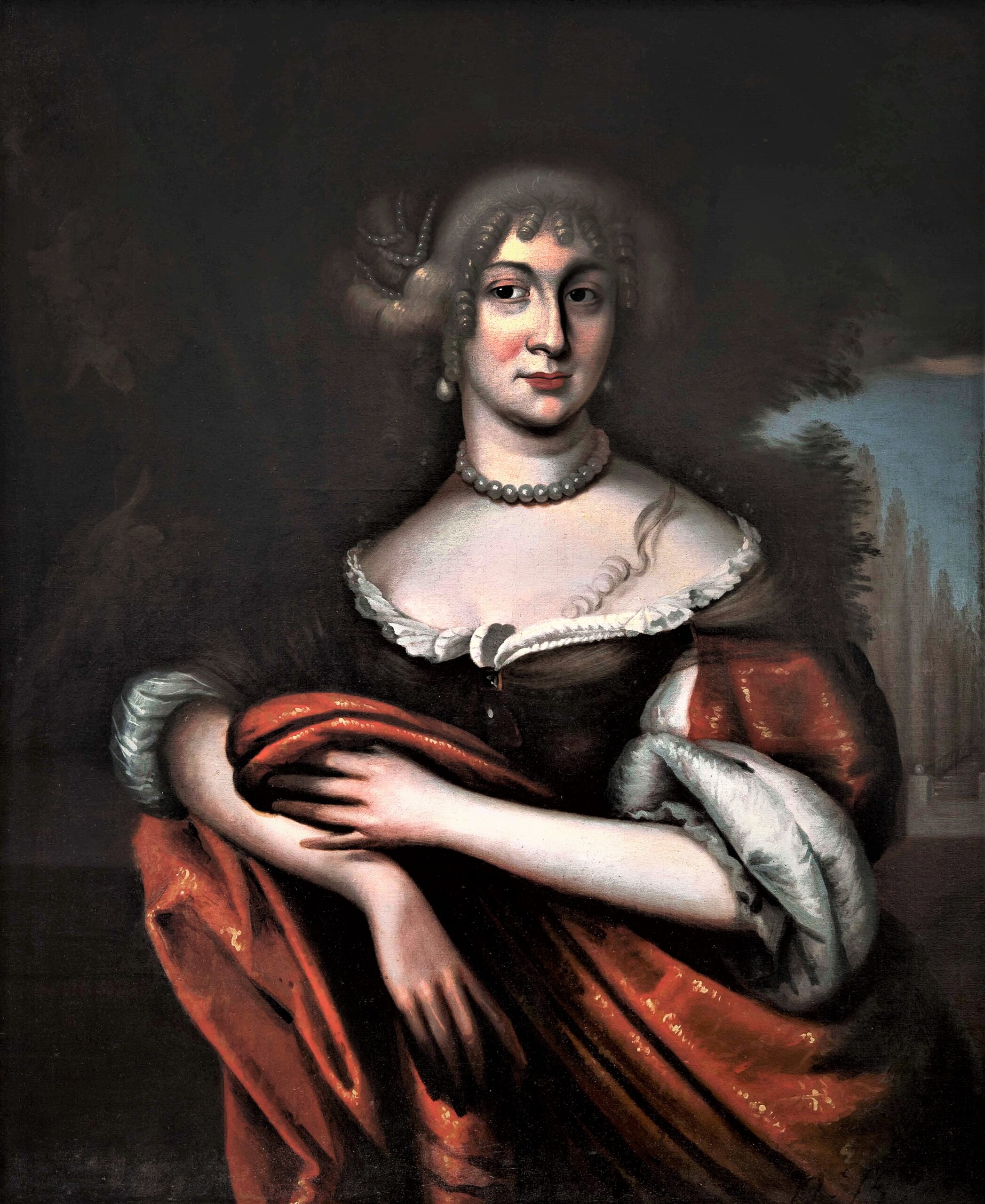
The first wife of Duke Friedrich Casimir, Sophie Amelie, Princess of Nassau-Siegen. Painting at the Gripsholm Castle in Sweden. Provided by Mārīte Jakovļeva, 2020.
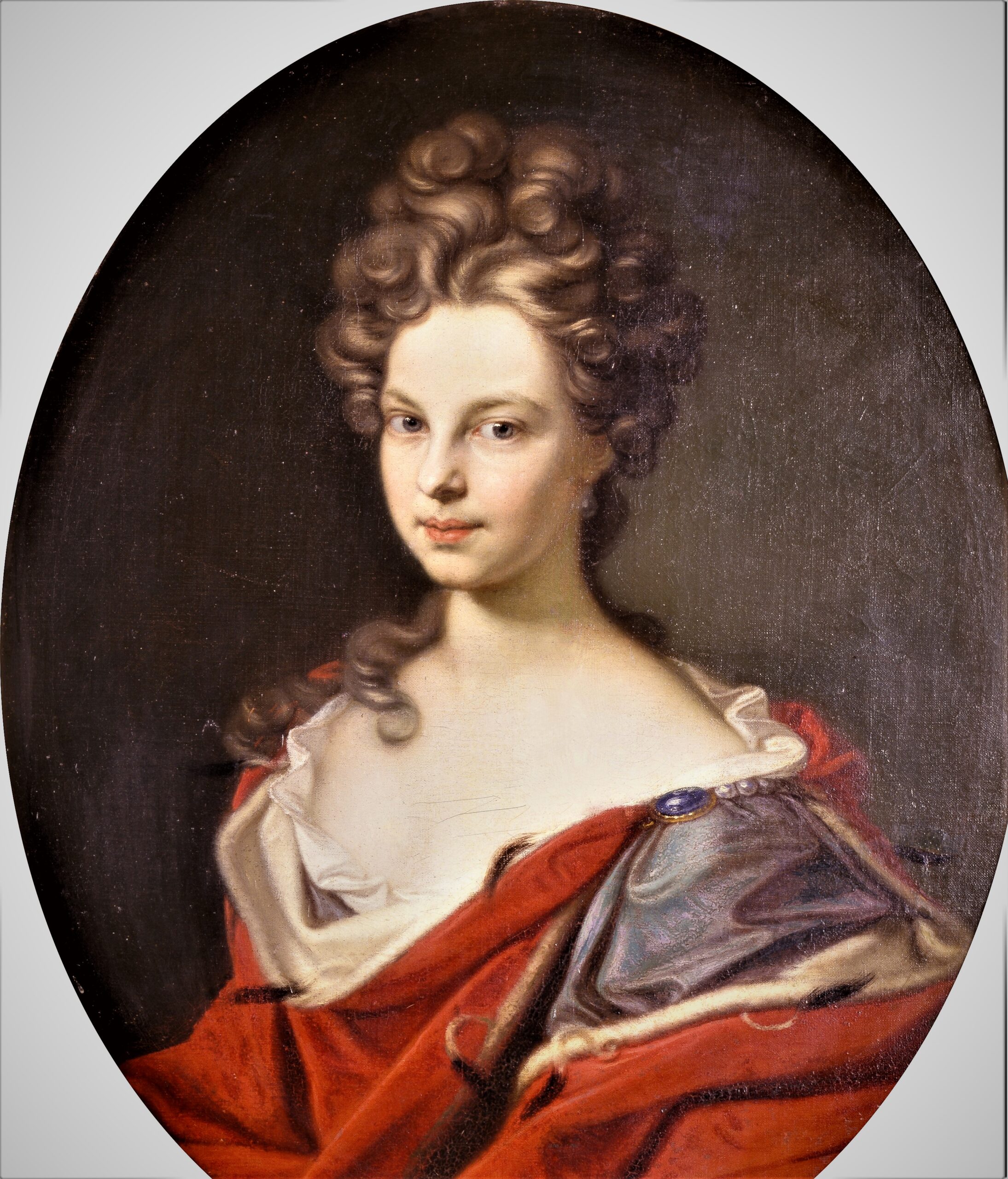
The second wife of Duke Friedrich Casimir, Elisabeth Sophie, Princess of Brandenburg-Prussia. Painting by Gedeon Romandon (1691). Provided by Mārīte Jakovļeva, 2020.
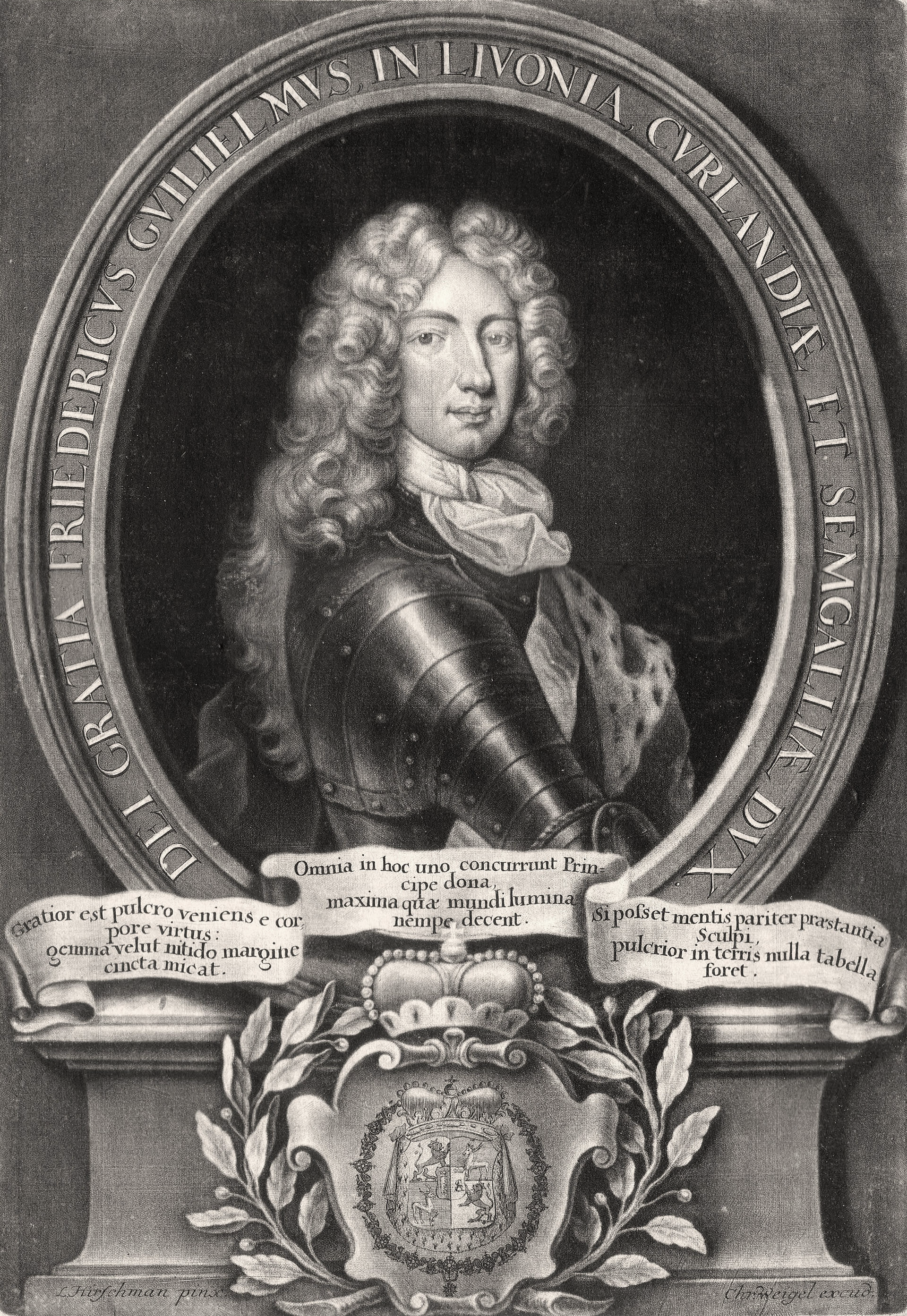
Duke Friedrich Wilhelm. Engraving by Christoph Weigel (1710). Provided by Mārīte Jakovļeva, 2020.
Power struggles over the succession of the throne
Friedrich Casimir’s only son and heir to the throne Friedrich Wilhelm (1692–1711) was less than six years old at the time of his father’s death. This situation immediately triggered a massive political struggle for the guardianship of the young duke. Both the Dowager Duchess Elisabeth Sophie, who mobilised the support of Brandenburg-Prussia, and the late duke’s brother Ferdinand, who had spent a long time in the Polish-Lithuanian army and had good contacts at the Polish Court, aspired to the regent’s status. Ferdinand seemed to prevail, however the situation remained unstable. The power crisis was further deepened by the Great Northern War. On 22nd February 1700, when the King of Poland Lithuania and Elector of Saxony August II the Strong (1670–1733) used the territory of the duchy as a bridge-head for his attack on the Swedish Riga, Ferdinand was forced to abandon the policy of Courland’s neutrality. To maximally protect the duchy from the license of the Saxon troops and to gain August II’s support in his domestic policy struggles, in May 1700 Ferdinand entered the King’s military service. After the defeat of the combined Saxon and Russian forces at the Battle of Spilve on 19th July 1701, Ferdinand left Courland and the army and henceforth worked towards the de-occupation of the duchy by diplomatic means. He never returned to Courland. Elisabeth Sophie had left the duchy even earlier, together with her son, departing for Königsberg to attend the crowning ceremony of her half-brother, the Elector of Brandenburg Friedrich III as the King of Prussia in January 1701.
The Swedes quickly captured the entire territory of the duchy. The Swedish occupation lasted until mid-1709, with an interval in 1705/1706 when Russian troops arrived in Courland. Victory at Poltava (1709) allowed the Russian Tsar Peter I to concentrate his forces for the conquest of the Baltics and with the annexation of Livonia (the present-day Vidzeme region and Estonia) to Russia in 1710, Russia’s influence started to increase also in Courland.
Since at that time Peter I still had to reckon with the opinion of his allies, who at the same time were his competitors, in late 1709, Poland-Lithuania, Russia and Prussia agreed on keeping the existing status for the Duchy of Courland. However, to be allowed to ascend the throne of Courland, Friedrich Wilhelm, who had been raised in Germany, had to marry the niece of the Russian Tsar Peter I, Anna Ivanovna (1693–1740). Regrettably, the Duchy of Courland’s prospects of a more peaceful life were reduced to ashes when the young duke died on his way home from his wedding in Saint Petersburg in January 1711, leaving Anna Ivanovna a widow. On the tsar’s order Anna Ivanovna moved to Jelgava in 1716. A range of ducal manors, including Kuldīga, were allocated for her maintenance. The duchy, already ravaged by the war and plague, had to pay the Russians various tributes and the widow’s provision that was stipulated in the marriage contract. In turn, Ferdinand, who lived in Danzig (mod. Gdansk), did not recognise either his nephew, or his widow’s right to govern Courland and continued sending instructions to the board of senior councillors, which also sporadically tried to pursue its own policy. The duchy’s landlords also had split into several factions. Thus, the Duchy of Courland remained overwhelmed by political chaos, which had set in right after Duke Friedrich Casimir’s death.
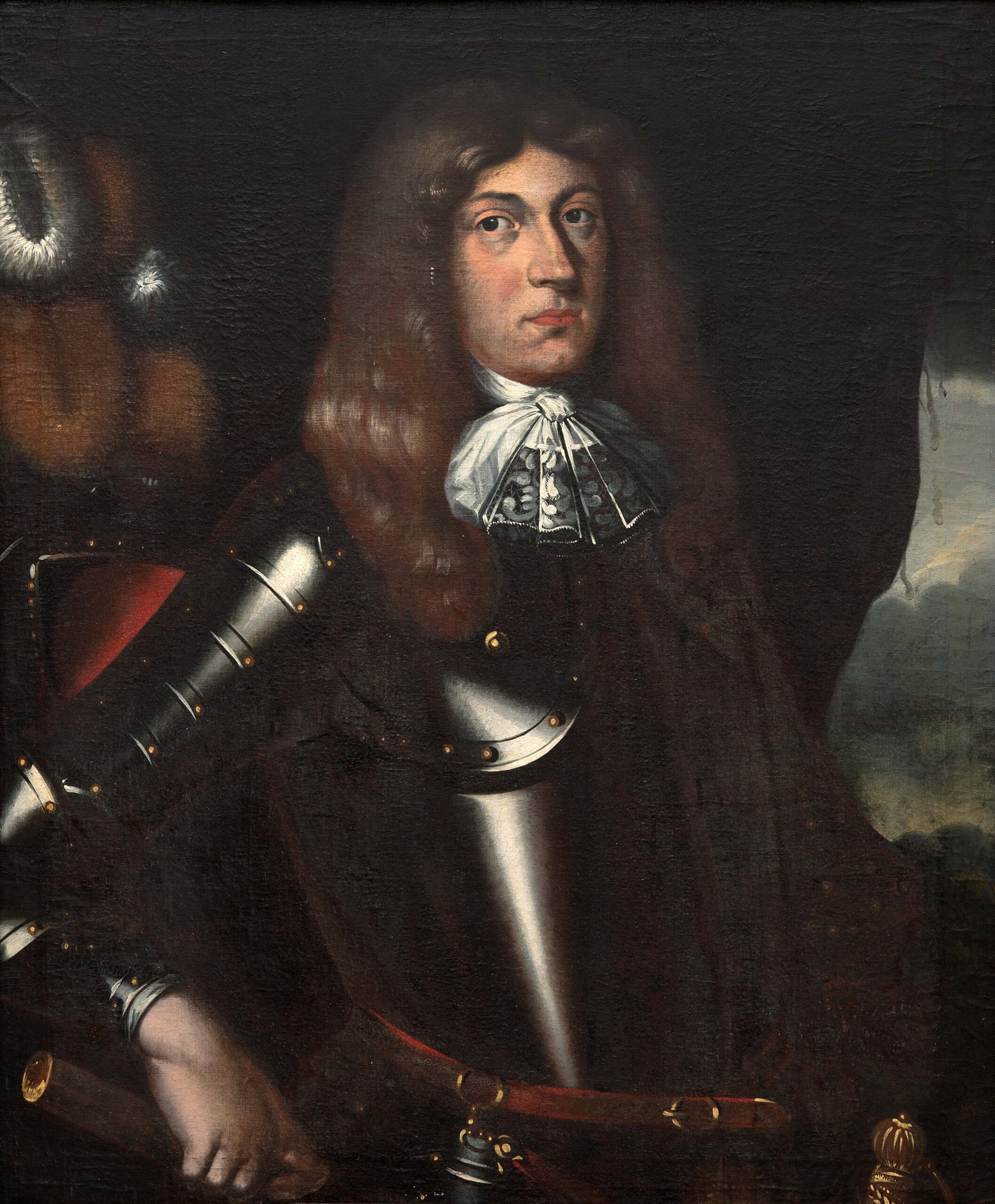
Duke Ferdinand. Painting at the Gripsholm Castle in Sweden. Provided by Mārīte Jakovļeva, 2020.
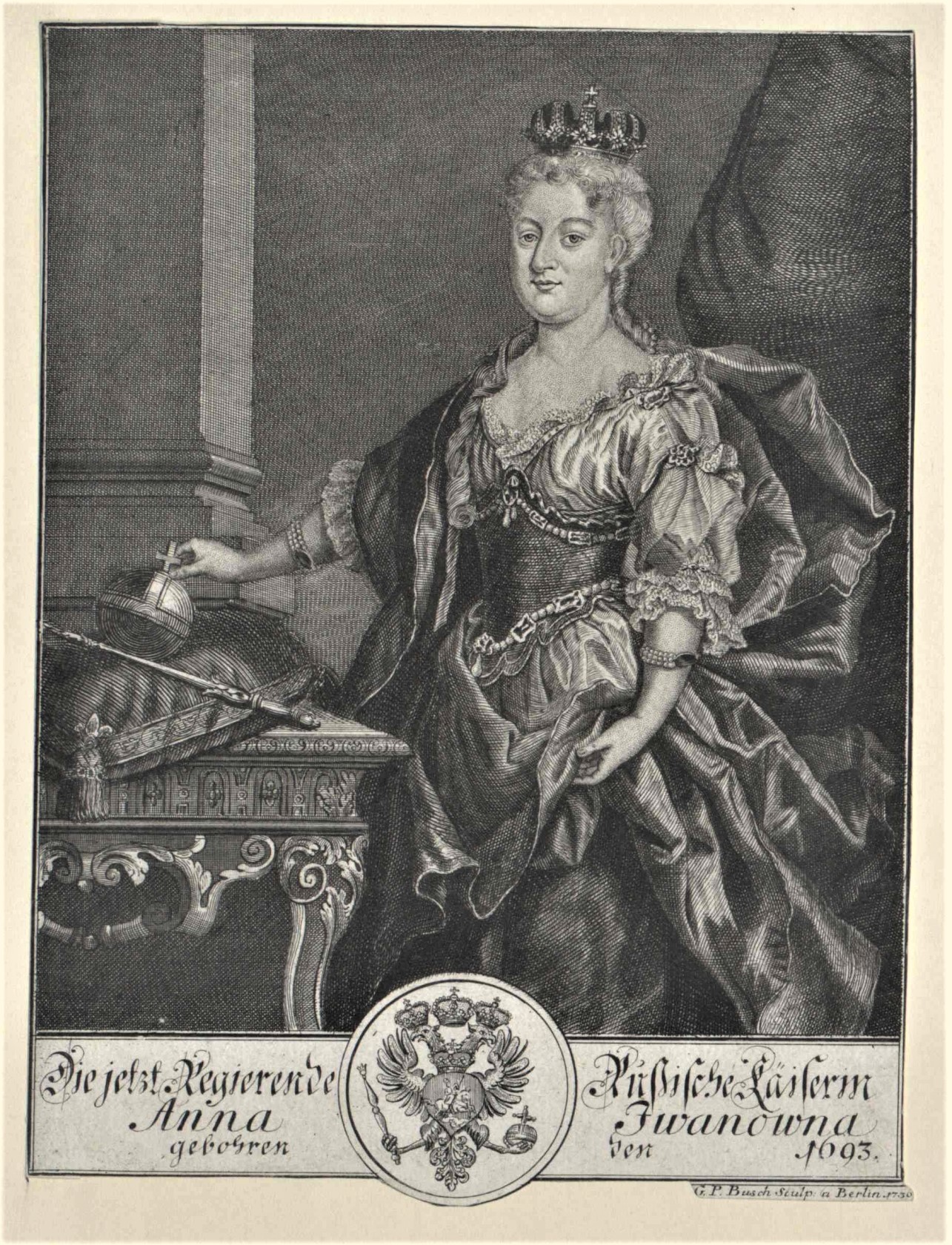
Former Duchess of Courland Anna Ivanovna after becoming the ruler of Russia. Engraving by Georg Paul Busch (1730). Provided by Mārīte Jakovļeva, 2020.
The end of the Kettler dynasty
Since Ferdinand had no children, the issue of the future of the Duchy of Courland became complicated. Soon after the news of Duke Friedrich Wilhelm’s death had spread, there began a search for the next claimant to the throne. Saxony, Brandenburg-Prussia, Hessen-Kassel and several other states actively advanced their own candidates, however, Russia dictated the rules, putting forward the demand that the pretender to the throne of Courland had to marry Anna Ivanovna. The interested parties could not agree on any of the candidates, whose number had reached 17 by 1724 and continued to grow. The election of August II’s son, Prince Maurice of Saxony (1696–1750), as duke by the diet (landtag) on 5th July 1726 gave Saxony only ephemeral hope of founding their dynasty in Courland, as it was contested both by Russia and a group of Polish-Lithuanian landlords who were not interested in the consolidation of royal power and would have preferred to see the duchy as a province of Poland-Lithuania. Although Maurice came to Jelgava and managed to win Anna Ivanovna’s favour, he failed to become Ferdinand’s successor to the throne as in 1727 the Polish-Lithuanian Sejm annulled the landtag’s decision and Maurice had to flee abroad to escape being arrested by the Russians.
The fate of the duchy was decided by the growth of Russian influence in Poland. During the so-called War of the Polish Succession (1733–1735), Russia forced the Polish-Lithuanian Sejm to elect August III (1696–1763) as king. Under Russian pressure, in 1736, the Sejm also revoked its earlier decision on the incorporation of Courland and accepted the duchy’s right to elect a new duke after Ferdinand’s death. This happened very soon after, as Ferdinand died in Danzig on 4th May 1737. Five weeks later, the landlords of Courland gathered in Jelgava and elected Anna Ivanovna’s favourite Ernst Johann Biron (1690–1772) as duke. Anna Ivanovna herself had become the Empress of Russia in 1730. Biron came from the von Bühren family which once had been denied entry in the Adelsmatrikul of Courland. However, neither Ernst Johann, who ruled in 1737–1740 and 1763–1769, nor his son Peter Biron (1724–1800), who sat on the throne in 1769–1795, managed to win stable ducal power. This was due not only to resistance from the landlords, but also to internal political developments in Russia, as a result of which in late 1740 Ernst Johann was arrested and exiled together with his family for more than 20 years. During this time, the highest local authority in the duchy, which formally still retained its vassalage to Poland-Lithuania, was represented by the senior councillors, but the decisive role was played by the resident i.e. the authorised minister of Russia. In 1758, with Russia’s support, the throne of Courland was granted to the Prince of Saxony Carl (1733–1796) who was the son of King August III of Poland. However, soon after Catherine II’s (1729–1796) accession to the Russian throne in 1762, the attitude of Russia changed again and in April 1763 Carl had to leave Courland.
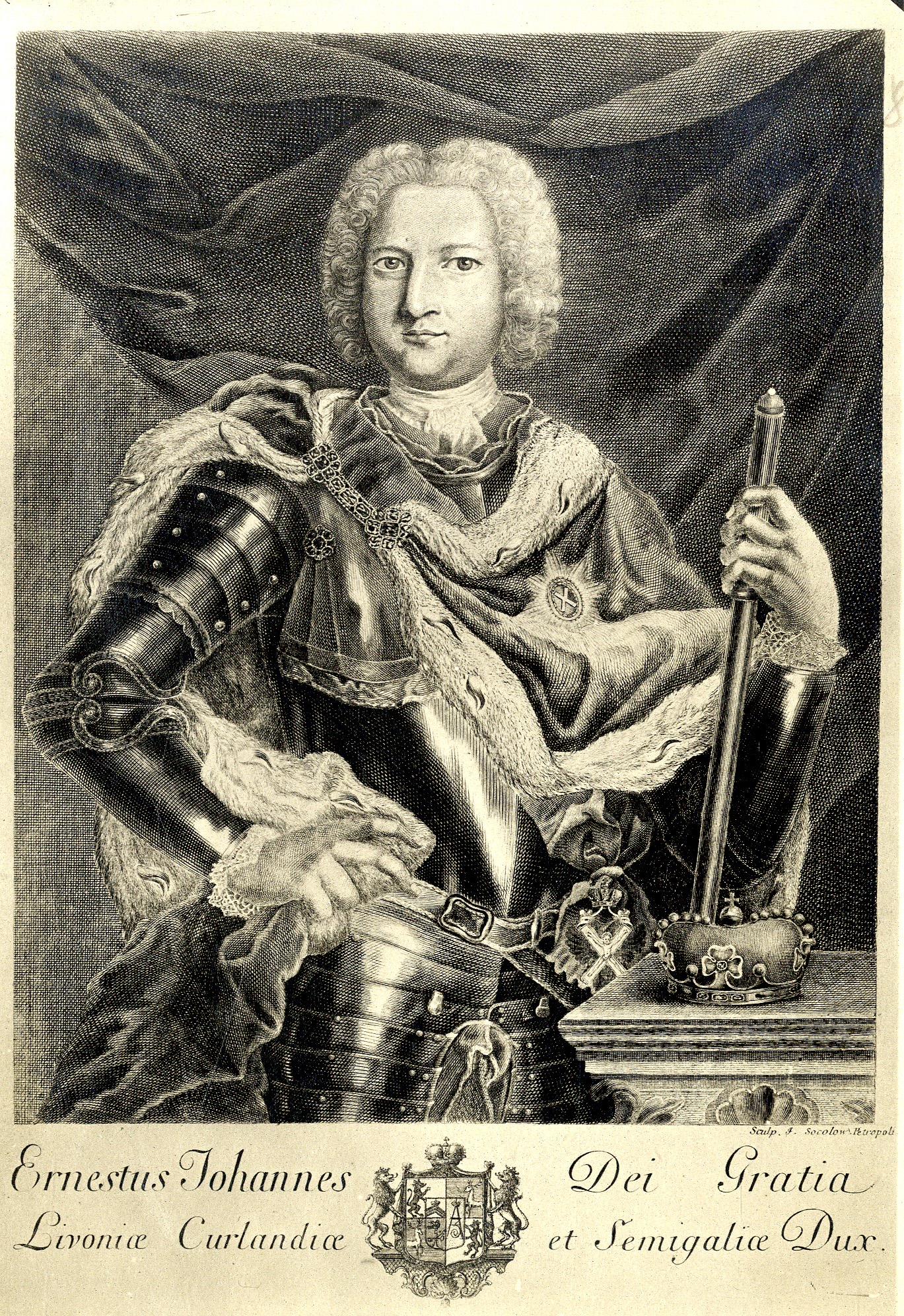
Duke Ernst Johann Biron. Latvian State History Archive, fund ID 640, description ID 2, case ID 262.
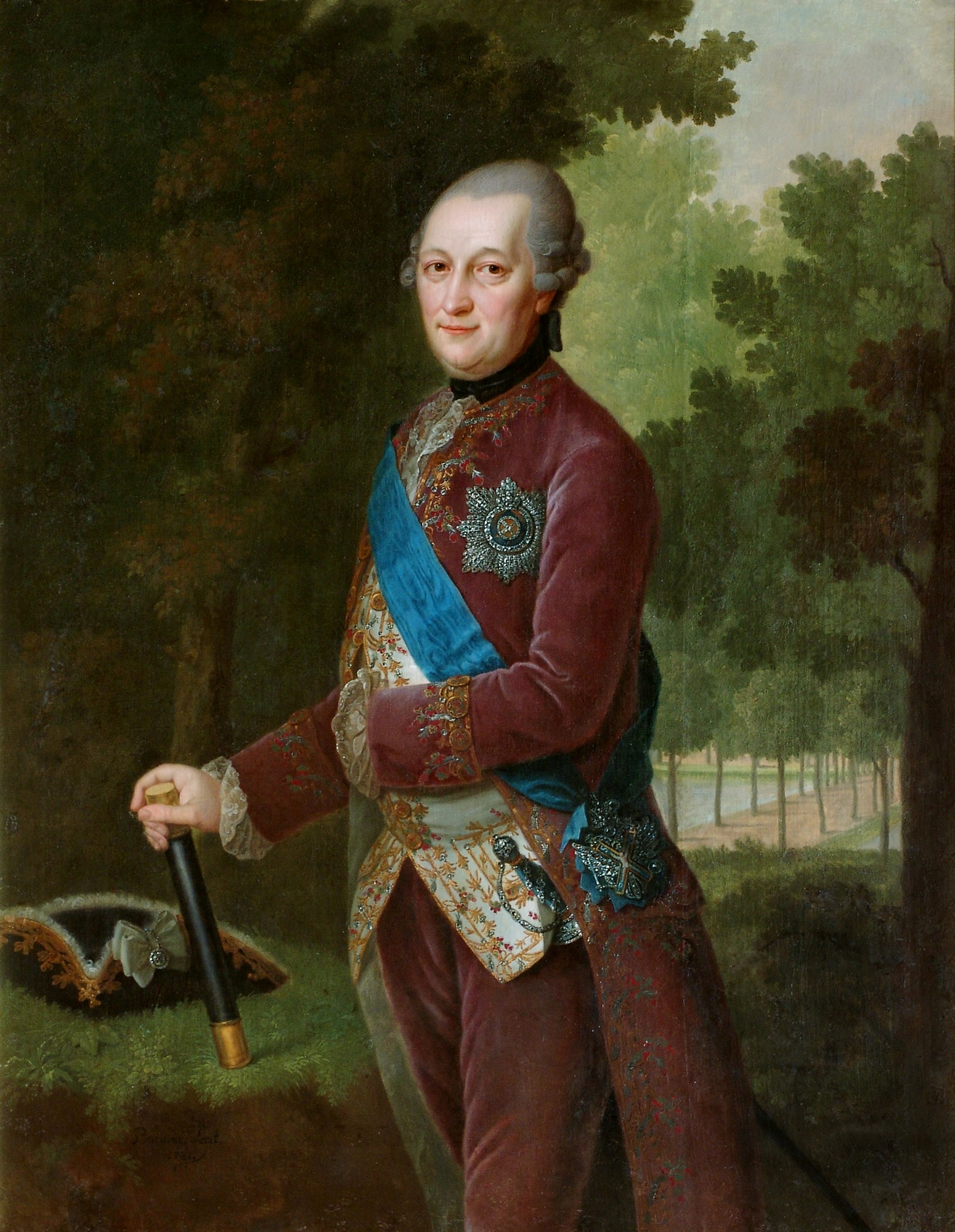
Duke Peter Biron. Painting by F. H. Barisien at Rundāle Castle Museum. Provided by Mārīte Jakovļeva, 2020
While all of the above-named challenges occurred on the political scene, Kuldīga registered its fastest expansion. Whereas the previous expansions mostly reflected on the evolution of the society living in Kuldīga, the 18th century expansions highlight the increasing interchange also with other towns in the Duchy, as the roads leading to Ventspils (in the north), Aizpute and Liepaja (in the west) and Skrunda and Jelgava (in the south) were paved. A distinct town centre and new roadways along with new buildings were constructed and determined the intermodal shape of the town. In this time, the density of construction increased significantly along the main new streets.

The expansion of Kuldīga’s urban layout in the 18th century. Schematic representation by Inta Jansone according to the research “Kuldīga. Pilsētbūvniecība un arhitektūra”, 2020 Intas Jansones shematisks attēlojums atbilstoši pētījuma “Kuldīga. Pilsētbūvniecība un arhitektūra” rezultātiem, 2020.
The dissolution of the Duchy
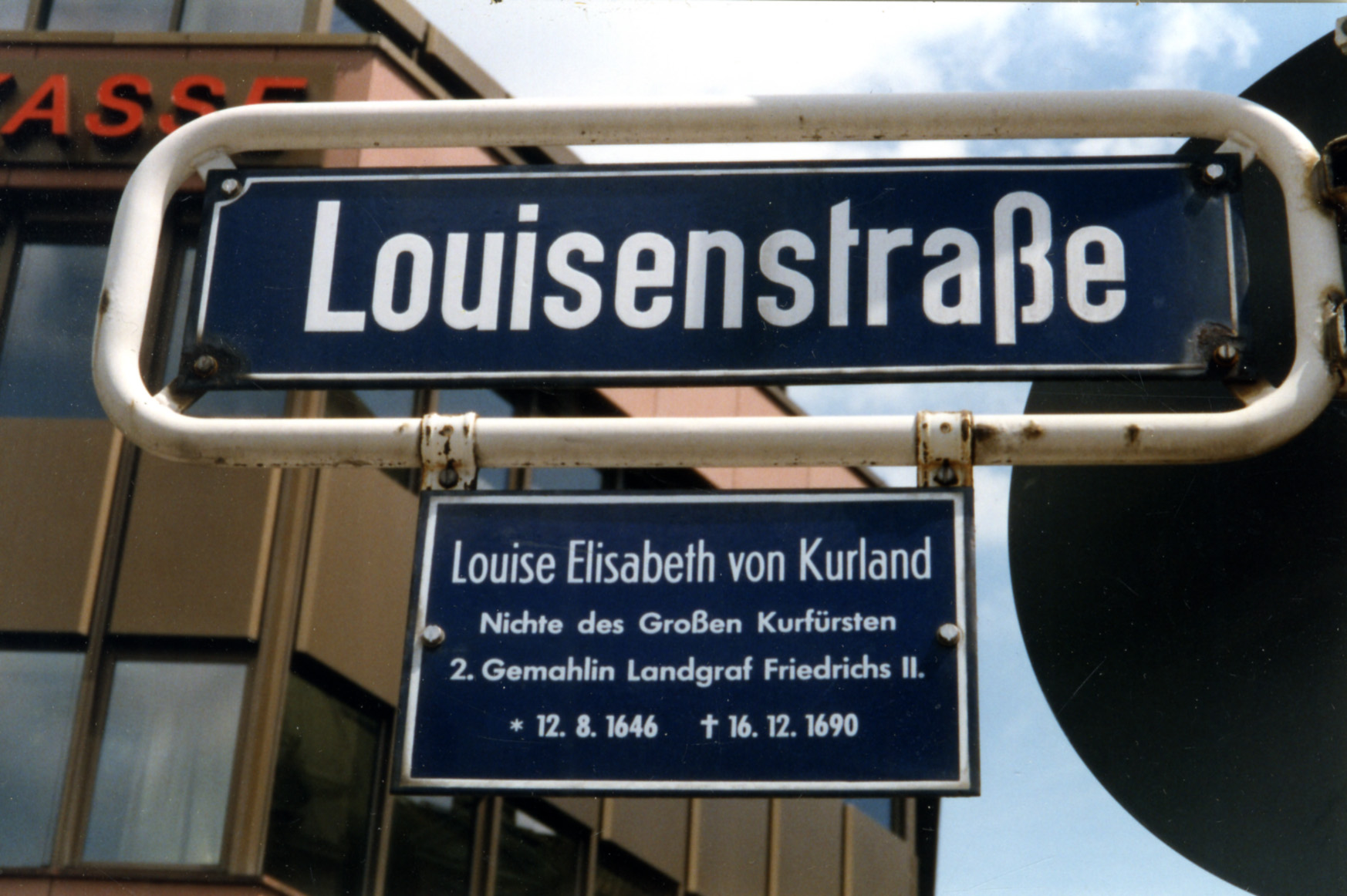
Plate with the name of the street “Louisenstraße” at Bad Homburg, former capital of the Hessen-Homburg Landgrafschaft. Photo by Mārīte Jakovļeva, 2020.
In the final years of the duchy the struggle between the duke and the landlords’ opposition continued and, moreover, the town dwellers also started to speak up for their political rights in 1790, founding a Burgher’s Union (Bürgerliche Union). But the greatest concern among the ruling circles of the duchy was caused by an uprising led by Tadeusz Kościuszko (1746–1817) that started in Poland in 1794 and soon spread to Courland as well. In fear of the rebels and under political pressure from Russia, on 18th March 1795, the Diet of Courland adopted a declaration on surrendering to Russia. Ten days later, Duke Peter signed his abdication in Saint Petersburg and on 26th April 1795, Catherine II declared Courland and Semigallia a province of the Russian Empire. Thus, the Duchy of Courland and Semigallia ceased to exist. It should be noted that the surrendering of the Duchy of Courland to Russia was only seemingly voluntary, as in fact, its annexation was already planned during the Third Partition of Poland.
Remnants of Courland times
The period of the Duchy of Courland and Semigallia (1562–1795) marks an important and striking page in the history of Latvia. The period under discussion largely saw the formation of the population structure in the region and the network of churches that stayed in place until the 20th century, as well as the development of the typical Courlander mentality. After the collapse of Livonia, the duchy represented local statehood, in contrast to the other territories of present-day Latvia that came under direct subjugation to neighbouring powers. However, the complicated geopolitical situation that the duchy faced, serving as a buffer zone between the neighbouring powers – Poland-Lithuania, Sweden and Russia – as well as the constant challenge from the part of the Courlandish landowners eventually led to the liquidation of the duchy. However, thanks to the activities of the Kettler and Biron dukes, the name of Courland became known both in Europe and in other parts of the world. The Courlanders’ extensive trade, cultural and family contacts show that, in the early modern period, Courland was not as provincial as it gradually became as part of the Russian Empire. The “footprints” of Courland can be found in place names on Tobago and in many places in Europe, for example, in Bad Homburg, the capital of the former Hessen-Homburg Langraviate there is a “Luise Street” (Louisenstraße), named in honour of Duke Jacob’s daughter Luise Elisabeth (1646–1690). The interior items and paintings commissioned by the Dukes of Courland are now part of the museums and private collections of many countries. A “Courland’s Competition” established by Duke Peter Biron for the best artwork was held from 1785 to 1946 in the Art Academy of Bologna (Academia Clementina) in Italy. Today, the Royal Porcelain Manufacture in Berlin decorates various objects with the so-called Courlandish ornament (Kurland-Dekor). Its origin is associated with a set, which was commissioned in 1787 by Duke Peter Biron for his newly acquired Friedrichsfelde Palace.
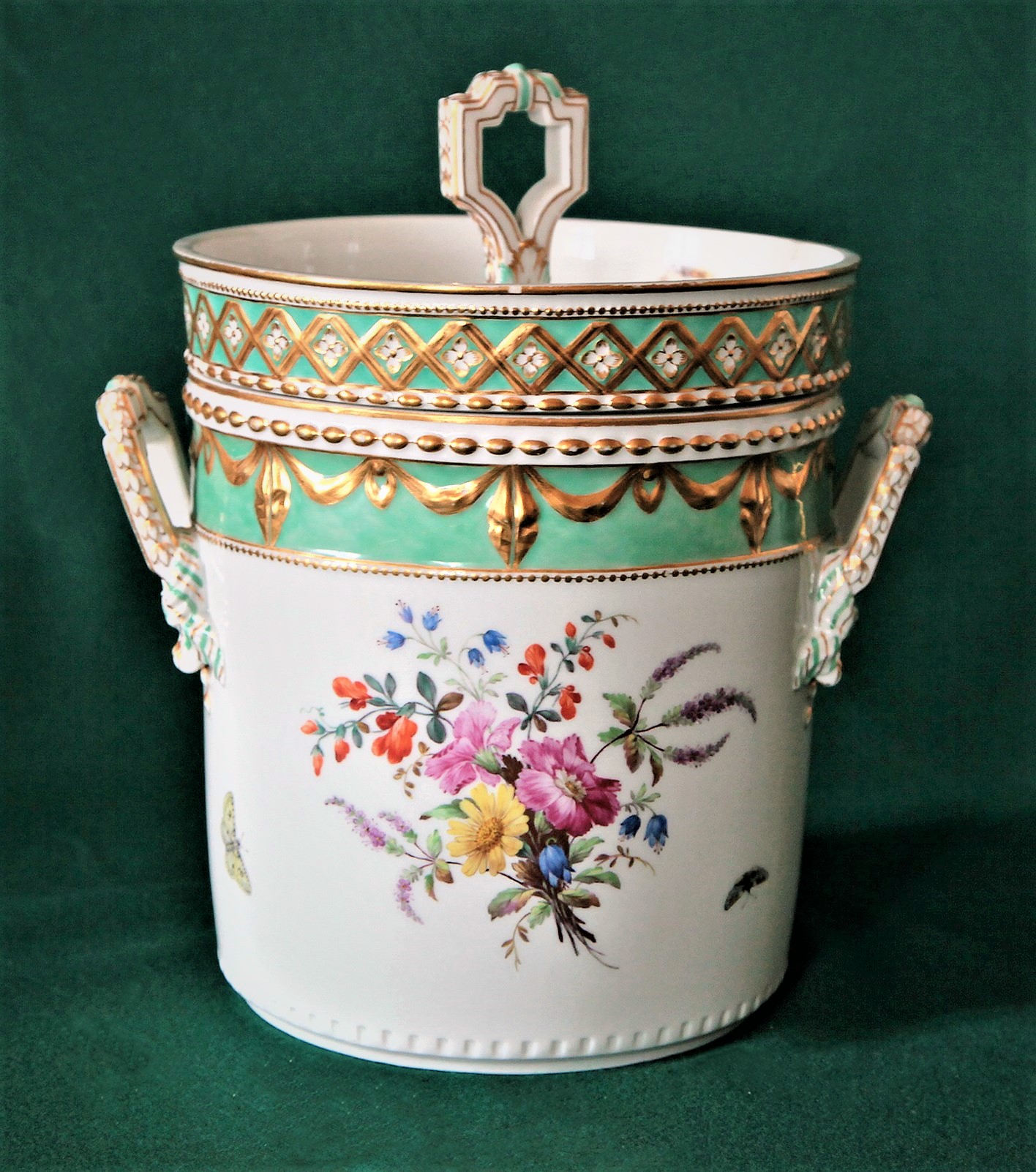
A dish from the “Courland set” (18th century) at Rundāle Palace Museum. Photo by Mārīte Jakovļeva, 2020.
Political Development after the dissolution of the Duchy of Courland and Semigallia
Throughout its history, the modern Latvian territory was subject to many political changes. Since 1561, the beginning of the Duchy of Courland and Semigallia, the Polish-Lithuanian Commonwealth, the Swedish Empire and Russia fought over this area in the Baltics. The citizens of Courland were constantly confronted with wars between regional opposing powers. After more than 230 years under ducal rule, the Duchy of Courland and Semigallia was dissolved and it became a Russian province in the course of the third partition of Poland in 1795. It was the last territory of modern Latvia to be annexed to the Russian Empire. The subsequent period was to last for almost 130 years: Latvia officially belonged to Russia until the end of World War One.
Kuldīga in the Russian Empire (1795-1918)
In 1795, Russia, Austria and Prussia signed an agreement on the third partition of Poland. Under the terms of this agreement, the former Polish province – the Duchy of Courland and Semigallia – came under Russian rule. With this annexation of the duchy to Russia, the entire territory of modern Latvia came under its control: Vidzeme and Riga were annexed to Russia immediately after the Great Northern War in 1721 and Latgale during the first partition of Poland in 1772.
Within the Russian Empire, the former Livonian territory formed the Baltic Governor-General's area, which consisted of three provinces - the Estonian province, the Vidzeme province and the Courland province. Each province was governed by a Governor, who in turn was subordinated to the Governor General of the Baltic provinces, who resided in Riga (until 1876, when the post of governor general was abolished) (Švābe 1962, 24 pp). The province of Courland was formed by the former territory of the duchy, and the palace of the dukes in Jelgava became the seat of the Governor. The province administration, such as the Supreme Court, was also placed in Jelgava.
After the annexation of the Baltic territories to the Russian Empire, a long process began to integrate these three different territories into the empire's administrative, judicial and administrative structure, each with its own administrative structure and historically privileged German landlords. This process was entirely completed only in 1889, when the Russian judicial system and the corresponding laws were extended to the Baltic territories (Švābe 1962, 21-27).
During this time, very significant changes took place in the structure of society. Serfdom was abolished (in Courland in 1817, in Vidzeme in 1819, and in Latgale in 1861) and the peasants became personally free, although their cultivated land and houses remained the property of the landlords. The population of the cities grew rapidly, industry and transport developed. Education began to be available to the masses, including Latvians.
Within the Russian Empire, the town of Kuldīga retained its town administration, which had already been established in the Middle Ages, and the rights of the city of Riga, which had been modified over the centuries and slightly adapted to local conditions, for a long time. At the end of the 18th century, the Town Council of Kuldīga was formed by seven members. In general, the municipality was provided by the Council, the Large Guild or merchants' association and the Small Guild or craftsmen's association. Such an arrangement existed in Kuldīga until 1870, when the laws of Russian cities were applied to it (Švābe 1962, 245-248).
For a long time, the position of the superintendent, respectively the Chief Judge, and the Precinct of the Supreme Court of Kuldīga also continued to exist. In the 19th century, Kuldīga was one of the five highest judicial districts, the rest were located in Sēlpils, Jelgava, Tukums and Aizpute. It was only with the reform of the police and the reform of the judiciary (actually their assimilation to the laws of the empire) in 1888 and 1889, respectively, that the positions of the superintendent were abolished and converted into District Governors. However, this change only meant that a large number of landlords, former superintendents, continued the same duties, only in the role of tsarist officials (Švābe 1962, 483-503).
Kuldīga lost more and more of its central status in the Russian Empire. The administrative centre moved permanently to Jelgava and several other cities began to overtake Kuldīga in their development. Shortly after joining the empire, in 1798, Kuldīga was the fourth largest city of Courland after Jelgava, Liepāja and Jēkabpils, with 1352 inhabitants. In 1856, the population of Kuldīga had grown to 4,818, but it was only the fifth largest city after Jelgava, Liepāja, Aizpute and Bauska (Švābe 1962, 261). Waterways, which had previously dominated trade, were replaced by rail from the middle of the 19th century, and cities near railway lines grew accordingly. The first railway lines built in Courland did not affect Kuldīga. The Venta was too shallow for transporting the quantities of goods necessary for industry and the surrounding dirt roads were in poor condition (Krastiņš 2013, 224f). As a result of these factors, the city's development slowed down considerably, which had a positive effect on the preservation of the duchy’s legacy.
Despite the obstacles in the field of transport, factories eventually appeared in Kuldīga at the end of the 19th century and several companies were established. Factories were mainly concentrated in large cities, and Kuldīga was rather the exception. Of the small towns, only Kuldīga and Sloka had factories (Švābe 1962, 566 pp). In 1896, Kuldīga took the third place in Courland Province after Liepāja and Jelgava in terms of industrial production (Krastiņš 2013, 443 pp). The two largest factories in Kuldīga were the match factory Vulkāns and the Vinteler bag factory. Vulkāns began operations in 1878 as a small match workshop owned by Louis A. Hirschmann. The company expanded, constantly improved its production and in 1896 produced 58 million boxes of matches per year, supplying Latvia and exporting matches to Europe and Asia. The factory had branches in Riga, Liepāja and Saldus. In 1911, L. A. Hirschmann sold the factory to the Russian manufacturer V. A. Lapshin and Vulkāns continued to produce matches until the evacuation of equipment and personnel to Russia in 1915 (Zīverts 2005, 5-15, 22-24). There were also several other, smaller-scale factories: M. Hirschmann's needle factory (from 1862) (Dzenis 2018, 11), Goldberg’s soap factory, a leather processing factory, etc.
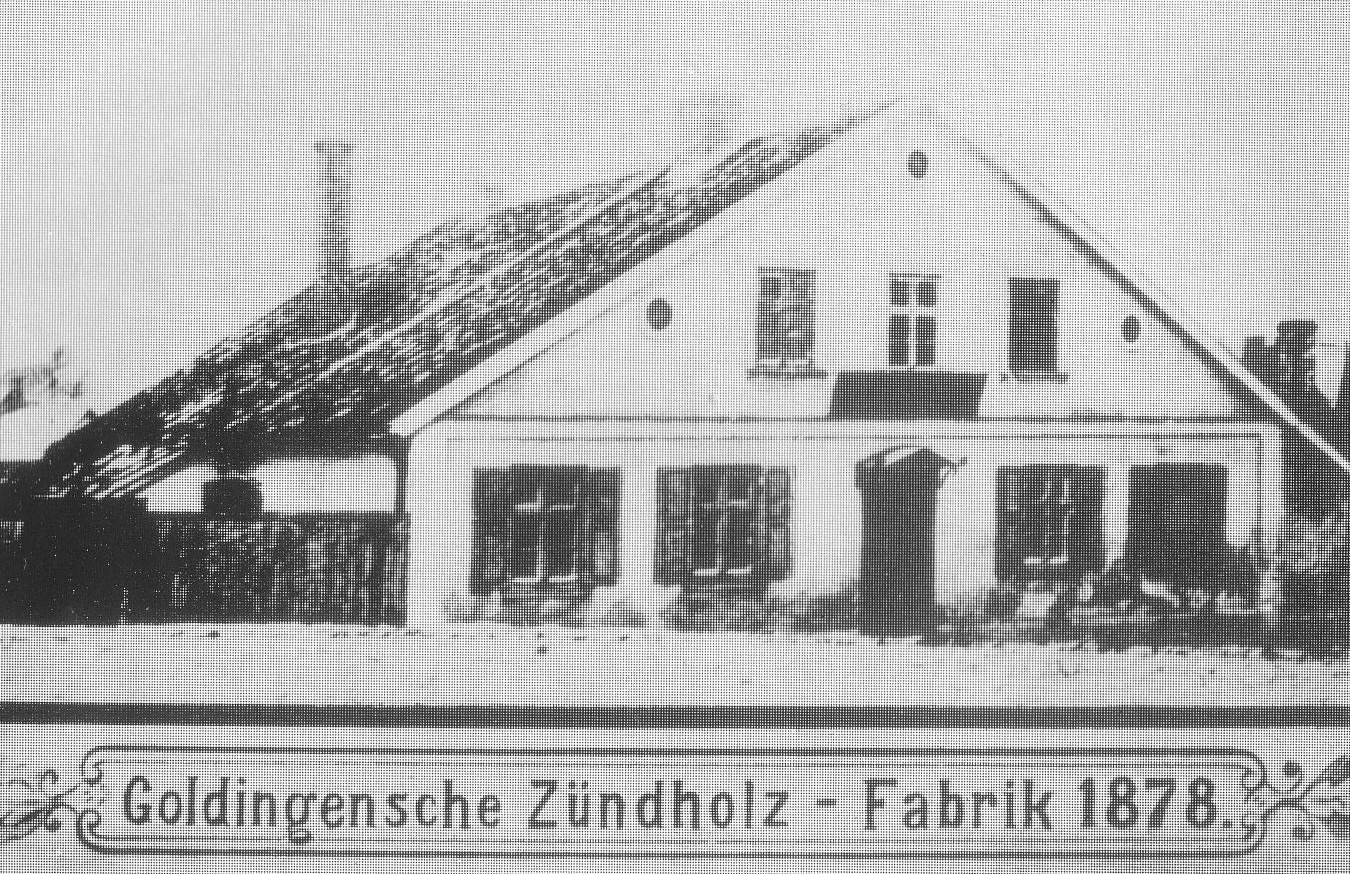
The first building of the factory of safety matches “Vulkāns” at 5 Annas Street. Photo from the book by A. Zīverts about the history of the factory “Vulkāns”.
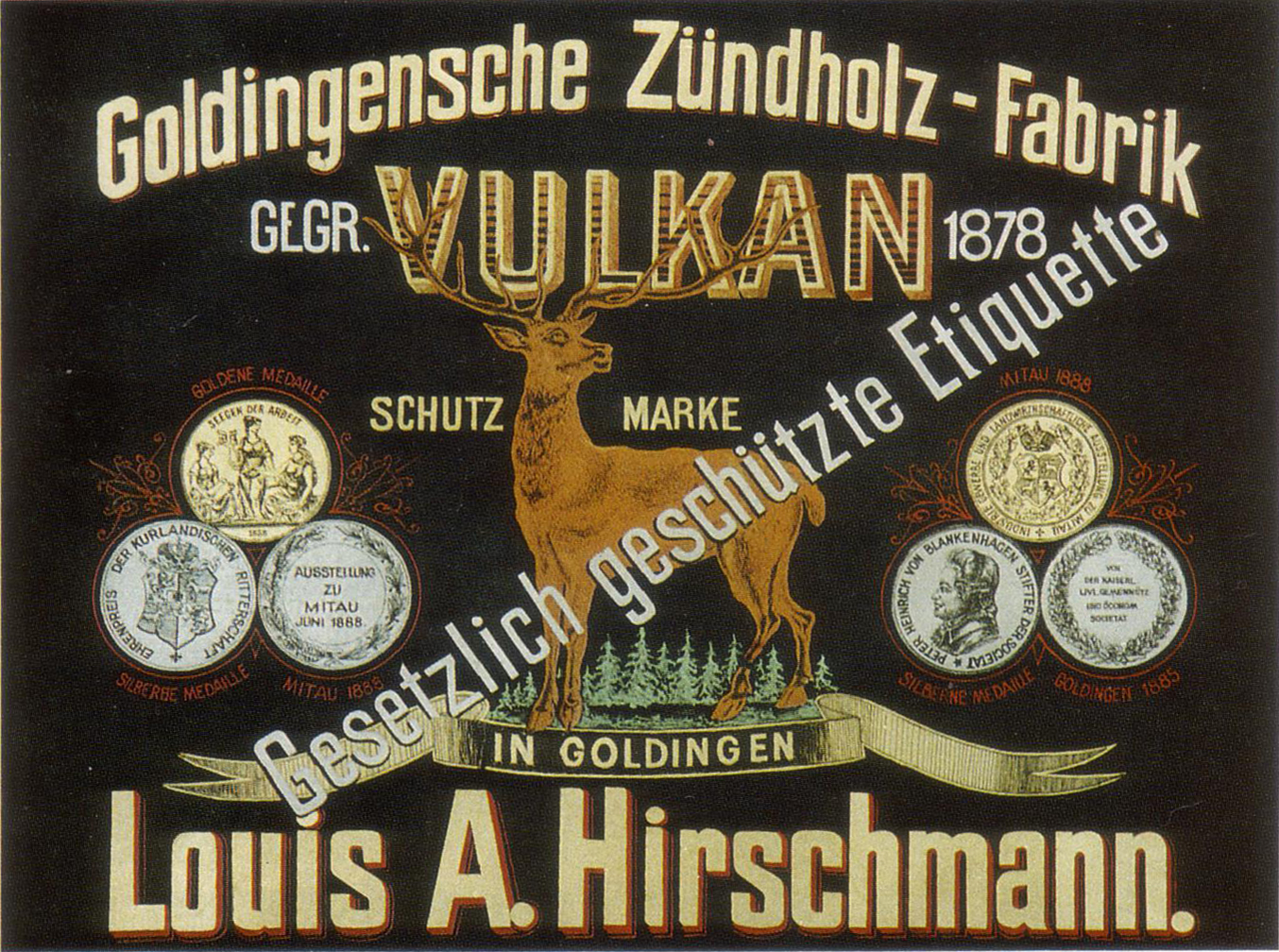
Label of the box of safety matches produced by the factory “Vulkāns”. Photo from the book by A. Zīverts about the history of the factory “Vulkāns”
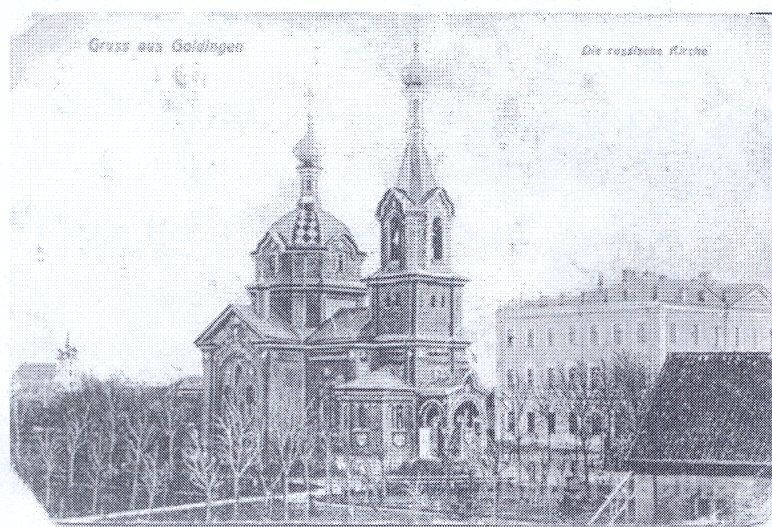
Kuldīga Orthodox Church of the Holy Virgin and Baltic Teachers’ College, beginning of the 20th century – heritage of the Russian Empire in Kuldīga. Collection of Kuldīga District Museum, inventory ID 5778.
The most significant political event in the period during which Kuldīga belonged to the Russian Empire was the 1905 Revolution. The causes of the revolution were many and quite complex, rooted in the controversial nature of the Russian Empire itself in the late 19th and early 20th centuries. The autocracy of the Tsar, on the one hand, and the extensive privileges of the landowners, the German nobles, on the other, created a de facto double national oppression of the population; fast-growing cities were the opposite of the still patriarchal way of life in the countryside; a much higher degree of modernization in the Baltic provinces (which led to the emergence of an educated working class and a legal and educational system) collided with the impossibility of influencing political processes by these new forces under the virtually absolute power of the Tsar. The situation was also destabilized by factors such as Russification and the large number of landless peasants. Society changed rapidly and the outdated political system of the absolute monarchy failed to adapt to the rapid development of new forces and new ideas emerging in society (Lapa 2018, 336 p.). A street and a public park within the nominated property remind people of the events of 1905.
With regard to heritage protection mechanisms, already at the end of the 18th century, fire-safety had become a discussed topic. The town had suffered significant damage due to repetitive fires throughout the 17th century. As the number of inhabitants rose, the density of buildings increased respectively so that any fire would spread easily between houses. This threat could be prevented by prohibiting the building of the traditional thatched roofs. In 1828, regulations were tightened and a decree was issued which required the complete elimination of thatched roofs and their replacement with clay tiles (Melluma 2015, 136). However, the situation did not change over the decades that followed the decree. As a result, the Town Council published compulsory building regulations in 1893 (Melluma 2015, 137). In 1896, it was furthermore ordered for new residential buildings to be built from stone or brick only (Melluma 2015, 136). During this time, the scale of buildings changed and new functions arose in the course of more densified living (multi-apartment blocks, administrative public buildings). The new buildings brought a new construction scale, while still respecting constructions of the previous periods, so that the layout of Kuldīga remained in the state of the 17th and 18th centuries while the number of houses and streets steadily increased. In this time, the brick bridge over the Venta was built. At the same time, the first steps towards institutional monument protection in Latvia were made, when in 1880 and 1888 cultural exhibitions were held in Riga and Jelgava respectively (Dambis 2018, 11).
Kuldīga in World War I (1914-1918)
1914 marked the beginning of one of the most devastating conflicts in human history, which, due to its comprehensive nature and the many countries involved, is called the First World War. The main countries involved in the conflict were united in two blocs. The Entente consisted of the United Kingdom, France and the Russian Empire, while its opponents, the Central Powers or the Quadruple Alliance, consisted of the German Empire, Austro-Hungary, the Ottoman Empire and the Kingdom of Bulgaria.
The territory of Latvia was affected almost immediately by the war, when general mobilization was announced in the Russian Empire. With the start of the war, ethnic tensions intensified. Hatred against the privileges and special position of German landlords over the centuries erupted, and was skillfully promoted by propaganda, and the war against Germany quickly turned into a war against all Germans, including within the Baltic provinces.
In Europe, the war took place on two main fronts: on the western front between Germany and France, and on the eastern front between Germany against Russia. The Eastern Front directly crossed the territory of Latvia. In April 1915, moving forward on the Eastern Front, German troops had occupied Siauliai and reached the borders of Courland. In May, German troops occupied Kuldīga and Aizpute, which they then lost on May 26 as a result of a counterattack by the Russian cavalry, then reoccupied on July 15, without a fight, when the Russian army retreated. Kuldīga and the whole Courland Province remained in German hands until the conclusion of the Brest Litovsk Peace Treaty between Soviet Russia and Germany on March 3, 1918. Therefore, Kuldīga and its surroundings did not experience any significant damage caused by proximity to the front line. It was a different story regarding the loss of population - when the German army occupied Courland, more than 400,000 persons fled (Zariņš 2014, 19p).
A German military administration was established in the conquered territories. Administratively, Courland was one of the districts that belonged to the organizational district of the Commander-in-Chief of the Eastern Front. The administrative centre of Courland region remained Jelgava. The region was divided into districts and Kuldīga was one of the district centres where the district governor and his staff operated. The districts were further subdivided into precincts and Kuldīga District was the largest with 18 precincts (Zariņš 2014, 38-43).
The occupation regime did not change the relative status of Kuldīga in relation to other cities of Courland: Kuldīga was still the centre of its surrounding region, but the administration of the whole district was concentrated in Jelgava and partly also in Liepāja. Like other territories of Courland, Kuldīga lost a large number of inhabitants. Many were drafted into the Russian army and fell in battle, while even more ( forcibly or voluntarily) fled to Vidzeme and further to Russia as refugees. From almost 12,000 inhabitants in the pre-war period, in 1920, the population of Kuldīga decreased by more than half.
Events that were very important for the later history of Latvia took place in the Russian Empire during the time of the First World War. In February 1917, riots broke out in Petrograd due to lack of food. On February 27, Tsar Nicholas II was forced to abdicate. As a result of this February revolution, the Provisional Government of Russia was formed, which planned to hold elections for the All-Russian Constitutional Assembly at the end of the year. However, this did not happen as on October 24-26, the so-called October coup took place, as a result of which the Bolsheviks came to power. This event radically changed the course of Russia's political history and laid the foundations for Soviet rule.
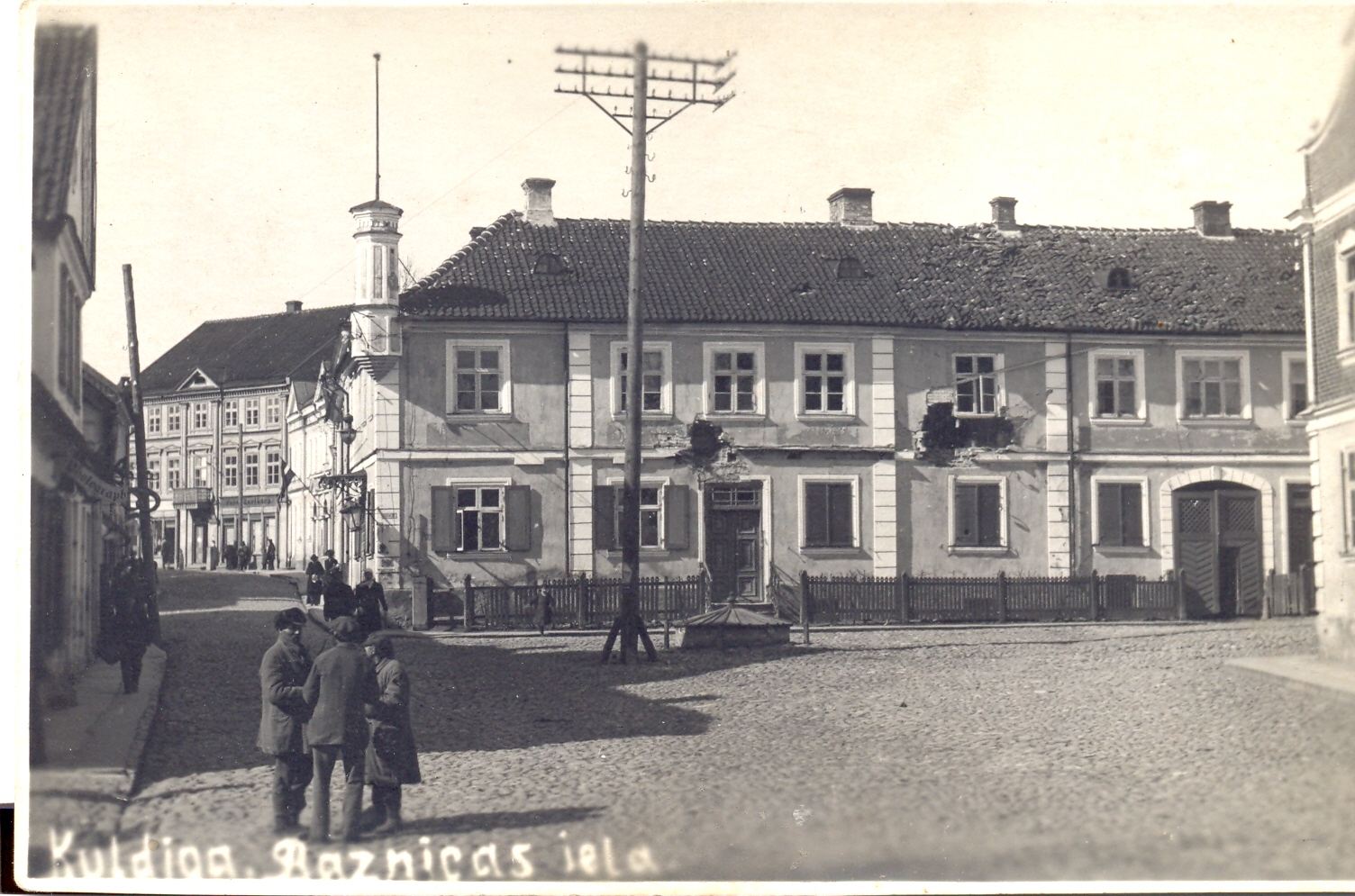
The oldest hay market at Baznīcas Street, 20th century. Collection of Kuldīga District Museum, inventory ID 2536.
Kuldīga in the Republic of Latvia (1918-1940)
At the end of the First World War, three major empires – the German, Austro-Hungarian and Russian empires – collapsed, weakened by the war, and a number of new states emerged in their former territories. Political change took place particularly drastically in the territories of the Russian Empire, and the new states were forced to engage in dramatic conflicts with Bolshevik Soviet Russia, which itself had a civil war for several years.
One week after the end of the First World War, on November 18, 1918, the Republic of Latvia was proclaimed. This declaration of independence was the result of several years of a struggle for power between three essential parties interested in Latvian territory: the German Army, the Russian Bolsheviks and a Latvian National movement (Ludwig, 47). However, Russia did not recognise Latvian independence until 1920, when the Treaty of Riga was signed (Ludwig, 48, 50). In this context, Latvia fought a War of Independence against both its eastern neighbour and German forces for two years after the First World War. During these two years, a large number of armies and armed formations from different countries fought against each other in the territory of Latvia.
At the beginning of 1919, almost the entire territory of Latvia, except for the Liepāja area, fell into the hands of the Bolsheviks, and Soviet Latvia was established. This was the time when Kuldīga was most affected by the War of Independence. In the first months of 1919, the inhabitants of Kuldīga and its surroundings were fully exposed first to the so-called red or Bolshevik terror, then to the terror perpetrated by the German-Balts against all those who were often unjustifiably suspected of cooperating with the Bolshevik authorities. Within a few days after the capture of the town, the Landeswehr killed more than 130 civilians in Kuldīga. The Provisional Government of the proclaimed Republic of Latvia took refuge in Liepāja, which was controlled by the German military authorities. By June, the German army had gradually regained Courland, and at the end of May 1919, it occupied Riga. The Latvian Army was established in July. It fought against the Red Army, but in late 1919 defeated the Western Russian Volunteer Army. At the beginning of 1920, most of the territory of Latgale, which had been in the hands of the Red Army until then, was liberated. As a result of all these complex processes, most of Latvia's territory had finally come under the control of the Provisional Government (Jēkabsons). On November 21, 1919, Kuldīga was completely liberated and from that time a stable administration of Latvian authorities was established in the town.
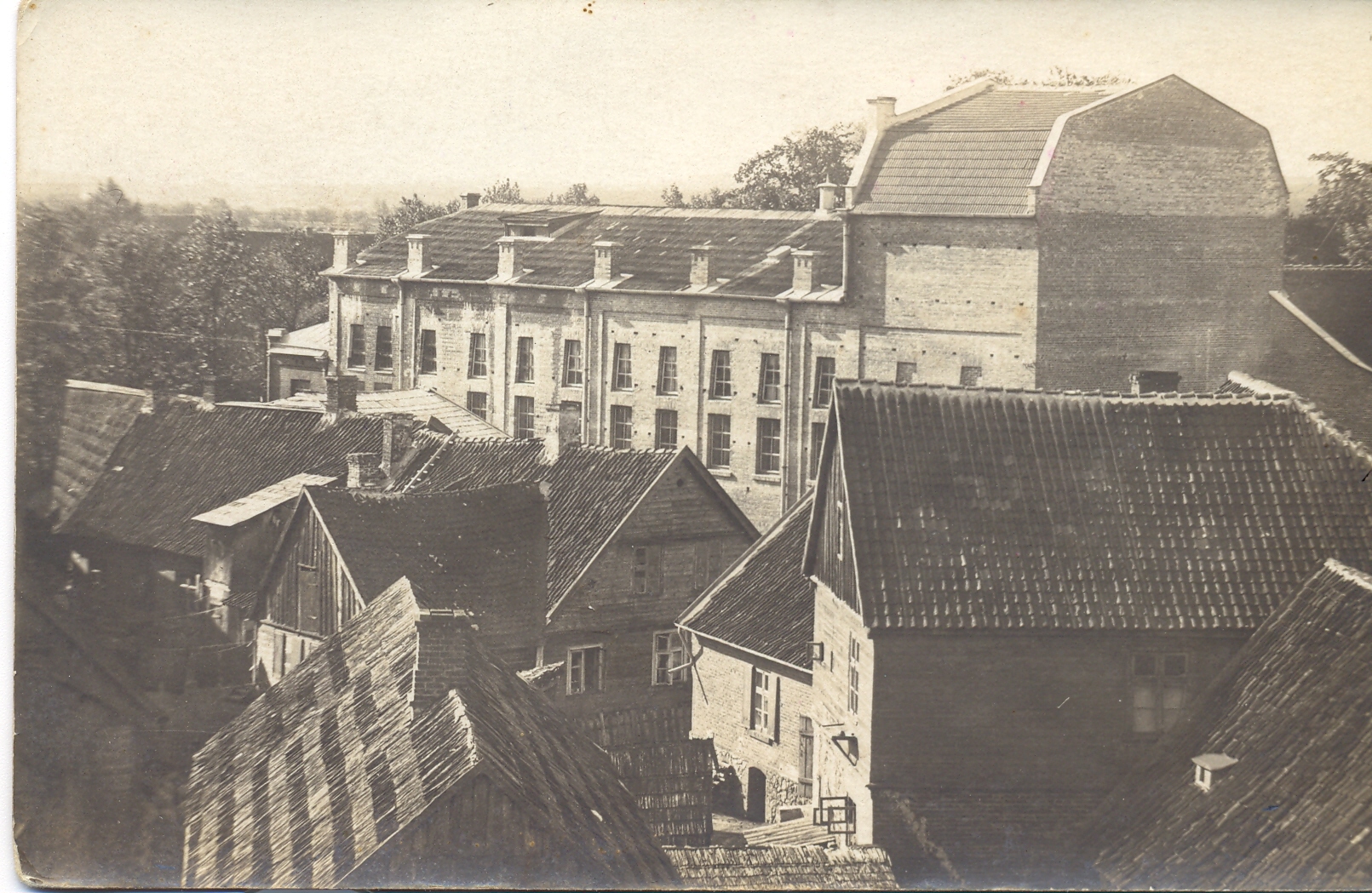
Friendly Society House at 21 Raiņa Street, 1908, by A. Vanags. Picture from the 1920ies. Collection of Kuldīga District Museum, inventory ID 5524.
The period that followed finally made space for Latvian identity. It was the end of foreign domination of the Baltic state, both culturally and economically. Latvians were no longer forced to speak the language of their occupiers (cf. Ludwig, 71). This was a major change for Latvian society whose culture had been suppressed for centuries. Only after the end of the fighting was it possible to focus on the development of the basic principles of the political system of the newly established state. This was done by the Constitutional Assembly appointed in the elections of April 17-18, 1920. It elected 152 members from 16 different parties and the assembly lasted until November 7, 1922. The Constitutional Assembly drafted the Latvian Constitution and several other important laws; abolished the privileges of nobles; developed the principles of agrarian reform; approved national symbols – flag and coat of arms; developed laws concerning the division of the state into districts, as well as social and educational issues. With the Constitutional Assembly, Latvia was established as a parliamentary democracy.
Until the beginning of 1921, Kuldīga’s inhabitants and authorities lived and operated in war and post-war conditions, overcoming food shortages and other social consequences of the protracted war. In the first years after the war, cities did not have the resources to solve even the most critical problems. In February 1921, Kuldīga received a government loan, which was used to purchase food. This fact confirms the difficult situation in the town during the first years of independence of the Republic of Latvia.
After overcoming the damage caused by the protracted war, in the following years, as a town of the Republic of Latvia, Kuldīga had a time of stability and peaceful development. The population of Kuldīga gradually increased again after the tragic loss of people of the First World War and the War of Independence. In 1925, the population of Kuldīga was already close to 7,000 and with small fluctuations it remained so until the Second World War.
In the mid-1920s, Kuldīga was still almost isolated from other settlements in Latvia due to poor land roads and the lack of railways. In 1926, the most urgent problem was solved - the two spans of the bridge over the Venta, which were blown up during the First World War, one example of the remarkably light physical damage to the town, were restored, and the temporary wooden structures that had replaced them had already worn out and become unsafe (Krastiņš 2013, 215). The next step in ensuring more convenient freight and passenger traffic with Kuldīga was the construction of a good road to Skrunda, which was one of the nearest railway stations. The highway was inaugurated in 1936. After various plans to build a railway connection to Kuldīga, an extension of the Liepaja-Alsunga railway was opened in 1935. A separate rail branch was built to the factory Vulkāns (Krastiņš 2013, 227-229). The establishment of railway traffic to Kuldīga greatly facilitated the transport of residents and especially goods to and from Kuldīga, providing a stable opportunity to get to and from Kuldīga in all seasons. The availability of imported goods in and around Kuldīga increased significantly, and the prices of these goods decreased. It was much easier for the farmers in the area to deliver their produce to the town. The transportation costs of goods produced in Kuldīga decreased incomparably.
In June 1924, the Saeima of the Republic of Latvia passed a law on the division of the territory of Latvia into districts, establishing 19 districts in Latvia, which in turn consisted of smaller territorial units - areas. The cities themselves formed separate administrative units, separated from the rural areas. Even after this division, the town of Kuldīga still, as before the First World War, retained its status as the centre of its immediate surroundings. The number of rural areas changed slightly over time. In 1935, there were 20 rural areas in Kuldīga District: Ciecere, Gaiķi, Īvande, Kabile, Kuldīga, Kurmāle, Kursīši, Lutriņi, Padure, Pampāli, Planica, Raņķi, Renda, Saldus, Sātiņi, Skrunda, Snēpele, Turlava, Vārme, Zvārde (Salnais 1935, 325).
In the 1930s, the country’s economy boomed and could be compared to that of the Kingdom of Sweden (Ludwig, 93). Demographically, the percentage of Latvian citizens increased while that of German and Russian citizens, who traditionally had made up a big proportion of the overall population, decreased significantly (cf. Ludwig, 80). Parliamentary democracy in Latvia was interrupted by a coup d'état organized by Kārlis Ulmanis on the night of May 15-16, 1934. The Saeima was dismissed, all political parties were liquidated, members of other parties were arrested and a number of press publications were closed. In fact, Prime Minister Kārlis Ulmanis became the sole head of state. The coming to power of the authoritarian regime was not unique to Latvia. From the second half of the 1920s, and especially in the 1930s, the authoritarian model of public administration in many Central and Eastern European countries, including the Baltic States, has gradually become increasingly popular and more or less authoritarian regimes have come to power in many places.
In 1930, there were 868 buildings in Kuldīga, of which more than half – 487 – were stone buildings (Krastiņš 2013, 54). Most of the buildings – 752 – had only one floor (Salnais 1936, 57). At this time, the town had an active economic and cultural life. In 1936, the town incorporated almost 370 different larger and smaller trade and service institutions.
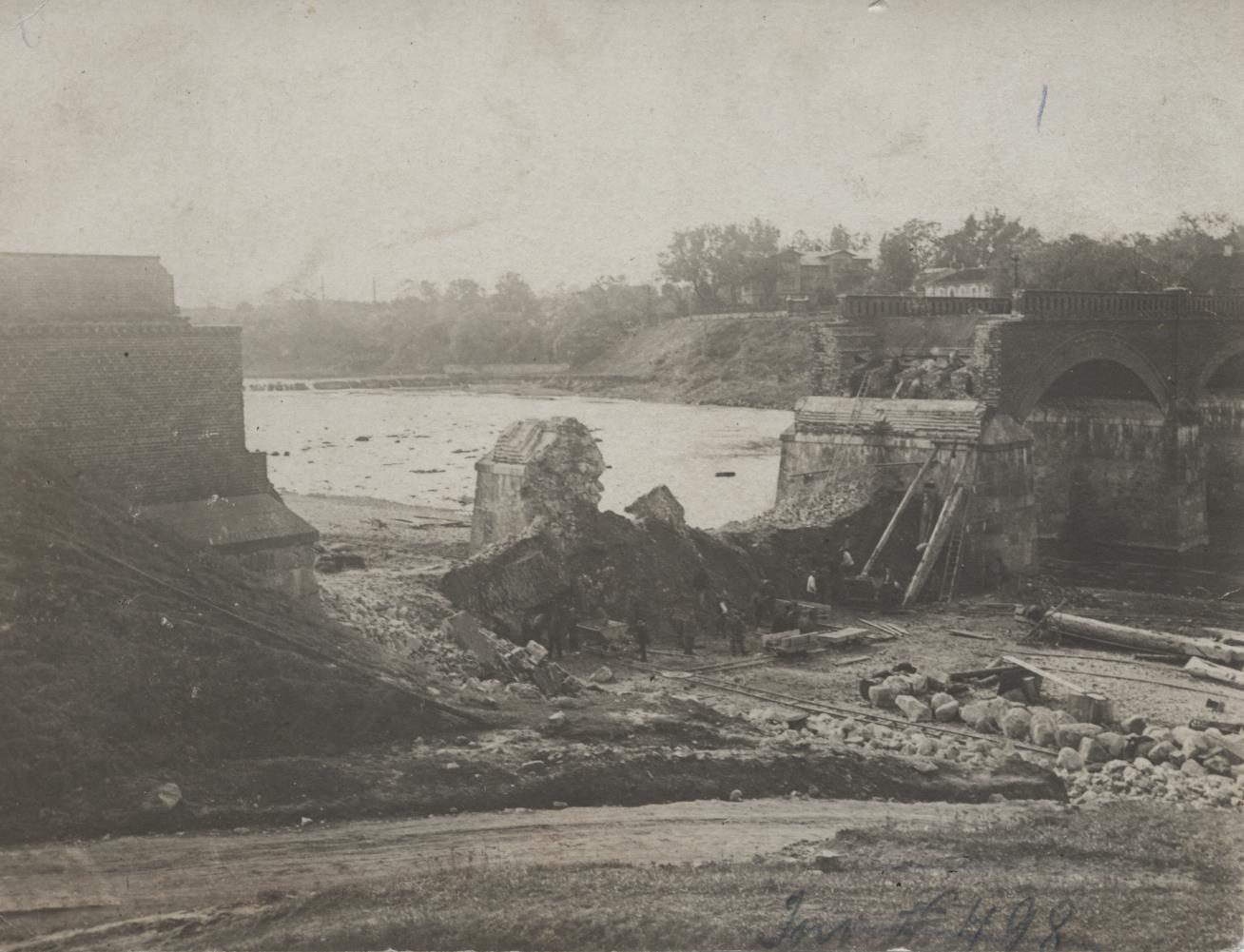
Mūra tilts pār Ventu Kuldīgā pēc uzspridzināšanas 1915. gadā. Attēls no Kuldīgas novada muzeja krājuma, inventāra Nr 8269.
In the second half of the 1930s, during the regime of Ulmanis, the construction of public buildings and improvement of public spaces in cities took place throughout Latvia, including in Kuldīga. Several new public buildings from brick were built in Kuldīga, which we still see in the town today.
Regarding monument protection, this period marks the beginning of conscious heritage protection in Latvia. In 1922, the Society for Antiquities was founded. In the same year, a first set of regulations regarding monument protection, the “Regulations on the Management of Building and Construction Machinery Matters”, was published (Melluma 2015, 174). One year later, the Board of Monuments was established and the first law on monument protection was adopted (Dambis 2018, 14). This resulted in the first inscriptions of cultural heritage onto a national list: In 1924, the first three heritage sites considered worthy of protection were decided upon (ibid.). Within the first 20 years after the establishment of a regulated monument protection system, over 200 architectural sites were inscribed on the Monument List (ibid.). In the meanwhile, the discourse surrounding heritage and its restoration widened. The “Regulations on the Protection of Monuments” published in 1932 discussed a wide range of archaeological, ethnographic, architectural, artistic and historical cultural monuments (Melluma 2015, 176).
Mirroring the respective development on the national level, heritage protection became increasingly important also in Kuldīga with the beginning of the 20th century. While in the period of the Russian Empire renovations had been made only where absolutely necessary, and not many accounts of such procedures exist, in 1922, the Town Council of Kuldīga published regulations which prohibited acts of vandalism with regard to “remnants from the past”, hence giving additional attention to heritage buildings and raising awareness for their significance for modern society (Melluma 2015, 175). The institutionalization of heritage protection over time has produced a series of legal mechanisms to protect the heritage values of the site. At present, it is assumed that the oldest town development plan of Kuldīga dates back to 1928 (Melluma 2015, 121).
Kuldīga in World War II (1940-1945)
From the early 20th century, the city mostly expanded outside of the nominated property. However, constructions within the limitations of the nominated area became necessary in some areas due to the world wars. The biggest loss of buildings happened in the Second World War, when the Jewish quarter around Street of 1905 was bombarded. This area is now a public park.
The fate of Latvia in the Second World War was determined by the Non-Aggression Pact signed between Germany and the USSR on August 23, 1939, which has historically become known as the Molotov-Ribbentrop Pact or Hitler-Stalin Pact. The treaty guaranteed the neutrality of the USSR in the event of Germany attacking Poland or the Allies, but its secret annex divided Europe into spheres of influence, leaving the Baltic States under the sphere of influence of the USSR. In September 1939, the USSR demanded that the three Baltic States and Finland sign mutual assistance agreements with the USSR, which, among other provisions, forced them to allow a large number of Soviet soldiers into their countries. Latvia was forced to sign the treaty on October 5, and at least 25,000 Soviet soldiers were brought into Latvia (Klišāns 2018, 297). In the summer of 1940, the USSR continued to put pressure on the Baltic states, and submitted an ultimatum to the Latvian government to resign, to form a new government with persons nominated by the USSR and to allow an unlimited amount of Soviet troops into Latvia. In a few days, the Red Army occupied the entire territory of Latvia and a puppet government appointed by the occupying power was formed under the leadership of A. Kirhenstein. Extensive repression took place during the occupation, including the arrest of more than 15,400 Latvian civilians on the night of June 13-14, 1941, and their deportation to remote regions of the USSR, mainly Siberia.
The Soviet occupation of Latvia was interrupted by the arrival of German troops. Between June 22 and July 8, Nazi German forces gradually conquered the entire territory of Latvia. The Reich Commissariat of Ostland was established to govern the German-occupied territories, a civilian and military administration that included all three Baltic States and part of Belarus. Latvia formed one of the general districts of this territory, which was governed by an administration under the German Commissioner General. The period of German occupation was characterized by repression, the Holocaust, as well as the mobilization of about 110,000 Latvians for service in various military structures: the legion, police battalions, the Air Force Auxiliary Service, etc.
In July 1944, the Red Army's attacks on the territory of Latvia resumed and by October most of the territory of Latvia had fallen back into the hands of the Soviet forces. The exception was Courland, in the territory where German troops (including several Latvian units) remained under siege until the end of the war and the capitulation of Germany on May 8, 1945. After the end of the war, the fighting in Courland continued in the form of a guerrilla war.
After the Second World War, the Baltic States remained occupied by the USSR. In the last years of the war, as the Red Army attack approached, about 170,000 or more Latvians had fled to Sweden and Germany, from where they moved to various Western European countries, the United States, Canada, Australia and South America after the war, forming an organized Latvian diaspora. These Latvians are usually called Latvians in exile. Part of the diplomatic service of the Republic of Latvia also continued to operate abroad.
The people of Kuldīga were severely affected by the repression carried out by the two regimes that occupied Latvia during the Second World War. The Soviet regime repressed the political, military, economic and intellectual elite of the Republic of Latvia, as well as against all supporters of the democratic state immediately after the occupation of Latvia in June 1940. Initially, officials were simply fired, but from the autumn of 1940, arrests continued to rise. The criteria of persons subject to repression were unclear, as practically anyone who had held a position in a state institution or worked in a public organization during the Republic of Latvia could be arrested and charged with opposing the Soviet regime (Vīksne 2013, 397). The repression culminated in the mass deportations of June 14, 1941.
During the deportations carried out by the Soviet regime on the night of June 13-14, 1941, 623 people were deported from the town and district of Kuldīga. While the fate of many of these deportees is not known, many were settled in Siberia, in various districts of Krasnoyarsk Region. While a small number were released as early as 1947, most were only freed between 1954 and 1958, after Stalin's death, when the Soviet regime became less repressive. Many died in the deportations. The deportees included people of both sexes and all ages, including children and the elderly.
The next wave of repression reached the people of Kuldīga with the arrival of Nazi German occupation forces on July 1, 1941. With the arrival of the new regime, there was a retaliation against all those suspected of cooperating with the Soviet authorities. Detainees were often immediately shot without trial. Family members of Soviet activists who fled to the USSR were arrested.
As elsewhere in the territories controlled by Nazi Germany, the extermination of the Jews or the Holocaust took place in and around Kuldīga. Before the war, 646 Jews (about 9% of the city's population) lived in Kuldīga. Another 329 Jews lived in Saldus, a smaller number in the countryside. At the beginning of the war, only about one-tenth of the Jews had left the town. The arrests of Jews began as early as July 1941, and in late July-early August, on the instructions of the German authorities, all imprisoned Jews were taken in stages to shooting ranges in the forests around Kuldīga and killed. Jews in Saldus were also killed most likely at the end of July. In total, about 1,000 Jews were killed in Kuldīga District (Urtāns, 118-136).
Soviet Kuldīga (1945-1990)
After the Second World War, Latvia (as well as Lithuania and Estonia) was illegally incorporated into the Soviet Union, as a result of military occupation and falsified elections, and became the Soviet Socialist Republic of Latvia. Formally, the Latvian SSR was a sovereign republic, but in fact it was under the full control of the Soviet Union, and in Latvia the structures of power of the Soviet Union were fully controlled. Most western democracies, led by the United States, did not recognize the legitimacy of the incorporation of the Baltic States into the USSR and continued to de jure recognize the democratic republics of Latvia, Lithuania and Estonia, so the Baltic States continued to exist legally during the occupation. On this basis, Latvian embassies continued to operate in the United States and Great Britain until the restoration of Latvia's independence. Latvians in exile around the world also actively advocated the restoration of the independence of the Baltic States and the right of the Baltics to decide their own political system.
The territory of Latvia was part of the Soviet Union for more than 50 years and immediately after the end of the war it was subjected to Sovietization, meaning full integration into the USSR’s political, cultural, administrative and economic system. Sovietization was achieved through various instruments, including ideology and propaganda, but the main method was terror and threats (see Bleiere 2013), in particular, repression against existing or potential opponents of the regime was carried out until the death of Joseph Stalin in 1953.
During the Soviet occupation, the administrative division of the territory of Latvia was completely changed, subjecting it to the interests of centralized economic planning and management. In 1950, the existing counties and parishes of Latvia were abolished and a total of 58 districts were established. Kuldīga still retained its status as a centre, becoming the centre of Kuldīga District. The new Kuldīga District was territorially smaller than the previous county, because Saldus and Skrunda districts were separated from it. In the 1950s and early 1960s, the boundaries of the districts were changed several times, merging several districts. In 1956, a part of Alsunga District was added to Kuldīga District, and in 1959 a part of Skrunda District. The districts were further divided into villages. In Kuldīga District, after the establishing of the district borders, there were 15 villages.
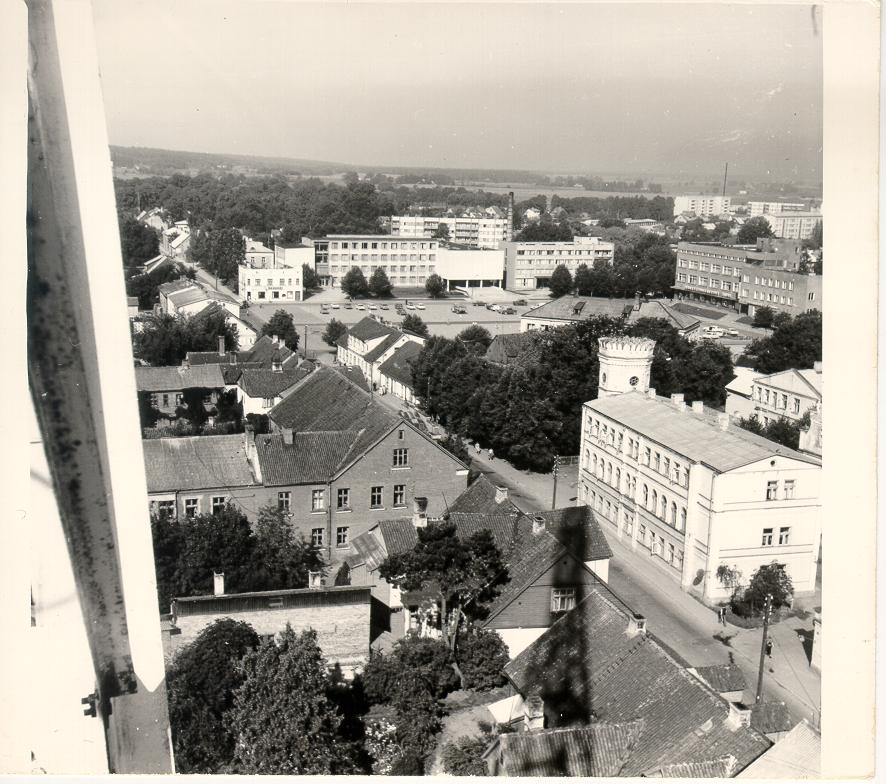
Town Square and Liepājas Street, view from the police tower at 26 Liepājas Street, 1978. Photo from the archive of Kuldīga Municipality Building Authority.
During the Soviet era, Kuldīga not only became part of the new administrative system, but also acquired the visual features and name characteristic of a Soviet town. Many town streets were renamed as early as the late 1940s to suit occupation regime. The introduction of the regime's glorified "bright future" into the town's architecture also took place on a large scale. Typical examples of modern Soviet-era architecture can be seen, for example, on the sides of Kuldīga Town Square which lies outside of the nominated property. Soviet-era buildings, like the Soviet style of management and administration, generally disregarded historical building traditions, the visual fit of buildings into the landscape, or the scale of existing buildings. However, the Soviet approach to heritage preservation fortunately did not harm the legacy of the Duchy of Courland and Semigallia that can be found in Kuldīga. On the contrary, the period of the Latvian Soviet Socialist Republic had a significant impact on the development of monument protection in Latvia. Generally, Soviet monument protection was a political instrument which used both preservation and deterioration as targeted political statements (Mintaurs 2017, 153). Heritage restoration was not executed for its own sake, rather it was used as a tool for the conveyance of political messages. Aija Melluma writes that during Soviet times, cultural heritage was “used for the communistic and aesthetic education of the population” (Melluma 2015, 167).
During the time of the Latvian Soviet Socialist Republic there were three different levels of heritage protection, with monuments considered worthy of protection categorised into All-Union, Republican or local significance (Mintaurs, 157). Monuments of All-Union significance were prioritized and more likely to be restored properly. After the Second World War, the Board that replaced the former Monument Board evaluated all of the monuments that until then had been put under protection (Melluma 2015, 176). In 1948, the Council of Ministers of the Latvian Soviet Socialist Republic decided to improve measures of cultural heritage protection (Dambis 2018, 16). In the same year, the first development plan of Kuldīga during Soviet times was issued: The General Plan of Construction in Kuldīga (Melluma 2015, 142, 157). A review of this plan by the national Monument Protection Department highlighted that street widenings within the historical network be executed only “where it is particularly required” and that Alekšupīte be preserved (Melluma 2015, 165). Furthermore, it was specifically recommended to preserve the buildings at 17 Liepājas Street, 2, 4, 6, 7, 10 and 14 Baznīcas Street, 23 Kalna Street, 8 Pasta Street and 20 Ventspils Street (ibid.). Today, six of these buildings contribute to the Outstanding Universal Value of the property. The review limited the demolition of buildings to absolute necessity. Considering the political intentions of heritage protection in the Soviet era, this document is important to understand the modern state of conservation of the property, as it represents key decisions leading to the preservation of Kuldīga rather than its demolition. Already before that time, the intention of adding monuments to the List of Republican Significance were made. However, it took until 1952 before the USSR finally accepted additions to such a list for the first time. The proposed number of 670 monuments was lowered to 343 inscriptions. In the following decades the list was adjusted multiple times, both adding and deleting protected sites (Mintaurs, 159).
The first eighteen town centres were put under monument protection in 1967 (Mintaur, 169). The town centre of Kuldīga was added in 1969. This development had a direct impact on the town centre as construction and development projects now underlay the "Regulations on State Protection Zone and Building Regulation Zone in Cities of the Latvian SSR". Since 1969, the dimensions of the protection granted to the urban construction monument of Kuldīga has been continuously developed further. Since this initial period of institutional heritage protection in Kuldīga, for the preservation of the original substance of the old town of Kuldīga and the creation of new sites in the old town area, construction has long been governed by modern and competitive building rules, which set out in detail the requirements for the maintenance and renovation of buildings. Despite this development marking an important state of the increasing awareness for heritage protection also under Soviet rule, in the 1980s, a majority of historical buildings throughout Latvia were described to be in a state of decay. Only the “most important” monuments on Soviet territory were restored, leading to a gap between heritage monuments in need of restoration and those restored. With regard to the Duchy of Courland and Semigallia, the only building considered worthy of restoration at this particular time was Rundāle Palace, which was built by Duke Ernst Johann Biron in the 18th century and which is one of the finest representations of baroque architecture in the Baltic states (Mintaurs, 161; Lancmanis 2016, 9).
The Soviet restoration policies were based mainly on practicality. For the decision concerning the worthiness of a building to be preserved or restored, it was primarily to consider whether the building could be used for practical purposes thereafter (Mintaur, 162). This is further illustrated when looking at manors and sacral buildings: Latvian churches were used for a broad range of purposes such as cinemas, navy bases or warehouses (Mintaur, 165). The interiors were often looted. With regard to manors the situation was different. Already before the Soviet period they were often used as schools. After the Second World War, they were turned into agricultural facilities (Mintaur, 167). This implied the extension of buildings as well as the adjustment of their surrounding landscape (ibid).
A third development plan of Kuldīga evolved in 1973 where it was confirmed once more that new buildings should blend into the earlier composition of the town and that the “common character of architectural forms and materials” should be maintained (Melluma 2015, 169 f.). In the course of this plan’s revision, experts demanded further research regarding future use and preservation measures regarding the buildings in the protection zone as well as planning investments for preservation works (Melluma 2015, 171). This was reconfirmed by the 1977 building regulations which include detailed requirements limiting the maximum height of new centrally located residential buildings to two storeys and further defining guidelines concerning facades, roofs and doors, both with regard to material and design (Melluma 2015, 172). Hence, the assurance of the sustainability of Kuldīga’s old town buildings was also continued in Soviet times.
The situation of monument protection within the Soviet times changed in the 1980s, when the restoration of Riga was initiated and funding for monument protection increased. During this time, there were two approaches to restoration efforts. One practice was solely to preserve the most important buildings and to demolish everything else to save money. Another approach was that of promoting more in-depth research to avoid demolishing historically significant architecture (Mintaur, 162 f.). Within the Latvian Soviet Socialist Republic, a series of town planning documents were established in accordance with the Building Norms and Regulations of the Soviet Union (Melluma 2015, 142). These plans were edited regularly and showed a stronger focus on heritage protection over the years. In 1989, these norms implied an obligation to identify zones for the preservation of cultural monuments, for landscape preservation as well as for building regulation (Melluma 2015, 145).
Kuldīga in the restored Republic of Latvia
National resistance to the occupation regime continued in Latvia throughout the Soviet occupation. Latvians living in exile also actively tried to promote the reconstruction of the Republic of Latvia, but in reality, political change in the Baltic States was not possible without serious changes in the entire Soviet Union.
Such changes began to take place in the Soviet Union in 1985, when Mikhail Gorbachev became Secretary General of the Central Committee of the Communist Party of the Soviet Union (CPSU Central Committee). He tried to solve the critical internal problems of the USSR by changing certain ideological positions and elements of the political system: in 1987 a new development program of the Soviet Union was announced, which became known by its Russian words "perestroika" and "glasnost".
After the proclamation of the new principles, several dozen organizations quickly formed in the Baltic States, many of which allowed themselves to do what was previously impossible - to express criticism of the Soviet regime. This was evident in the plenary session of the Latvian SSR creative unions in Riga, which took place on June 1-2, 1988, where the problems of Latvia and the Latvian people were discussed in an unprecedented way.
Due to the ideas activated by the Plenary Session, the Latvian National Independence Movement (LNIM) was founded in the summer of 1988, followed a little later in the autumn by the Latvian Popular Front (LPF). The LPF turned into a mass socio-political organization, which initially set the goal of establishing Latvia as a democratic and legal state within the USSR, then at its second congress in the autumn of 1989 declared its goal to be the complete restoration of independence. The second largest movement, the LNIM, had declared its goal of restoring independence as early as spring 1989. As a result of the general democratization process, in the autumn of 1988, the use of the previously prohibited symbols of the Republic of Latvia was allowed.
In the elections of the Supreme Council of the Latvian SSR (SC) held on March 18, 1990, the LPF started with the goal of an “independent Latvian state that continues and develops the democratic and parliamentary traditions of the Republic of Latvia” and won convincingly, winning around two-thirds of the vote. The majority of votes in the Supreme Council allowed to achieve this goal, and on May 4, 1990, the SC adopted a declaration "On the Restoration of the Independence of the Republic of Latvia". The May 4 declaration established a transitional period for the gradual implementation of the restoration of independence, during which the operation of the Constitution of the Republic of Latvia was partially restored and the supreme power belonged to the Supreme Council. Institutions directly subordinated to the USSR (the KGB, prosecutor's office, military and militia structures, etc.) also continued to operate in Latvia during the transition period.
The situation in the Baltic States was unstable and worsened in January 1991. On January 13 in Vilnius, USSR military structures tried to restore Soviet power in Lithuania, attacking unarmed demonstrators. Thirteen civilians died. After the bloody events in Vilnius, it was clear that similar actions by opponents of Latvia's independence were possible in Latvia. Therefore, on January 13, barricades were built around the most important state and public objects in Rīga. Concrete blocks and logs were brought in, and accesses to buildings was blocked with agricultural machinery and trucks. In Kuldīga, such objects were the post office and the radio station. Kuldīga radio station was especially important (besides Rīga and Kuldīga, there were also radio stations in Valmiera, Cesvaine, Daugavpils, Liepāja and Rēzekne), as it was intended to take over broadcasting if Latvian Radio in Rīga was taken over. Broadcasts from Kuldīga radio station about what was happening in Latvia could also be heard in Sweden.
On August 19, 1991, Moscow's conservative Communist Party and army leaders sought to seize power to halt Gorbachev's democratization and structural transformation processes in the USSR. However, the perpetrators of the coup faced significant opposition and were unable to take full power. The coup lasted for three days, from August 19 to 21. In Latvia, Soviet militia special units tried to seize power, including occupying Latvian Television and other state and public buildings. As the USSR did not have legal power at that time, on August 21 the Supreme Council of Latvia adopted the Constitutional Law “On the State Status of the Republic of Latvia”, which stipulated that the transitional period declared on May 4, 1990 had expired and the operation of the Satversme (Constitution) of 1922 was resumed, as further negotiations with the Soviet authorities on the restoration of independence were no longer possible. Shortly after the law was passed, it became known that the coup in Moscow had ended unsuccessfully. The independence of the Republic of Latvia was restored.
International recognition by other countries was critical to strengthening renewed independence. The first country to recognize the restoration of Latvia's independence was Iceland on August 22, followed by Denmark and the countries of the European Community, the Russian SFSR on August 24 and the USA in early September. By the time of the adoption of the Constitutional Law at the end of 1991, the restoration of Latvia's independence and national independence has been recognized by a total of 93 countries. The USSR formally ceased to exist on December 26, 1991.
With the restoration of independence and the proclamation of the Republic of Latvia in 1991, monument protection started gaining more importance. Latvia was the first post-Soviet nation to establish heritage legislation when it adopted the “Law on the protection of cultural monuments” in 1992 (Dambis 2018, 22). This law is currently the main document in the field of Latvian heritage protection and will be discussed in more detail in section 5, along with other documents of Latvian heritage legislation.
From the beginning, the republic aimed at orienting itself towards European best practice in heritage protection (Dambis 2018, 22). Consequently, Latvia has cooperated with many European countries and since the beginning of the millennium it has organised conferences and workshops to train heritage experts (Dambis 2018, 22 ff.). Strong cooperation can be mentioned especially in the Scandinavian context. The Norwegian Directorate for Cultural Heritage cooperated in the restoration of Kuldīga Old Town Hall also the Swedish National Heritage Board plays a major role in the development of Latvian heritage expertise (ibid.).
Four years after the establishment of independence, in 1995, Latvia ratified the UNESCO World Heritage Convention. Its first World Heritage site, the Historic Centre of Riga, was inscribed in 1997. In 1998, heritage professionals started cooperating with mass media to generate a broader interest in the heritage protection field. Beginning in 2000, there were weekly reports on monument protection on TV, the radio and in newspapers for three consecutive years (Dambis 2018, 46). Although the general situation with regard to heritage protection has improved enormously since the beginning of the 21st century, the 2009 economic crisis impacted heritage protection in Latvia, as the budget for heritage protection was severely cut (Dambis 2018, 26). In 2014, the Cultural Policy Guidelines 2014-2020 “Creative Latvia” declared the economic crisis to be overcome and developed strategies to strengthen the cultural sector again (Cabinet of Ministers 2014, 9).
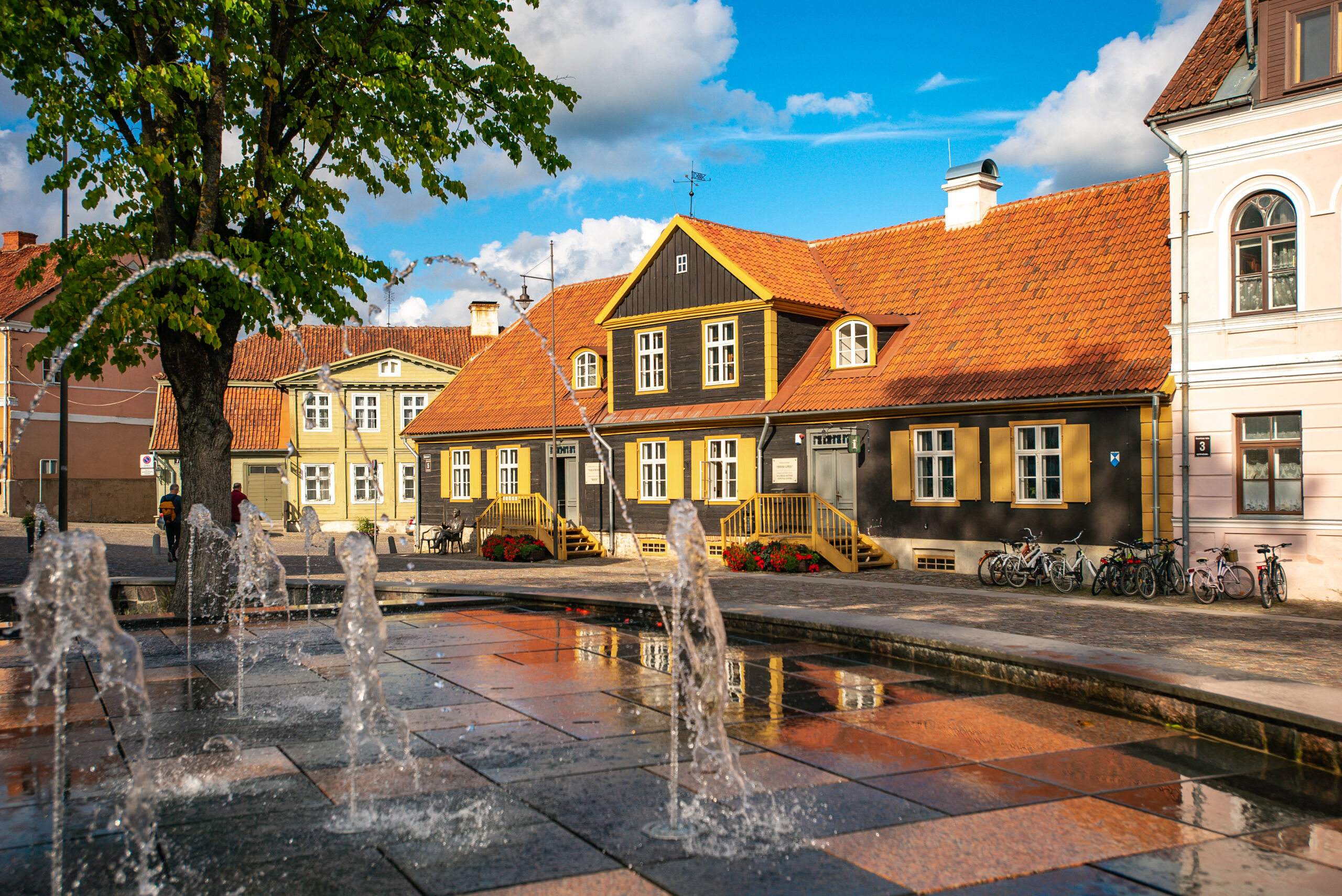
Since 2008, when a number of competent specialists in the field started their work in the municipality of Kuldīga, rescue and conservation works have been carried out successfully in a number of old town buildings. In 2010, with substantial support from EEA and Norwegian financial instruments, Kuldīga Restoration Centre was established. It implemented a number of important conservation programmes for wooden buildings and parts of wood buildings in the period up to 2018, attracting funding from both national and international funds. In 2018, the activities of the restoration centre reached a new level by extending its operational capacity, when the local government restored a whole building in the old town of Kuldīga for the needs of the centre. It includes a well-designed and equipped workshop for restoration of wooden parts of the buildings with a painting section, a modern educational centre and office premises for the specialists of the centre. An important area of activity of the centre is attracting funding for the conservation of particularly valuable architectural parts and elements that allows craftspeople from the centre and its associated craftspeople to perform correct and modern restoration works.
Kuldīga Restoration Centre serves as a point of contact for the residents of the old town of Kuldīga, owners of the buildings, local business people, builders, architects and craftspeople regarding issues related to the maintenance, renovation and restoration of historic buildings. By organising adult education activities, the centre explains the importance of using traditional construction techniques to ensure the sustainability of buildings and promotes the use of traditional construction materials. The centre's specialists restore unique elements of wood buildings that serve as exemplary examples in the old-town environment, and attract funding for rescuing these building parts and consult and provide advice to craftspeople in the course of the restoration process. Action at both local and international level actively promotes the identity of the property to people who have the sense of belonging to the old town of Kuldīga. The Restoration Centre is described in more detail in Chapter 4: State of Conservation.
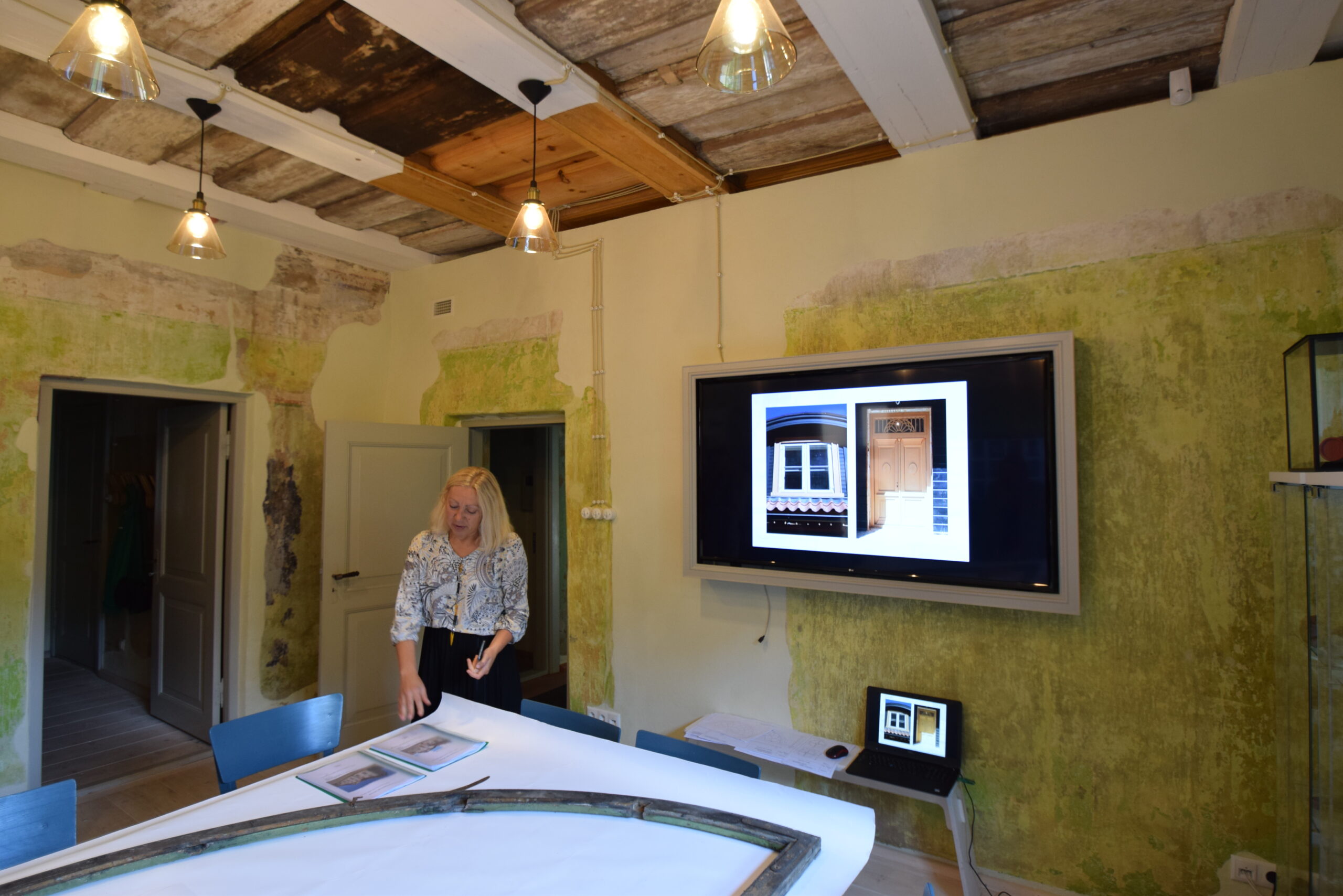
Restoration of the wooden elements of the buildings is based upon decent study of the details. Photo from the archive of Kuldīga Municipality, 2019.
In 2014, the territory of the urban construction monument of state importance, “The historic centre of Kuldīga”, was further specified to include the part of the town located on the left bank of the Venta, and especially along Ventspils, Liepājas and Jelgava Streets. The monument includes the spatial environment of Kuldīga along with the urban layout as well as architectural elements. It is defined that the values that are to be preserved in the context of Kuldīga must integrate “building design structure, spatial layout, landscape and scale, panoramas and silhouettes, greenery system, plot construction and spatial layout, spatial organisation of quarters, cultural layer of ancient buildings, characteristic terrain and waters” (Management Plan 2020).
The interplay of the varied heritage protection mechanisms resulted in the property of Kuldīga / Goldingen in Courland being preserved in an excellent condition to the highest international standards. As discussed in more detail in Section 3, the site incorporates authentic elements of urban, architectural, landscape and scenic importance that together shape the narrative of the Duchy of Courland and Semigallia. Attributes of all major categories exist for all of the aforementioned districts of the town and tangibly illustrate the heritage of the different stages of development of the urban setting in the context of the political and economic expansion of the duchy. Currently, the town of Kuldīga has 90 state-protected monuments, including archaeological, architectural and urban planning monuments. This includes “The Historical Centre of the Town of Kuldīga”, which is registered as an Urban Construction Monument under national protection number 7435, and “Old Town of Kuldīga”, an archaeological monument. Whereas parts of the urban construction monument lie outside of the nominated property (and within its buffer zone), around 90% of the archaeological monument are within the borders of the nominated property. Hence, the property presented in this nomination is already subject to a range of laws and restrictions.
A number of awards recognise the exceptional efforts that have been made in the context of heritage protection in Kuldīga. The Town General Plan of 1973 with its recommendation of a strict continuation of architectural traditions was nominated as a candidate for the Latvian SSR Council of Minister’s Award (Melluma 2015, 172). In 2008, the old town of Kuldīga was awarded the prestigious European Heritage Label, thereby demonstrating its value at the European level. In 2013, the Kuldīga Restoration Centre was awarded the Europa Nostra Award in category IV for the programme of measures.
